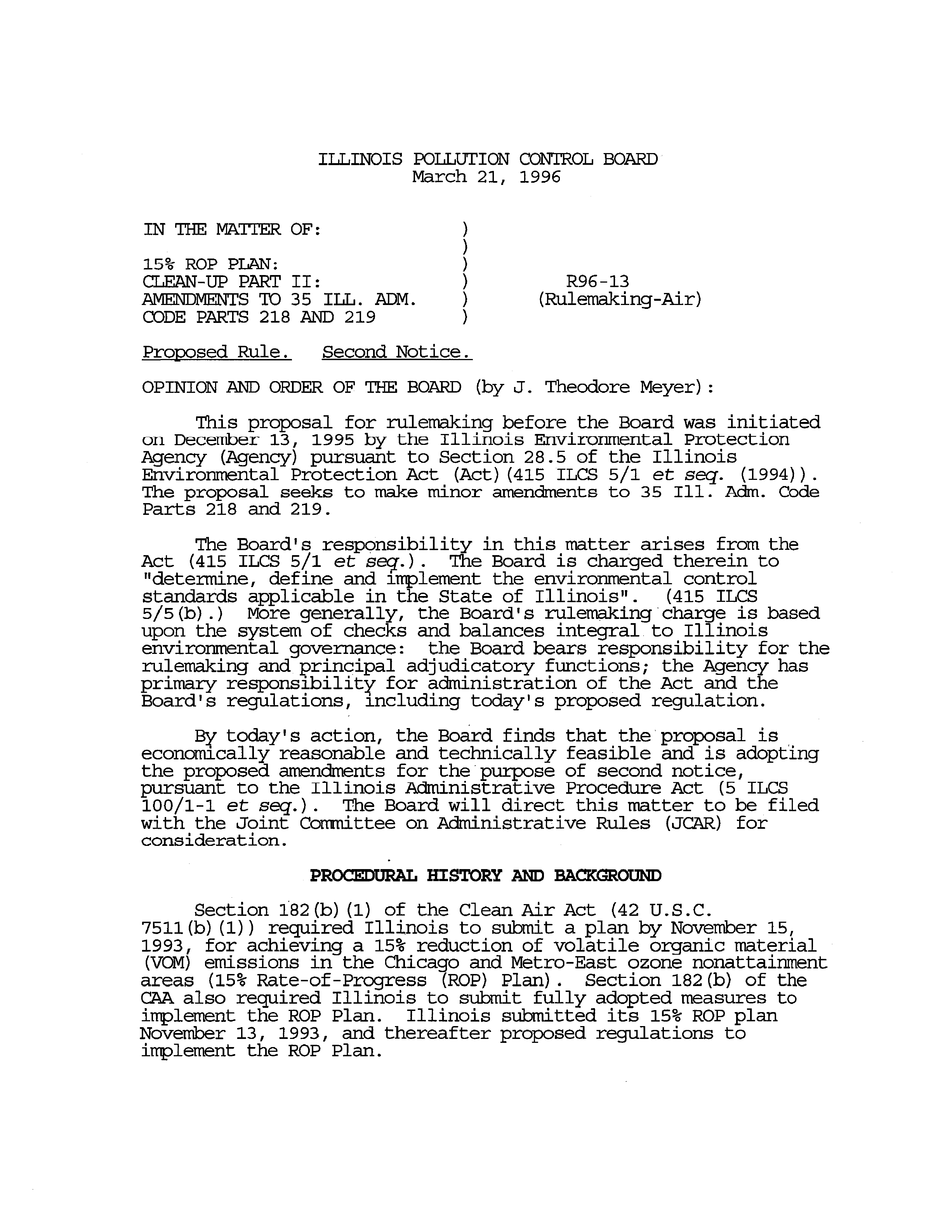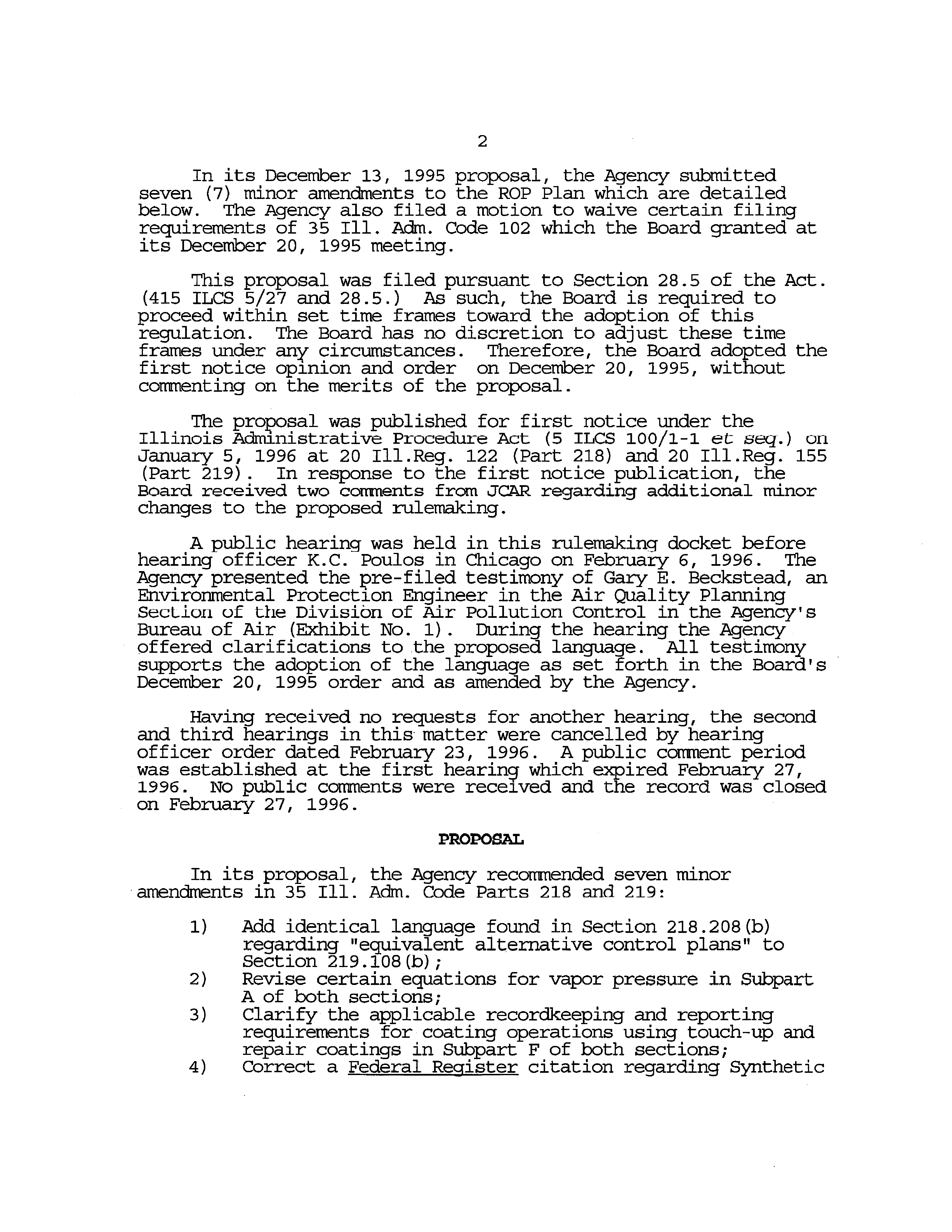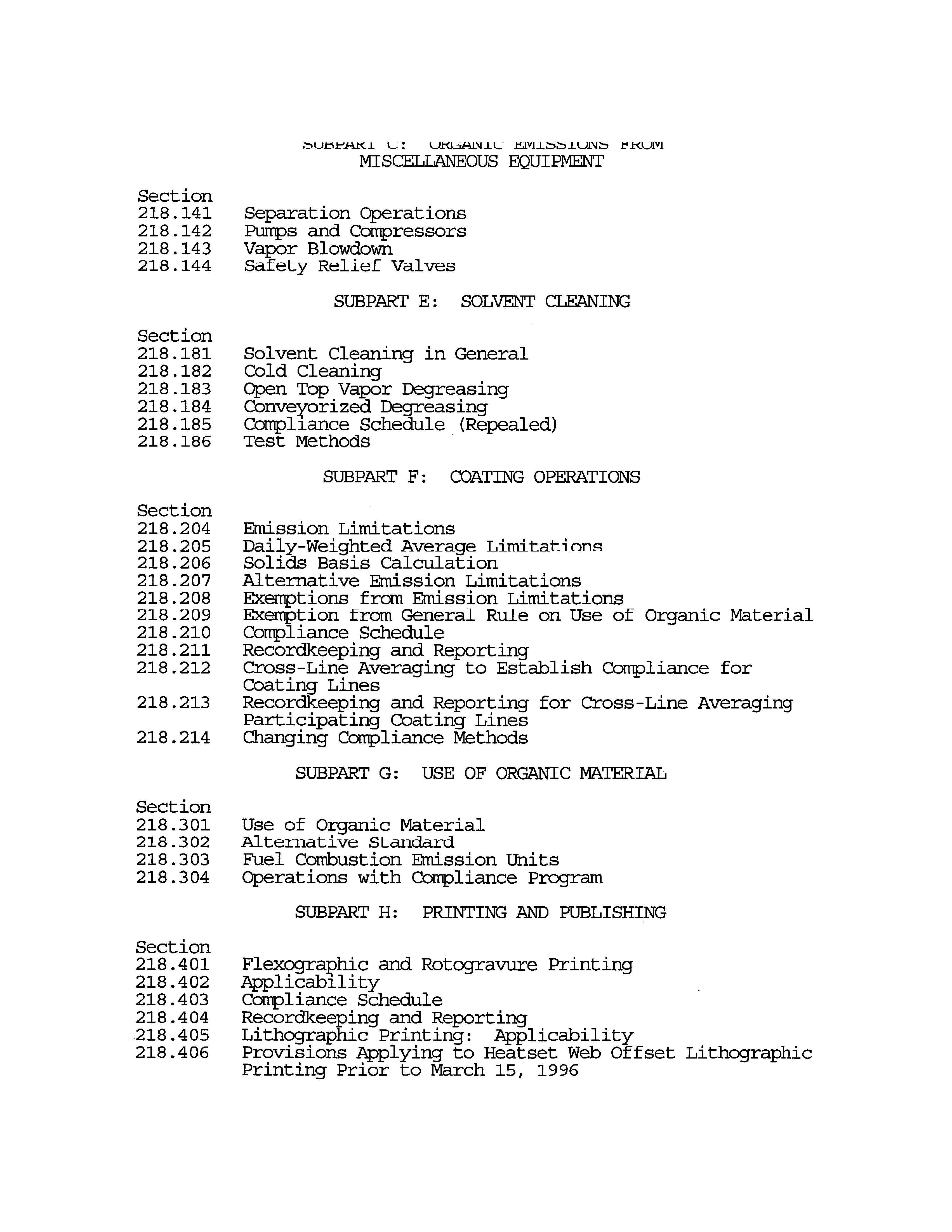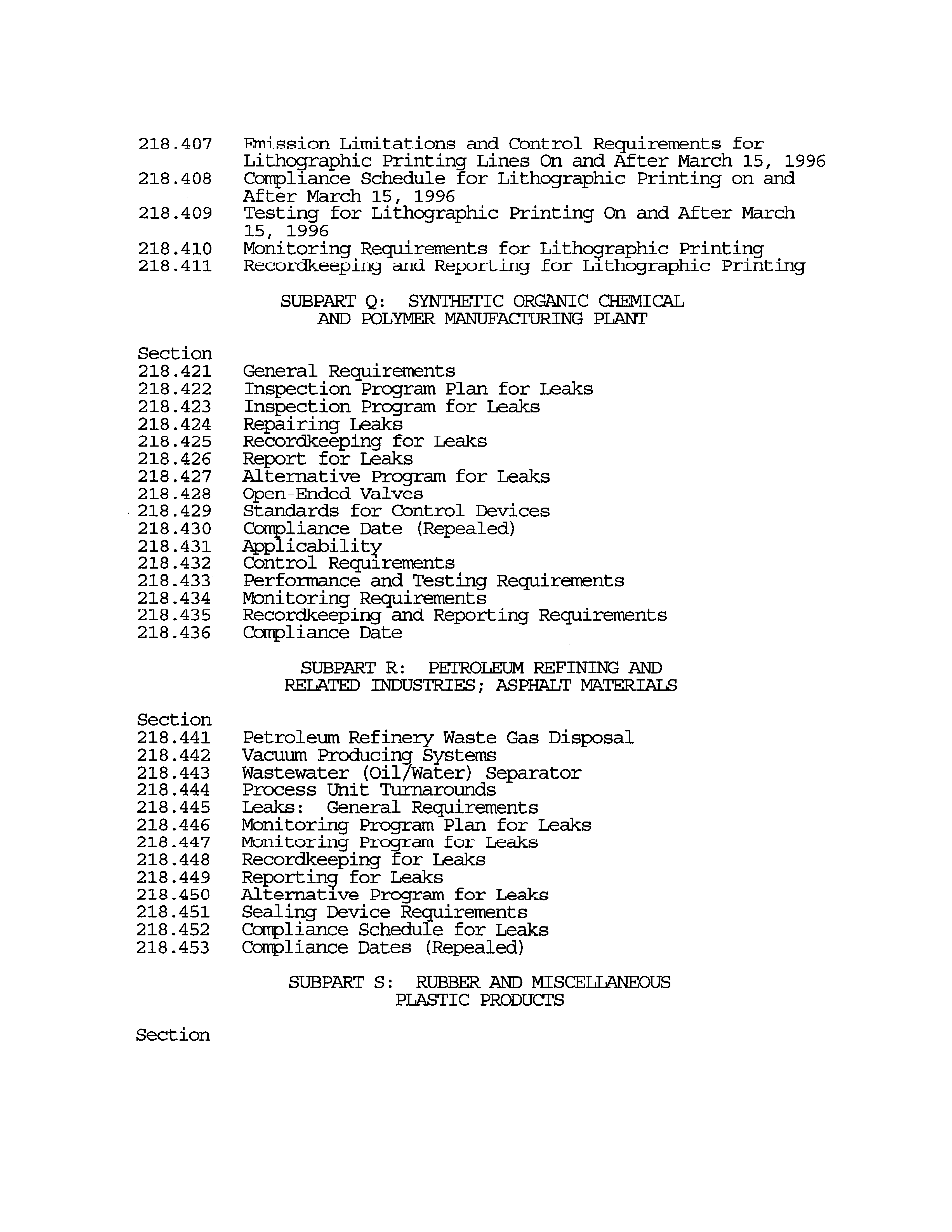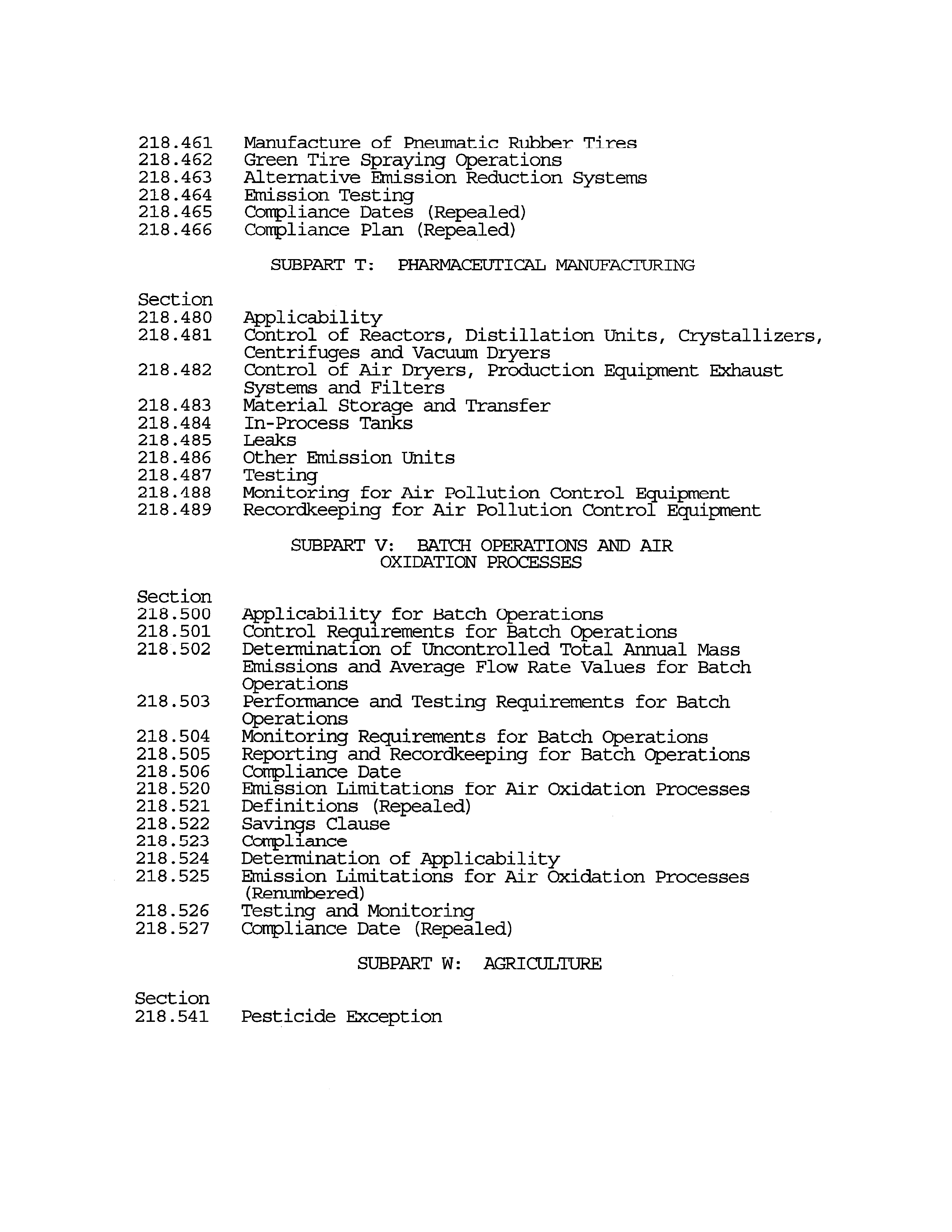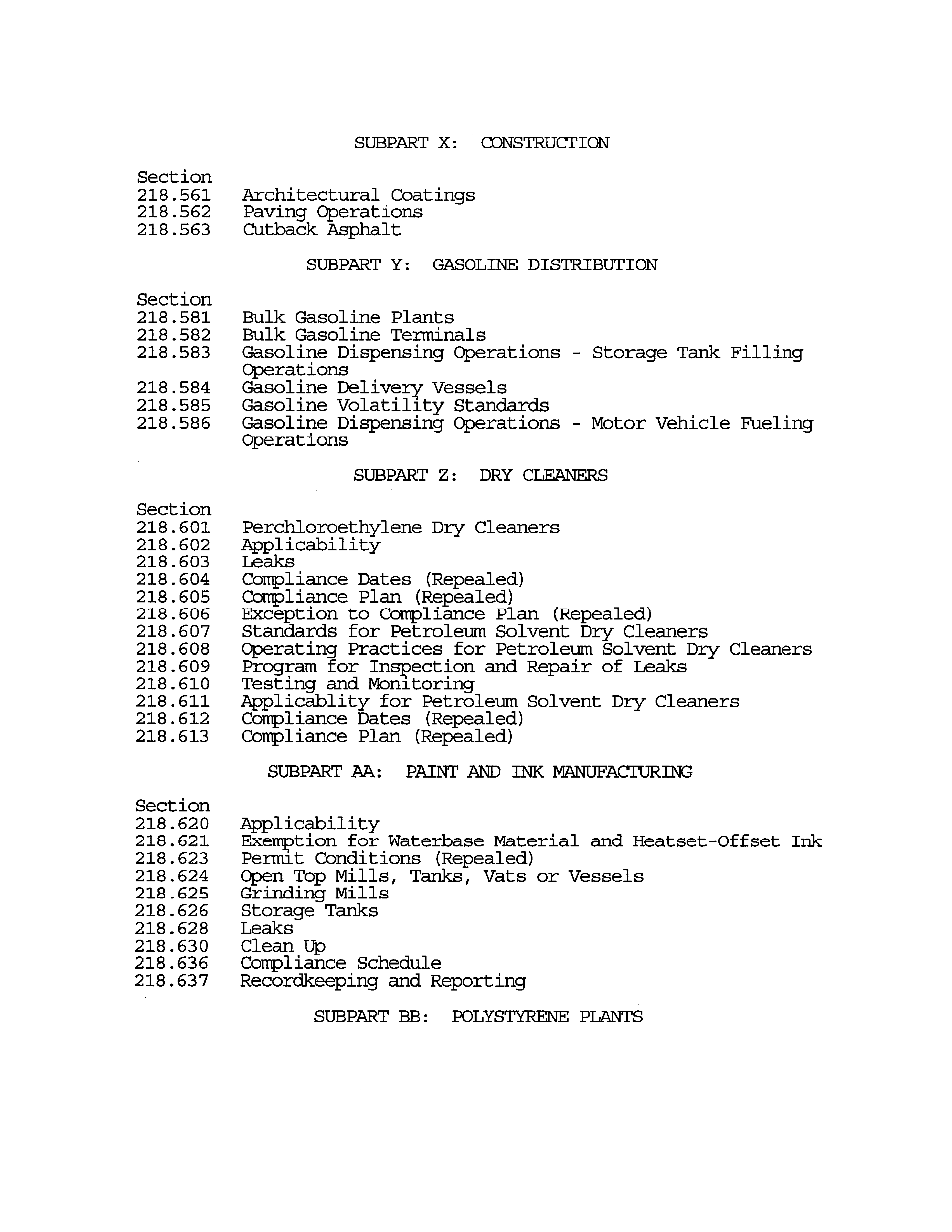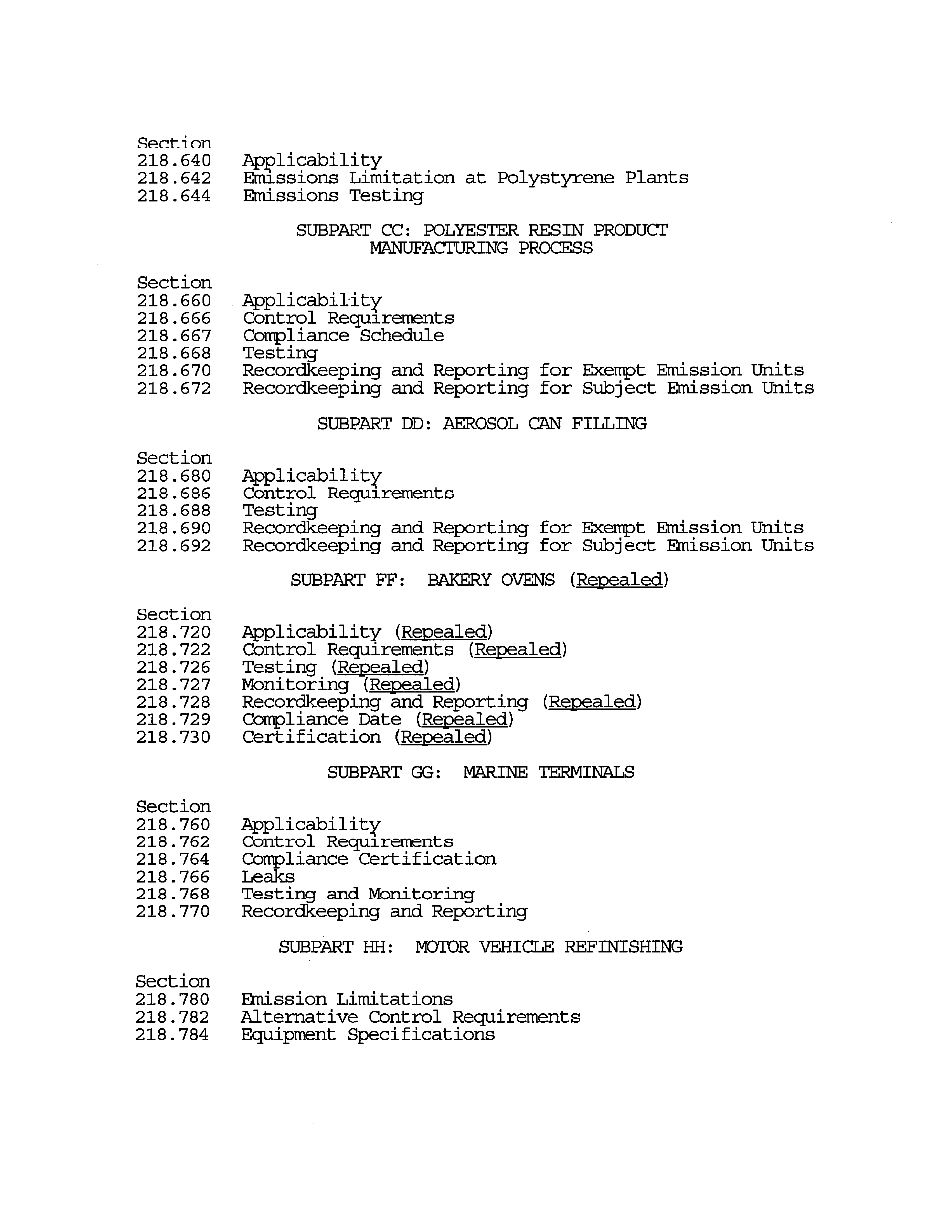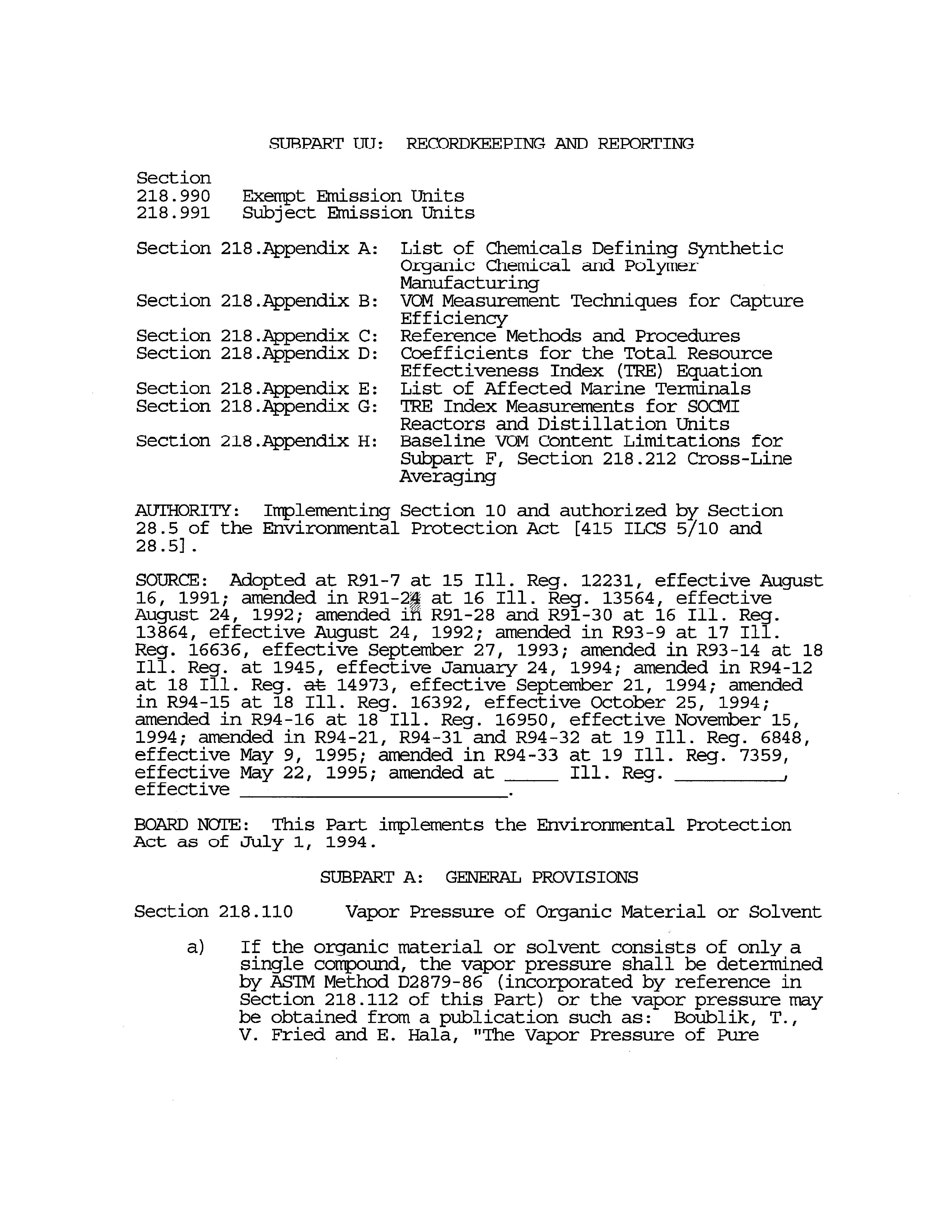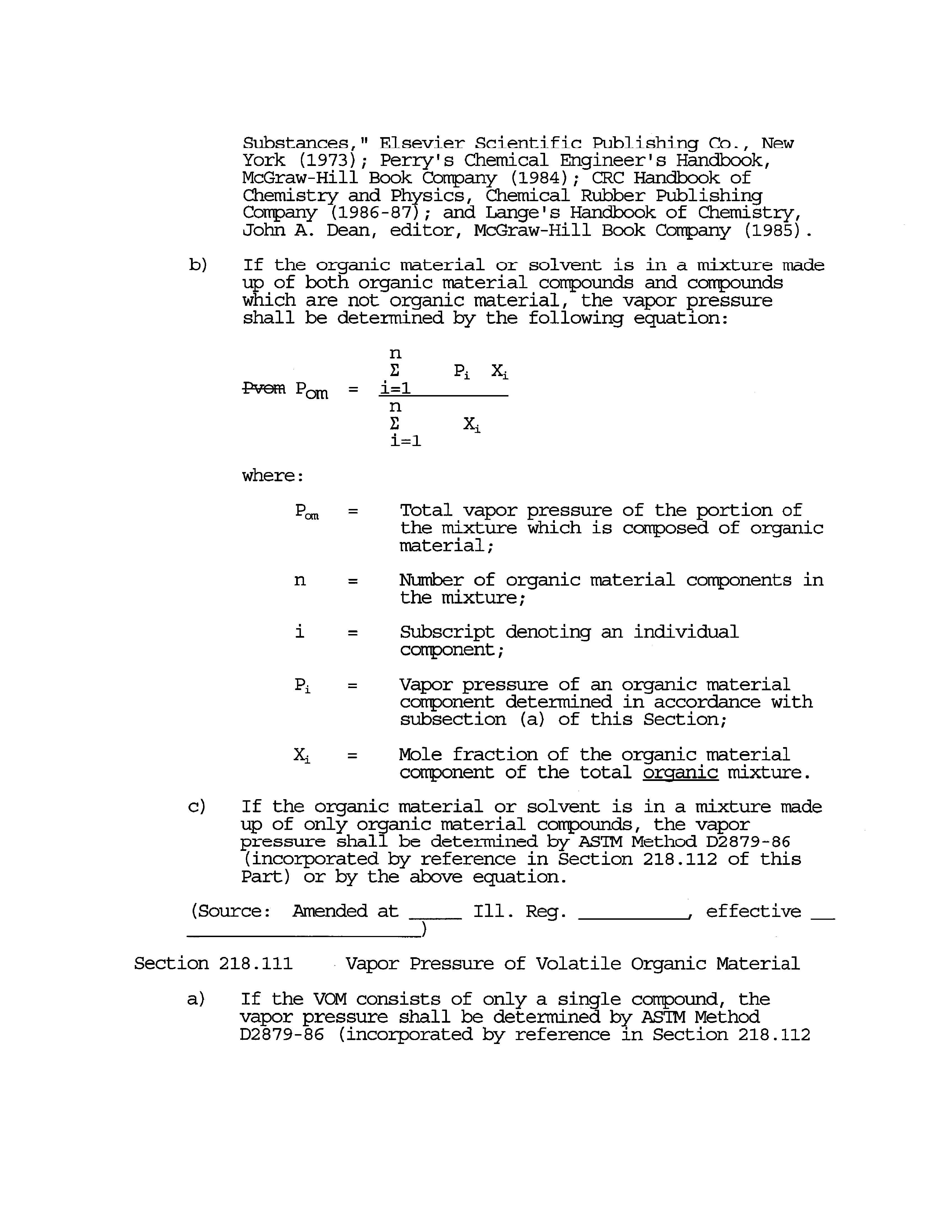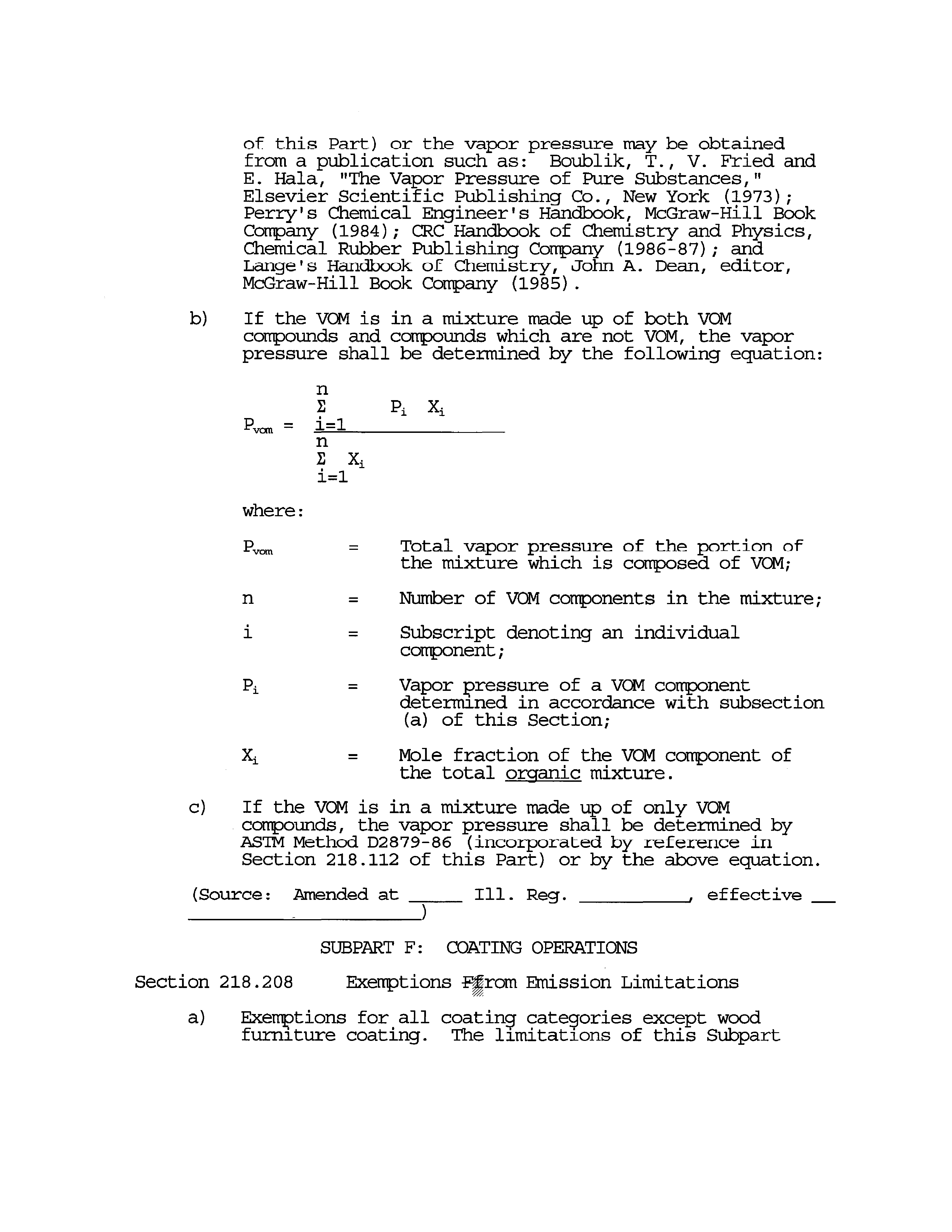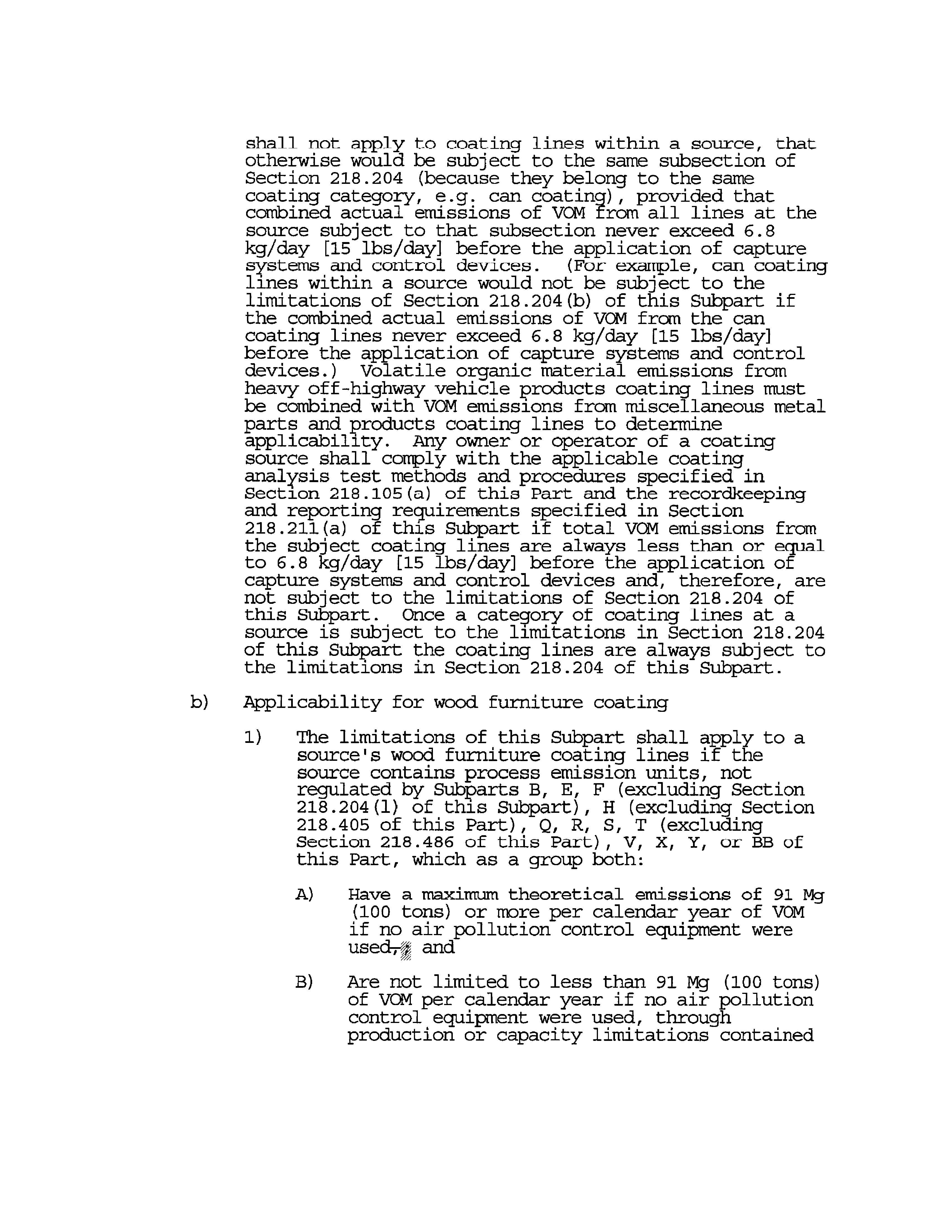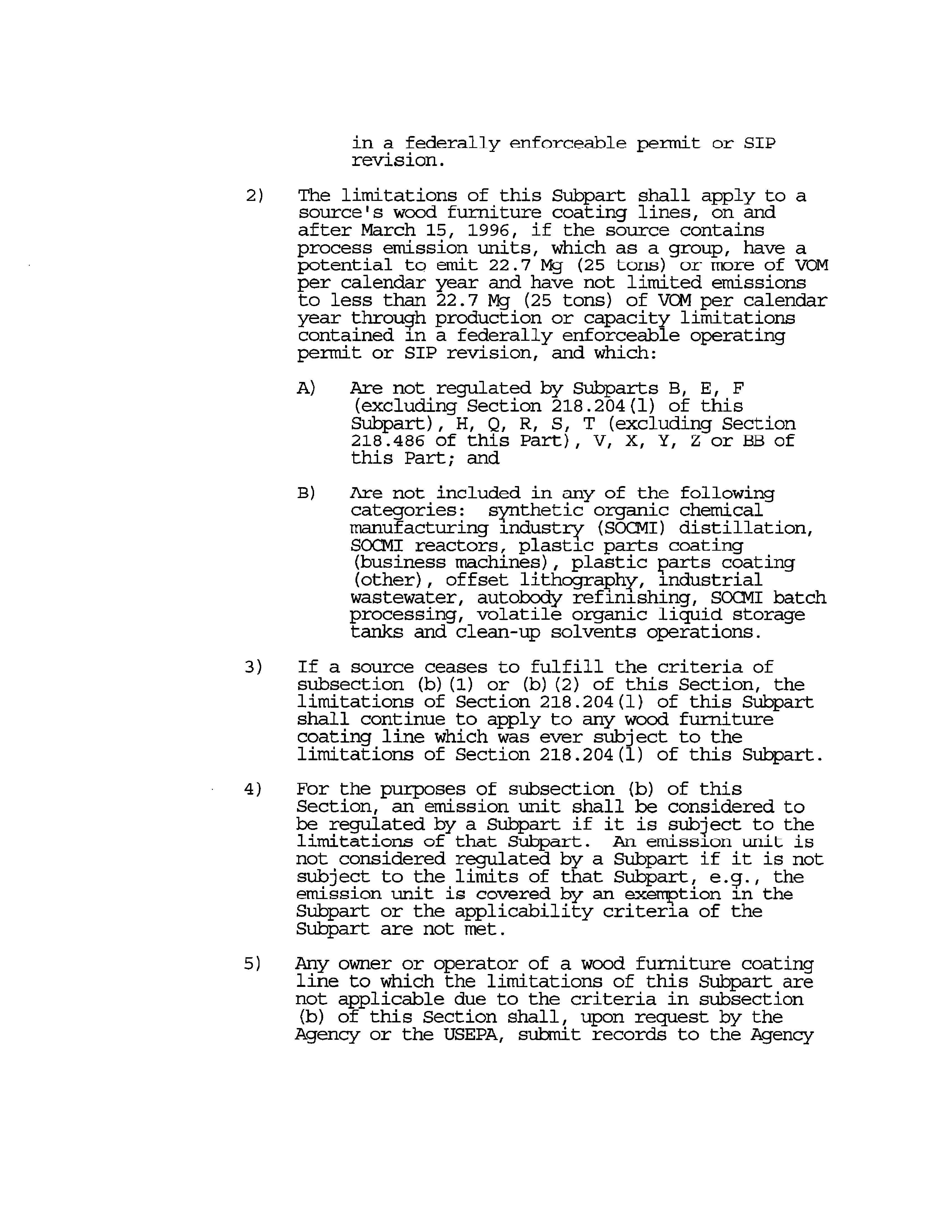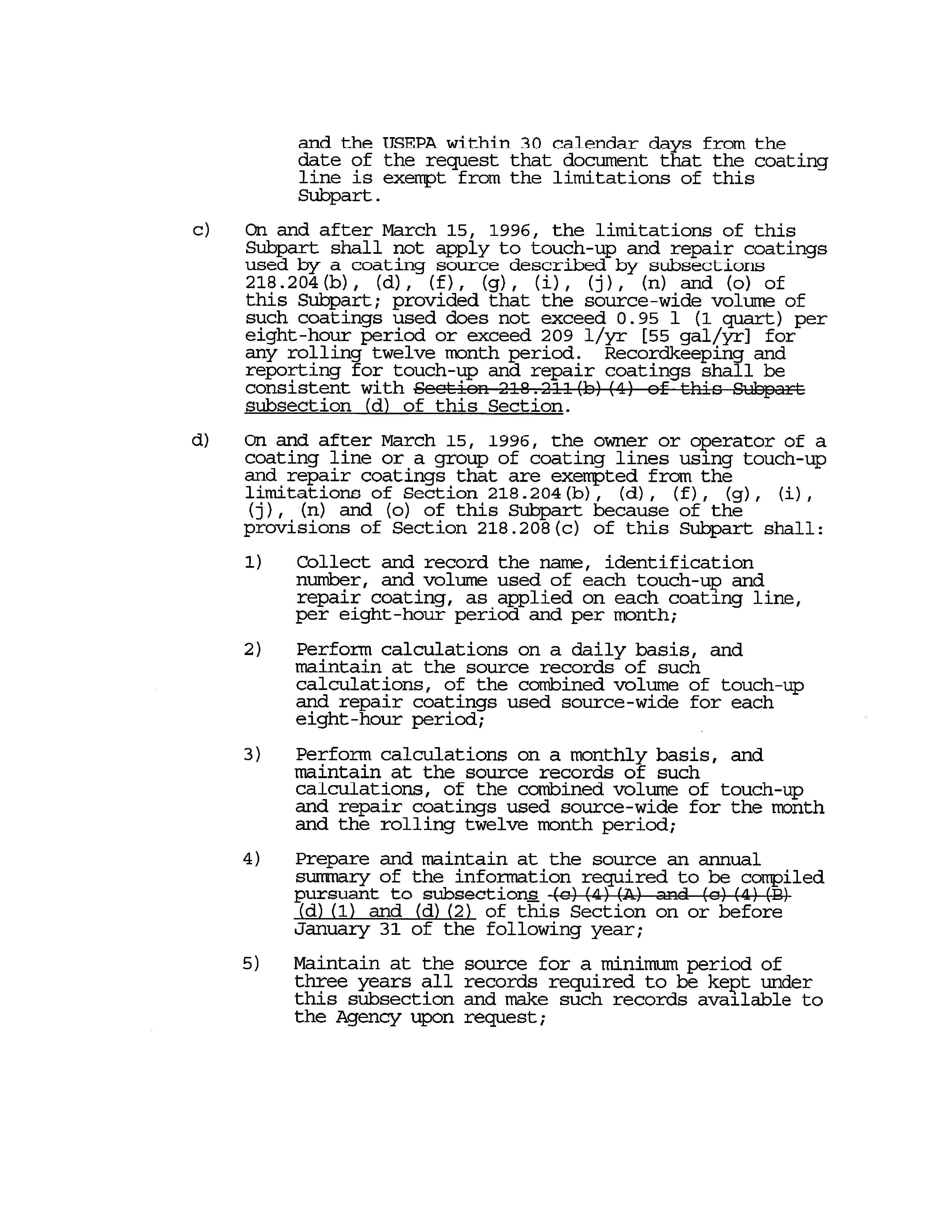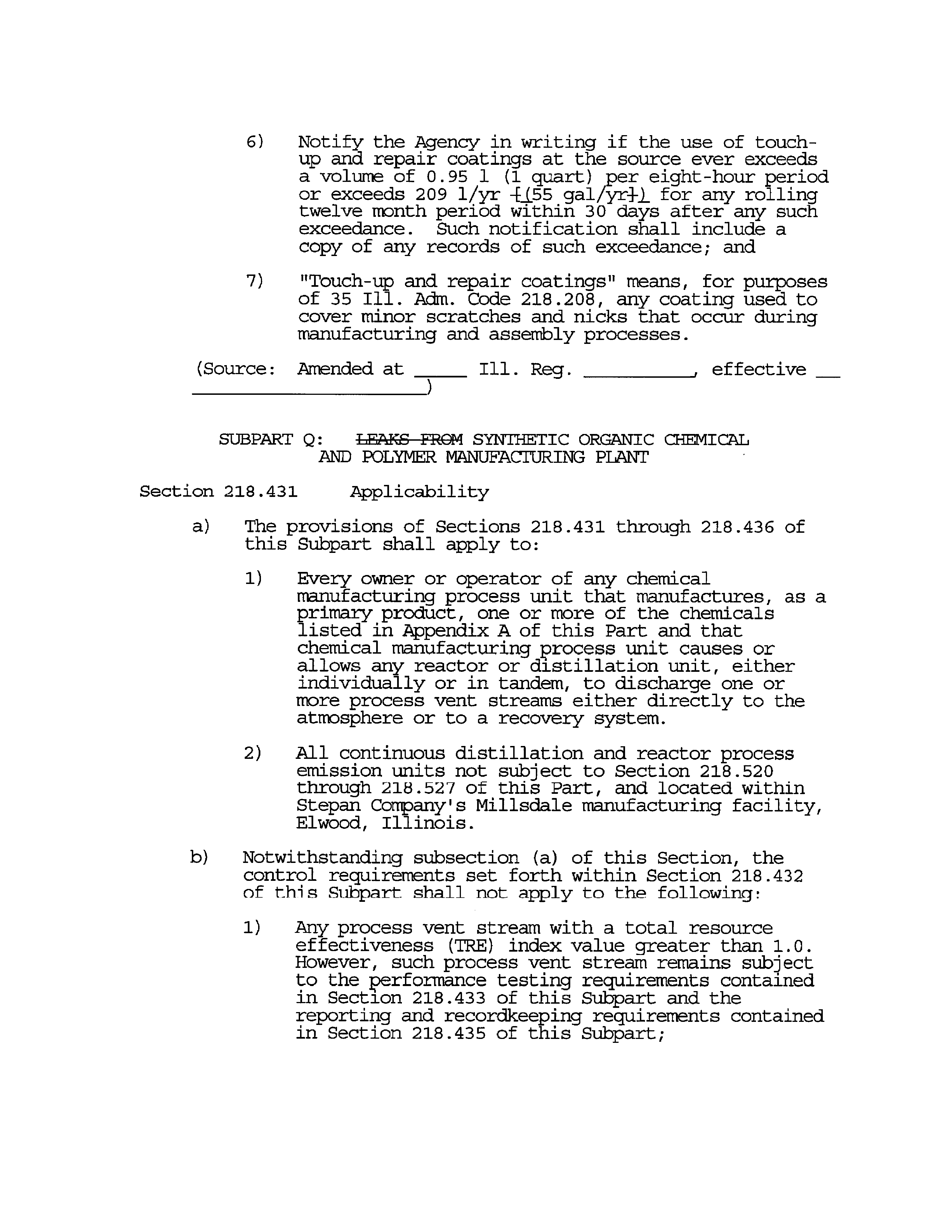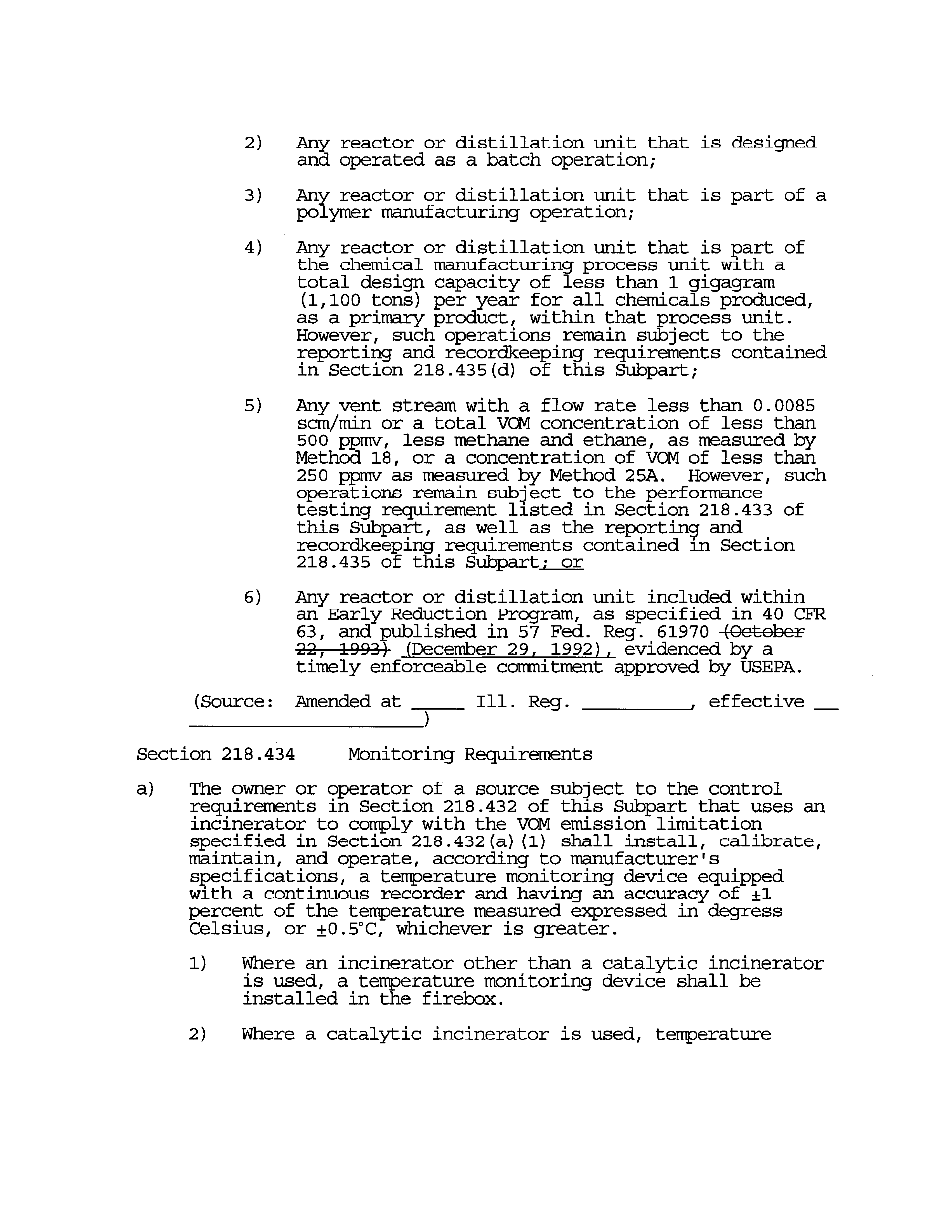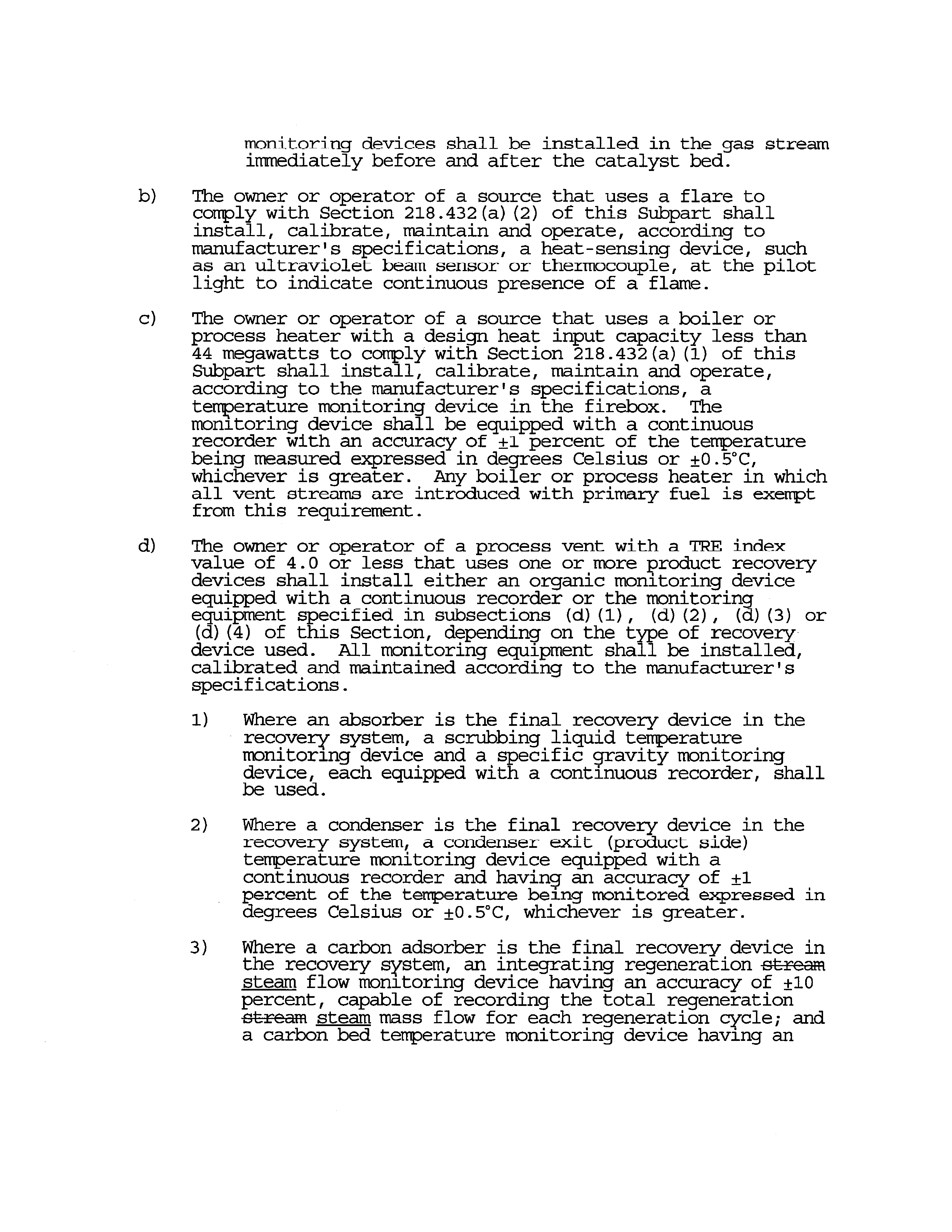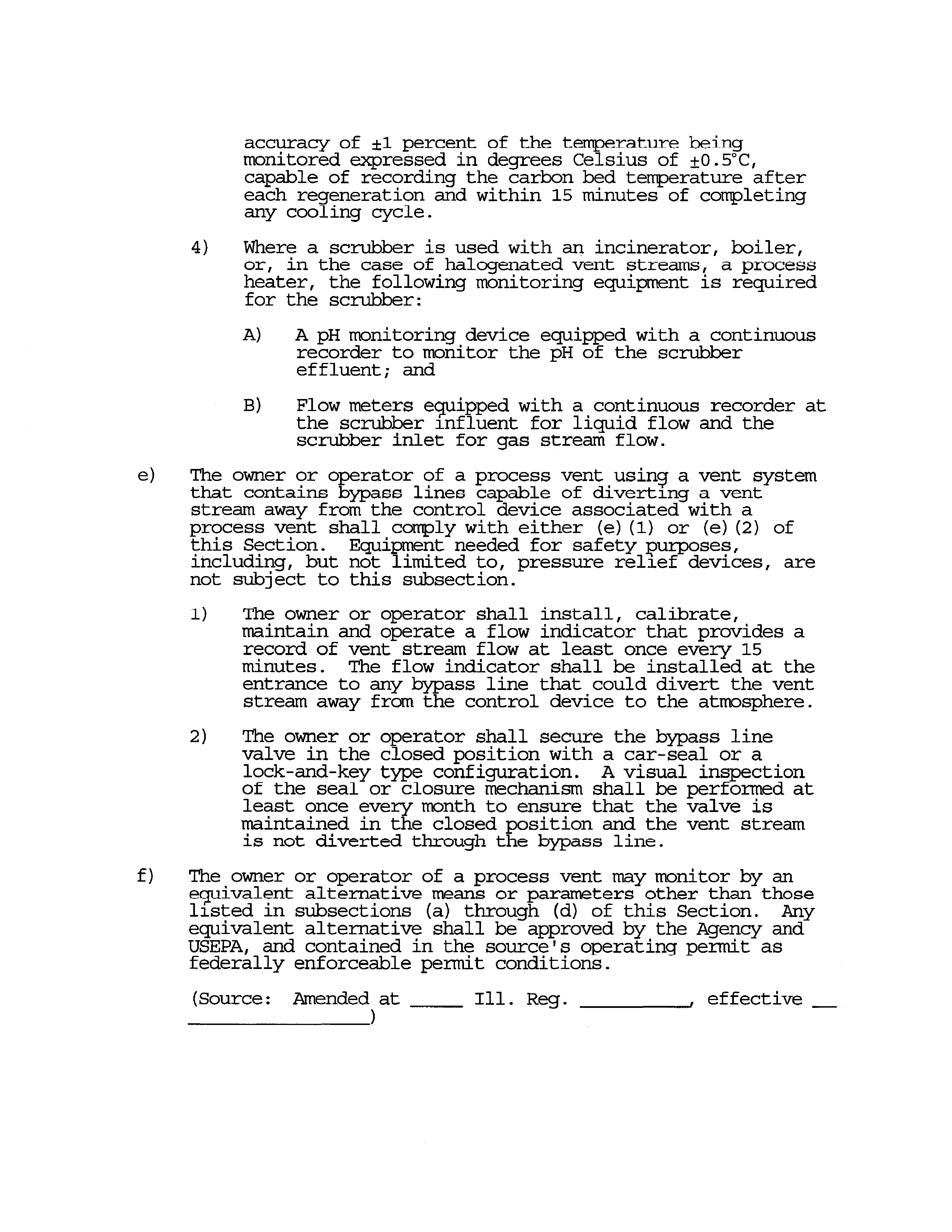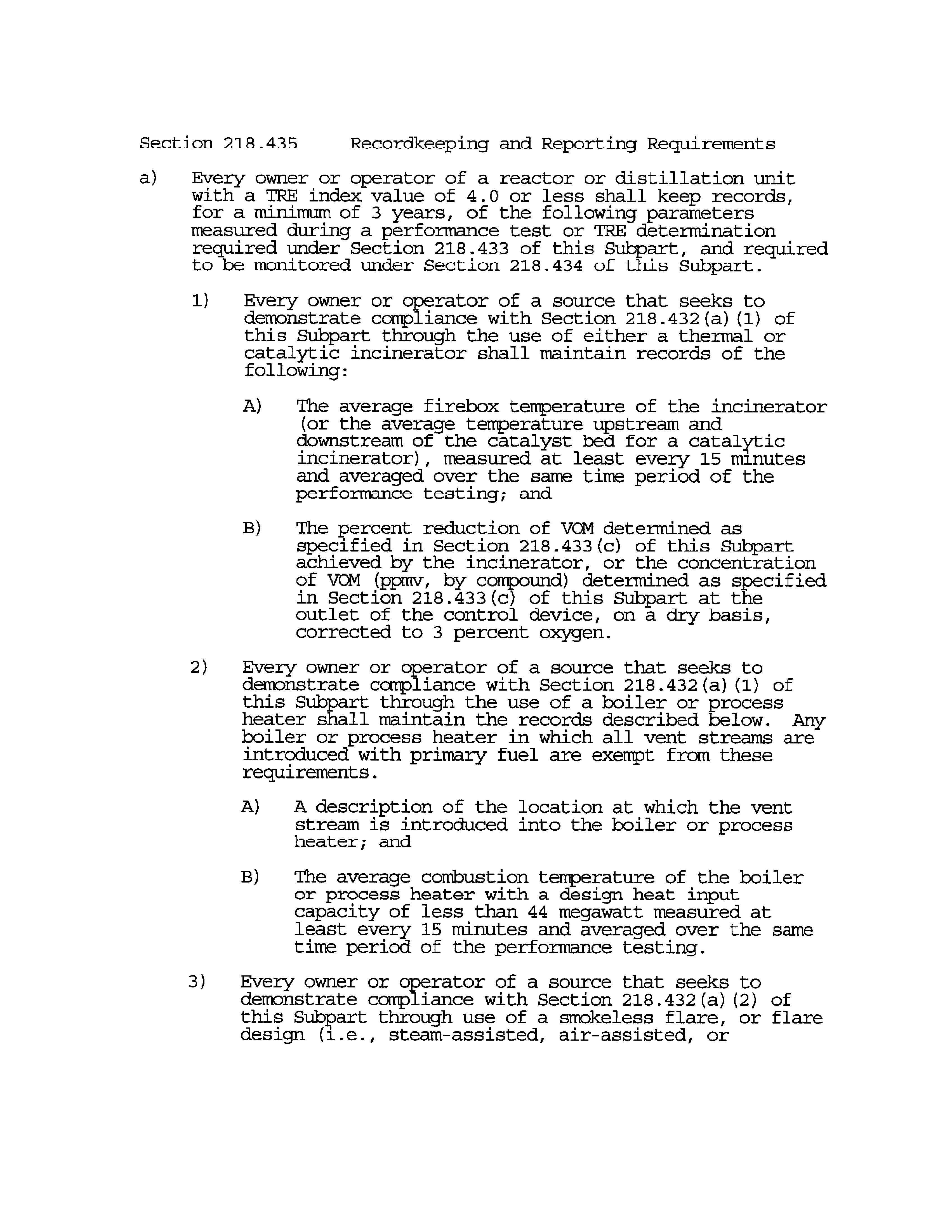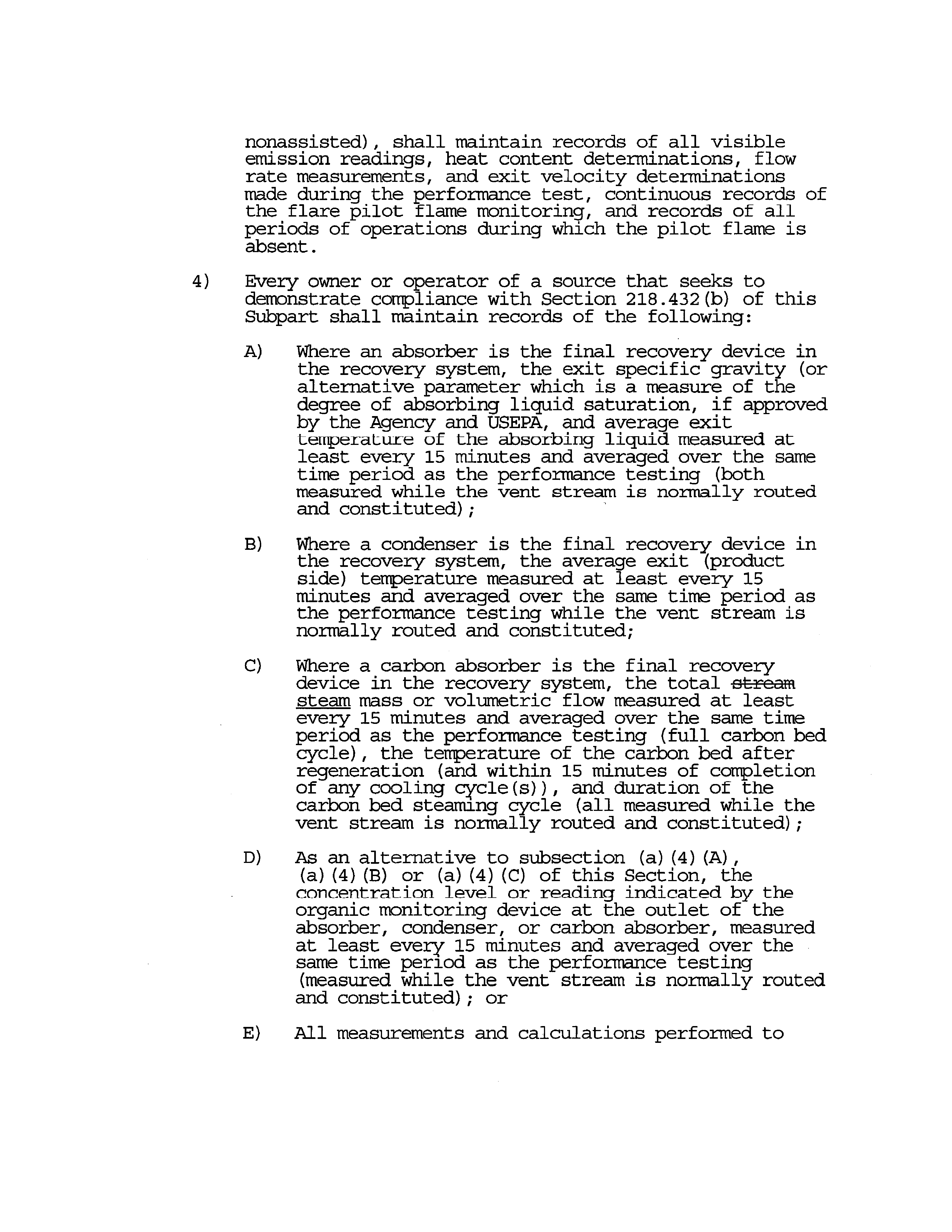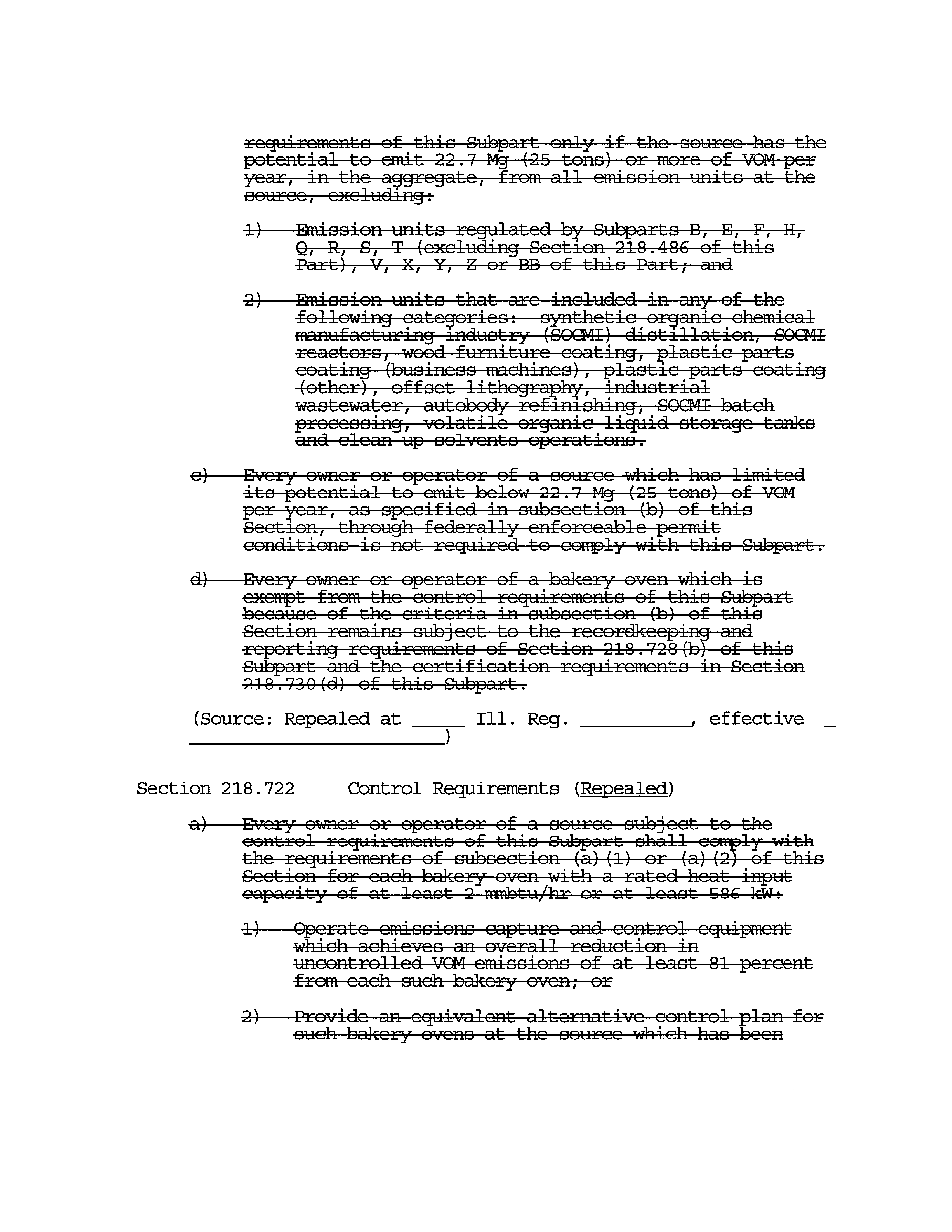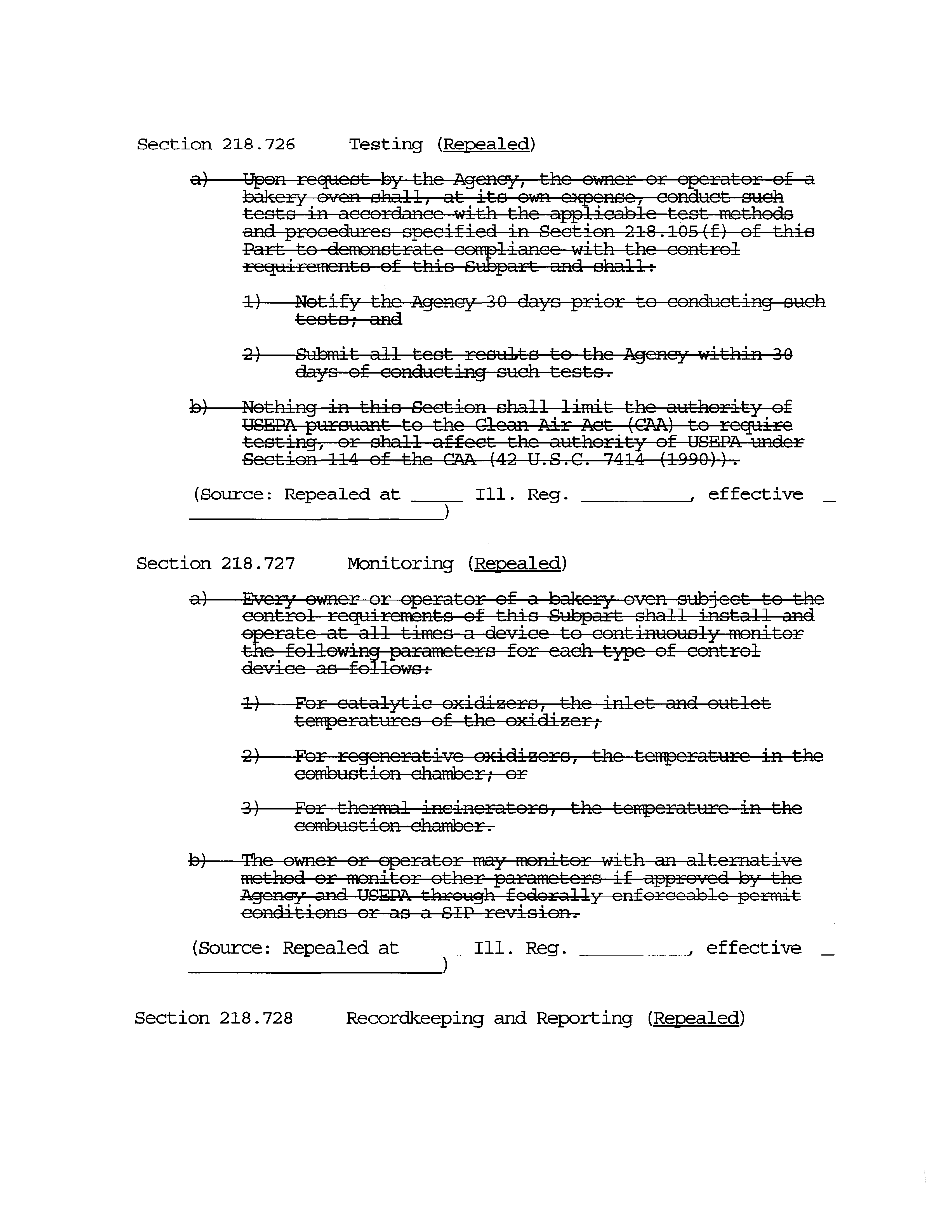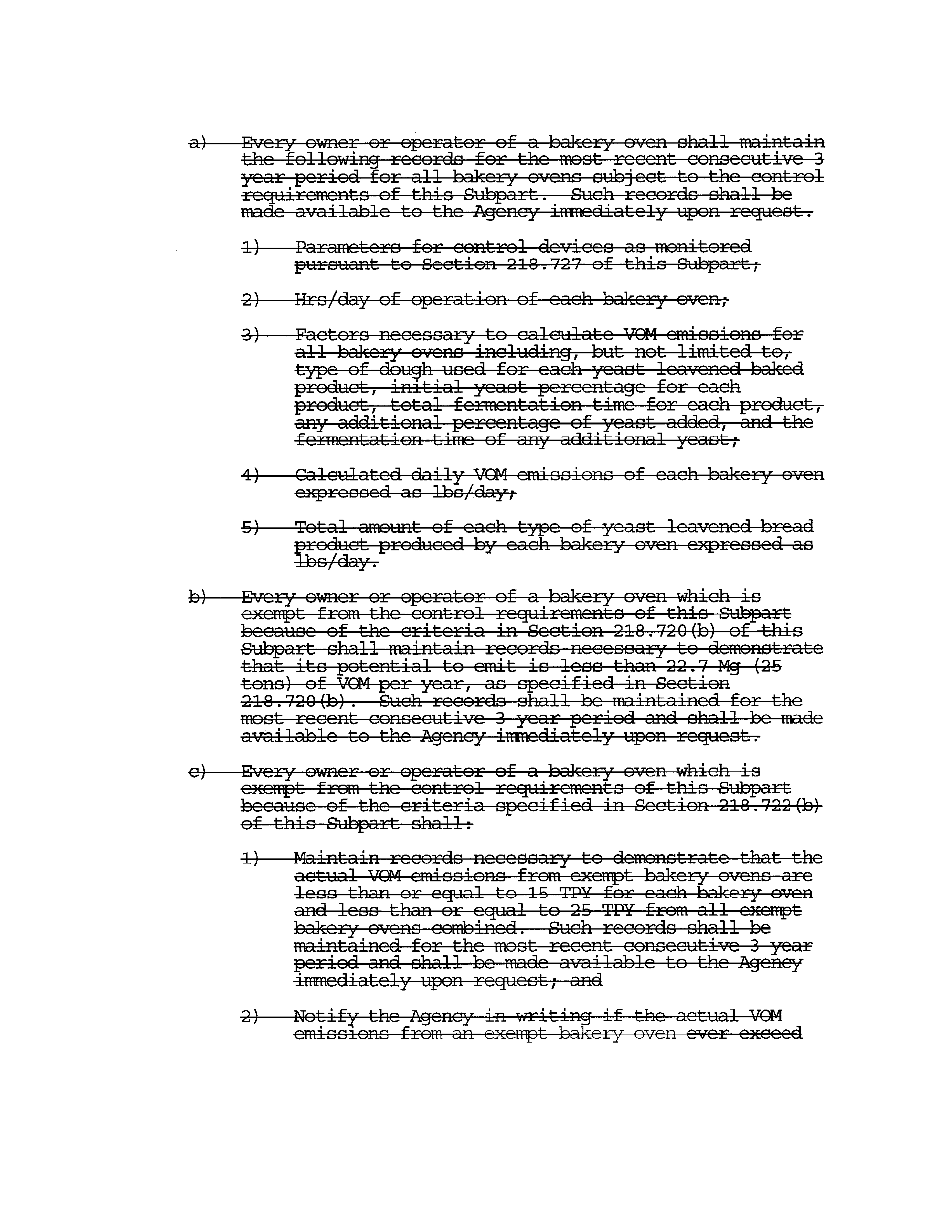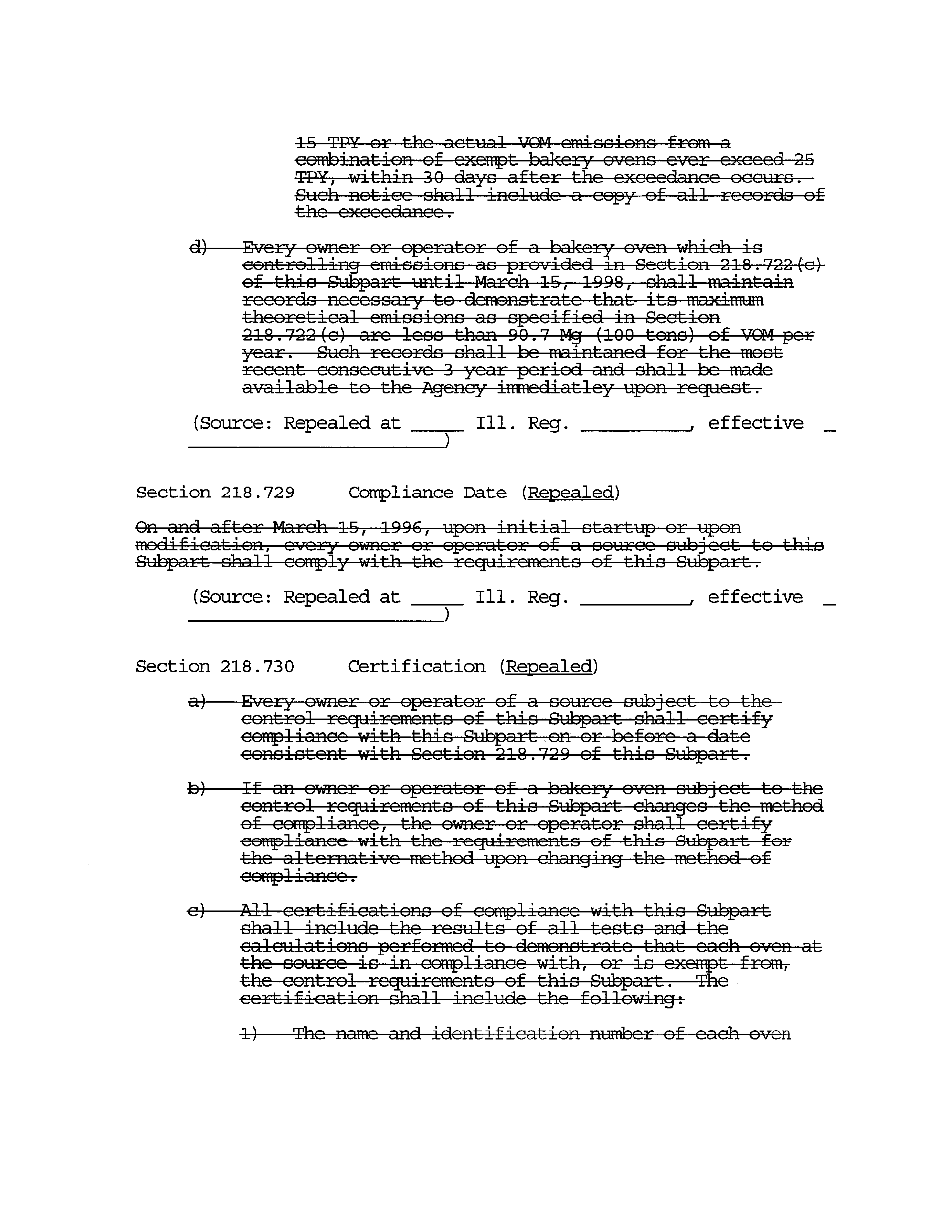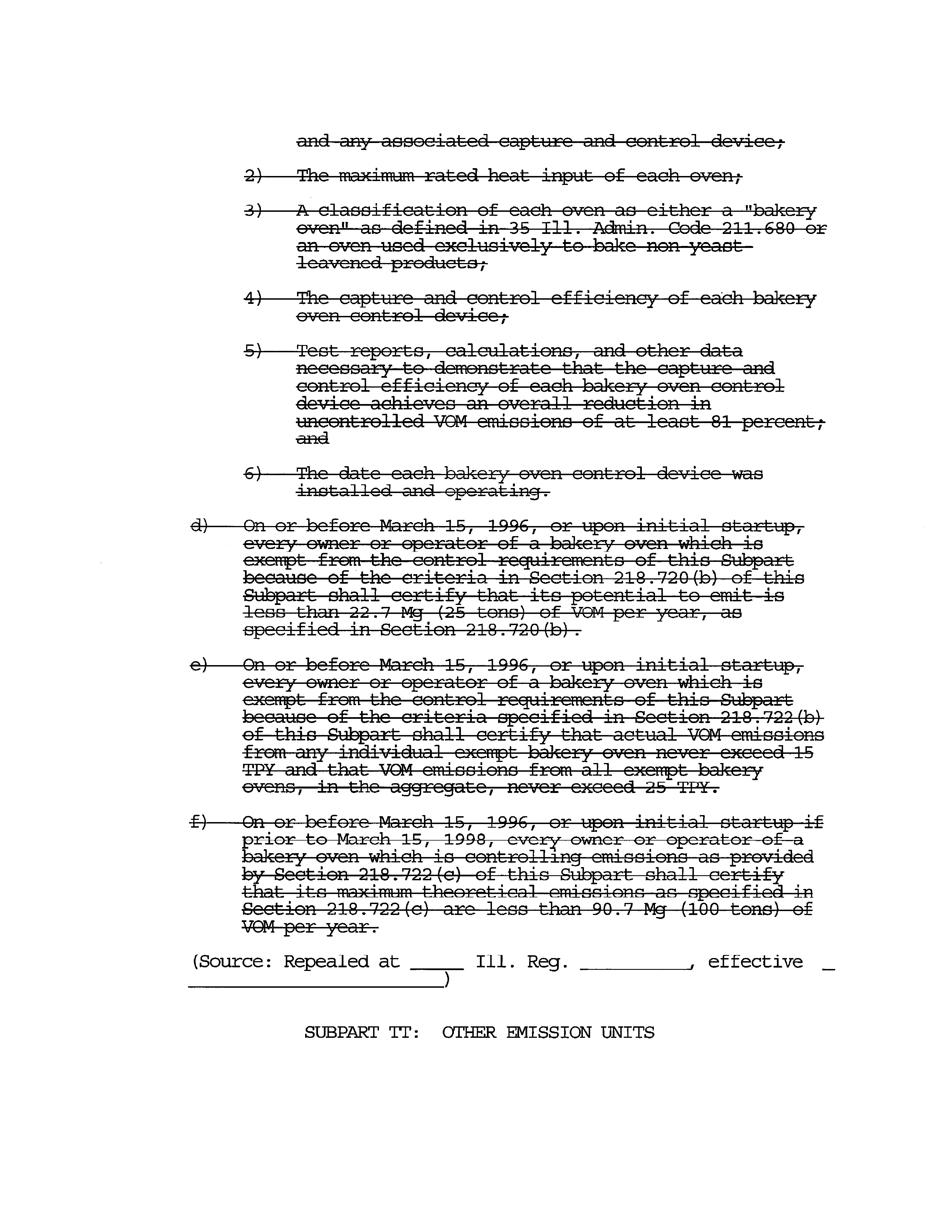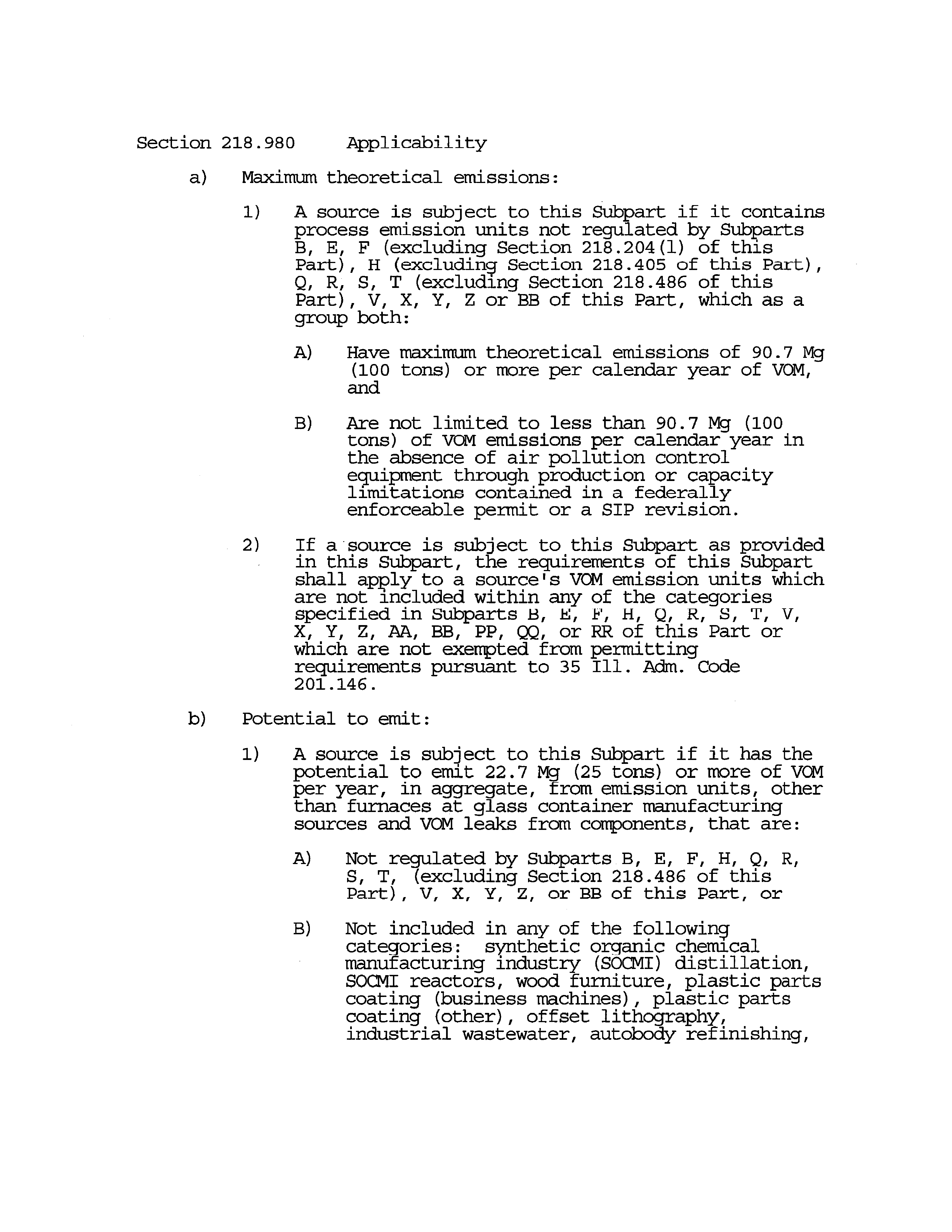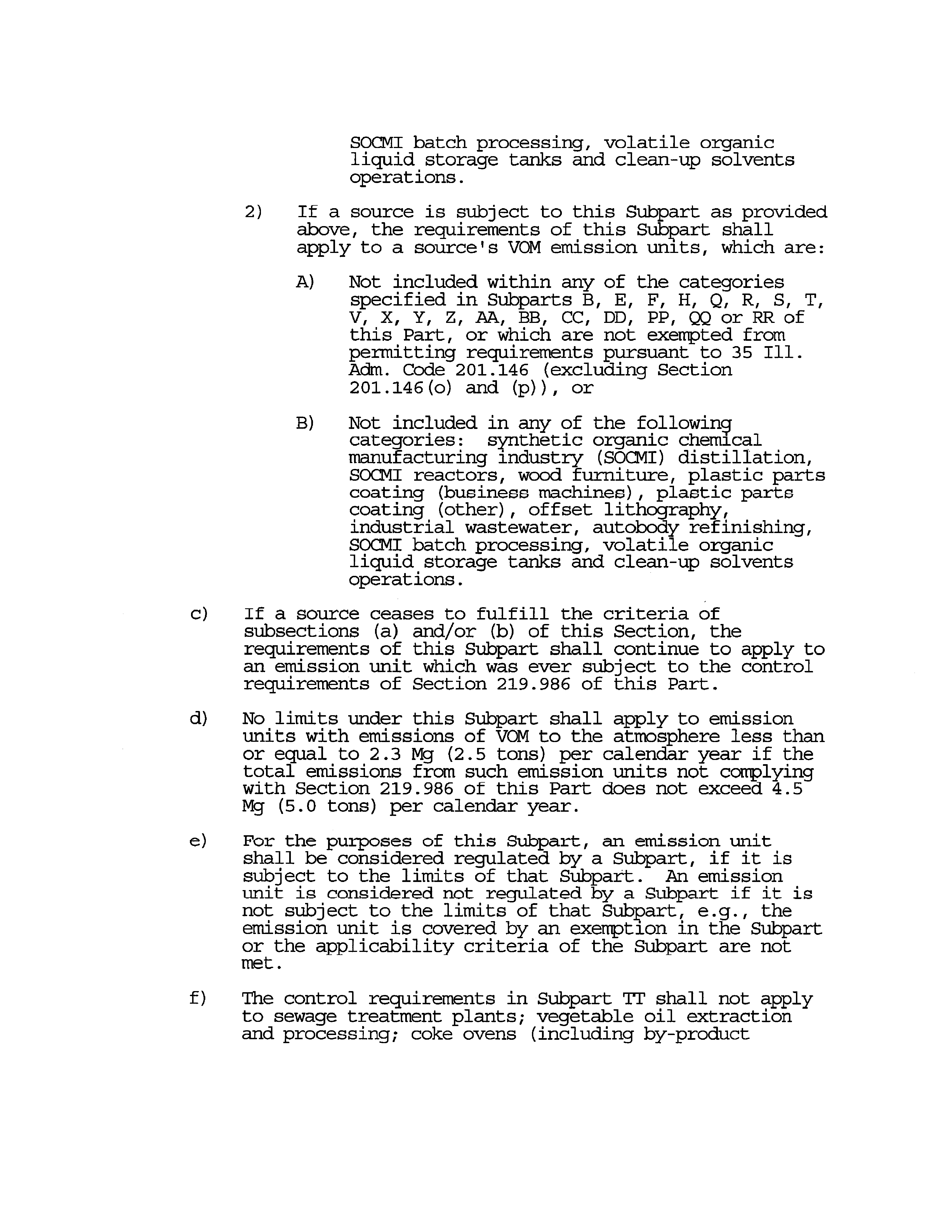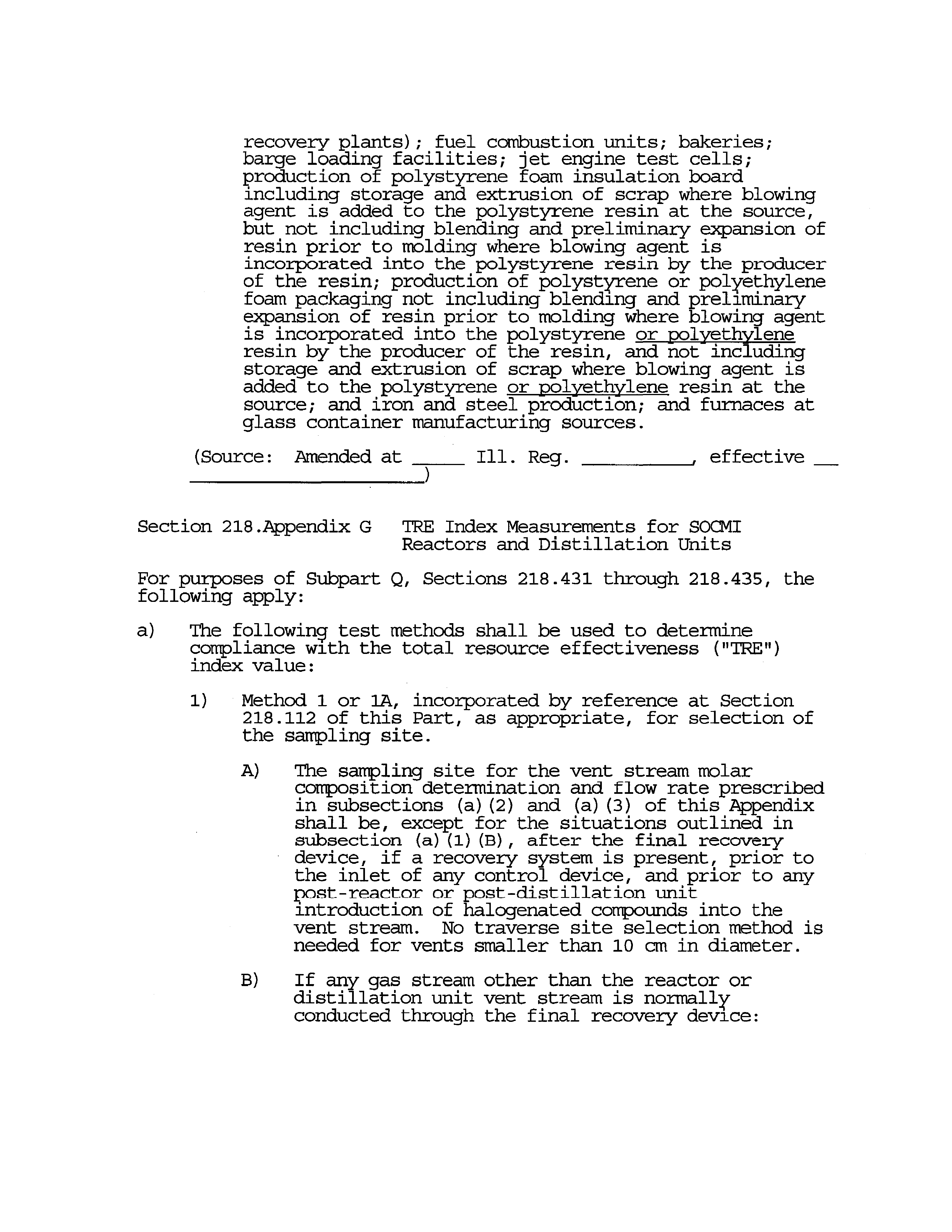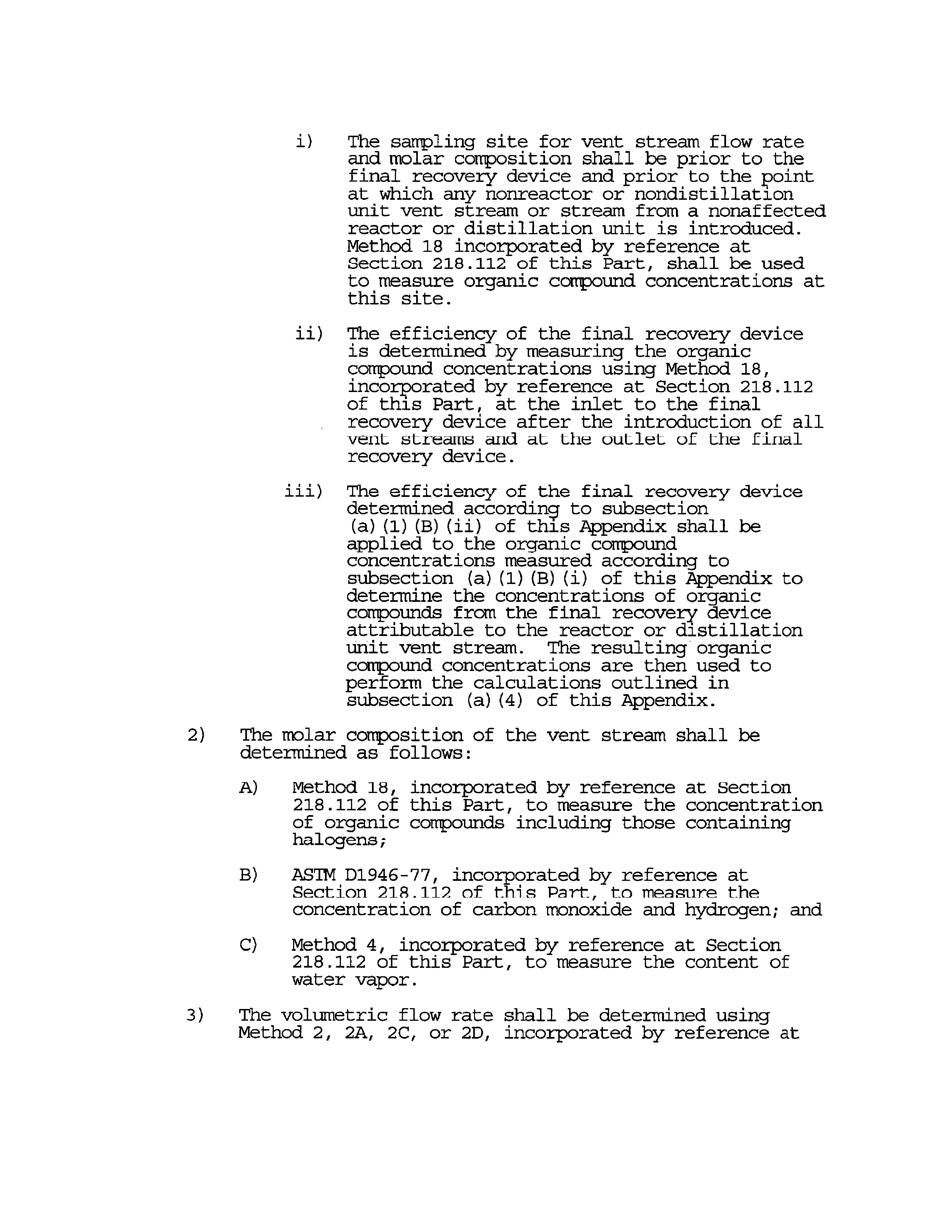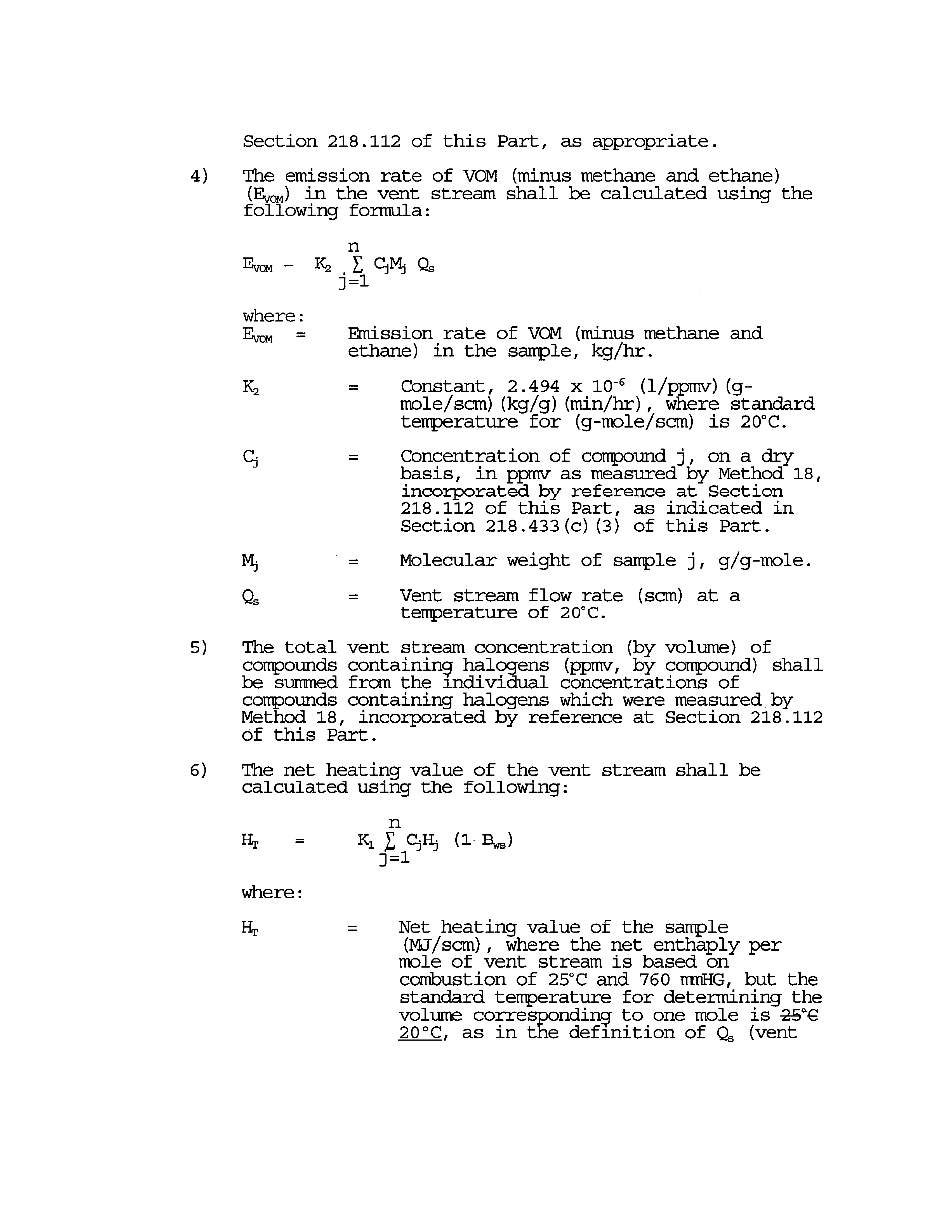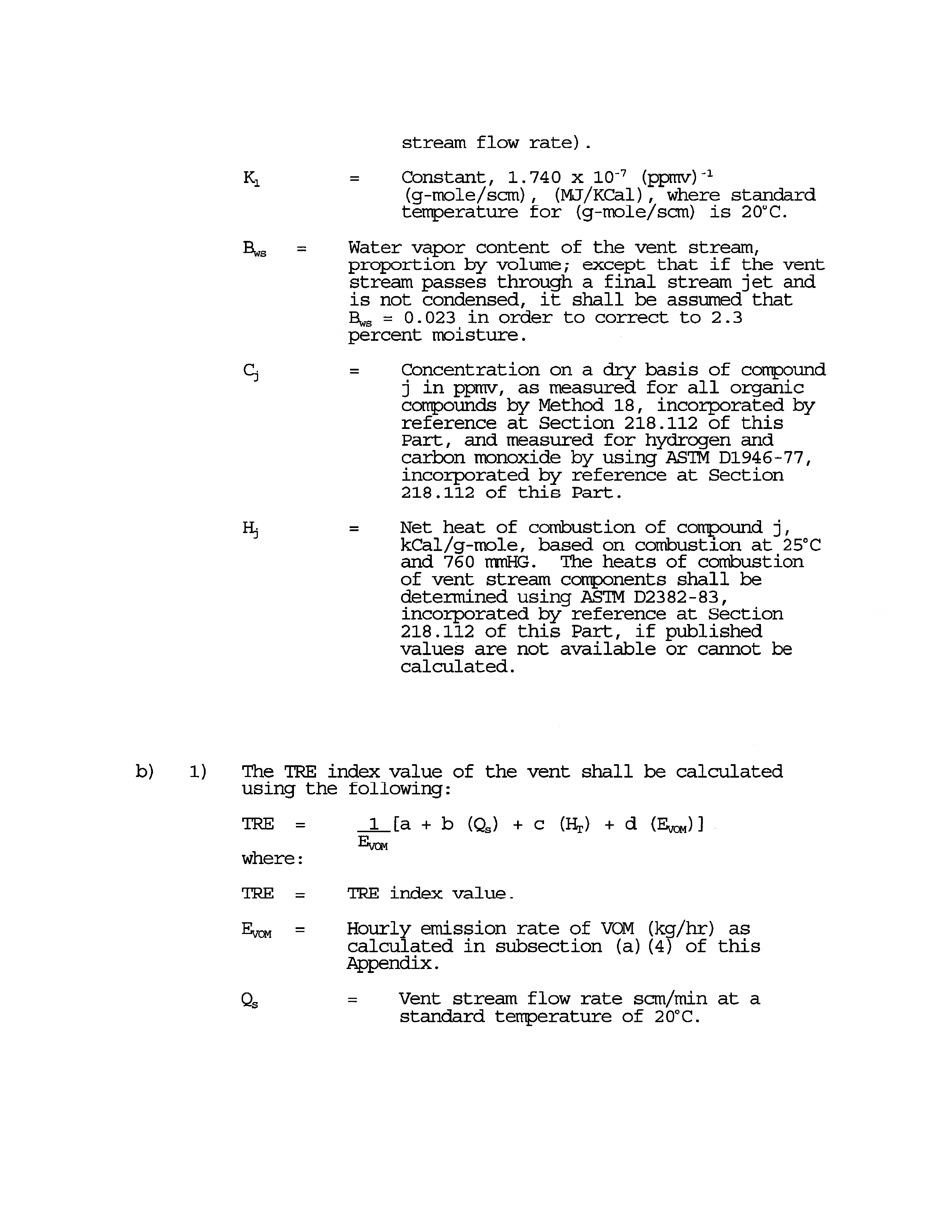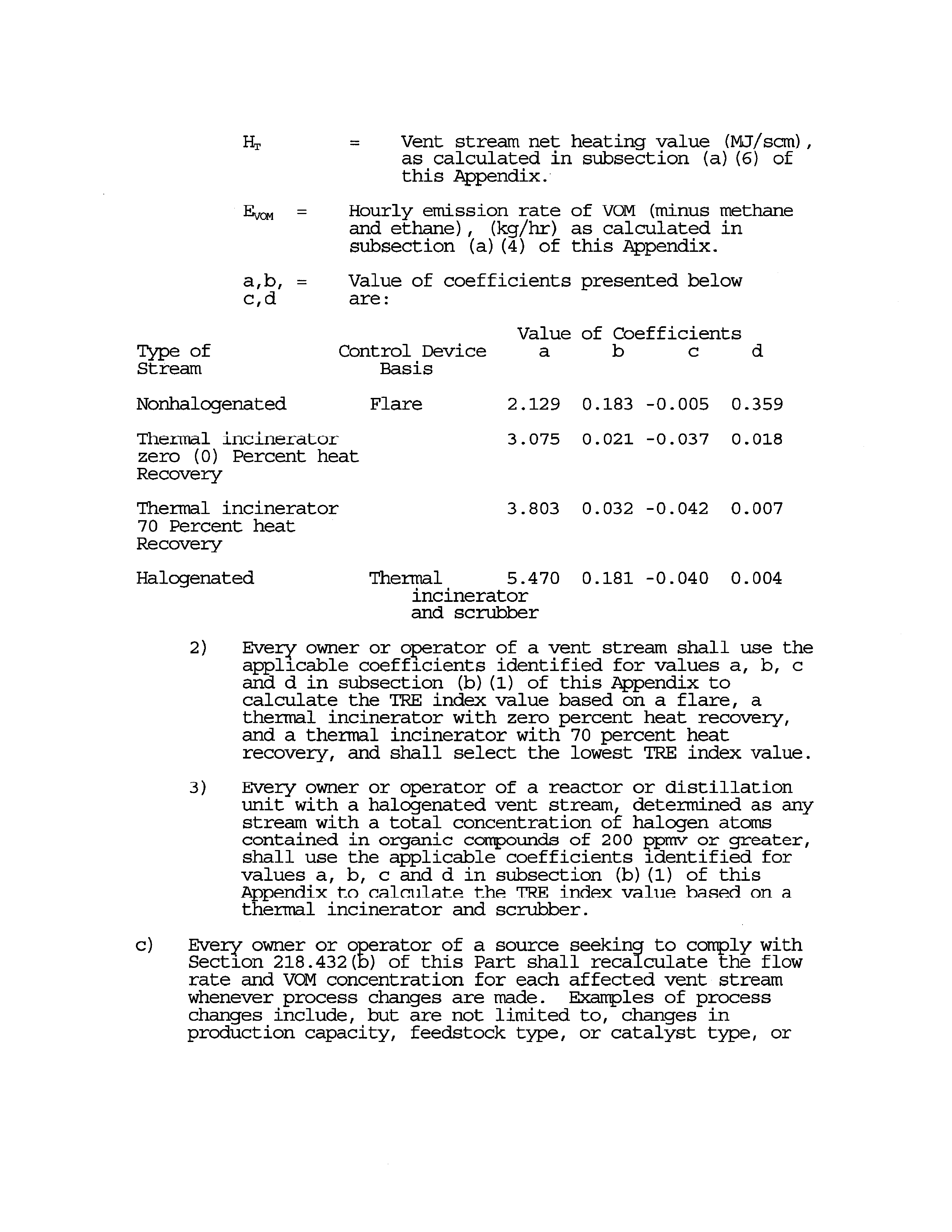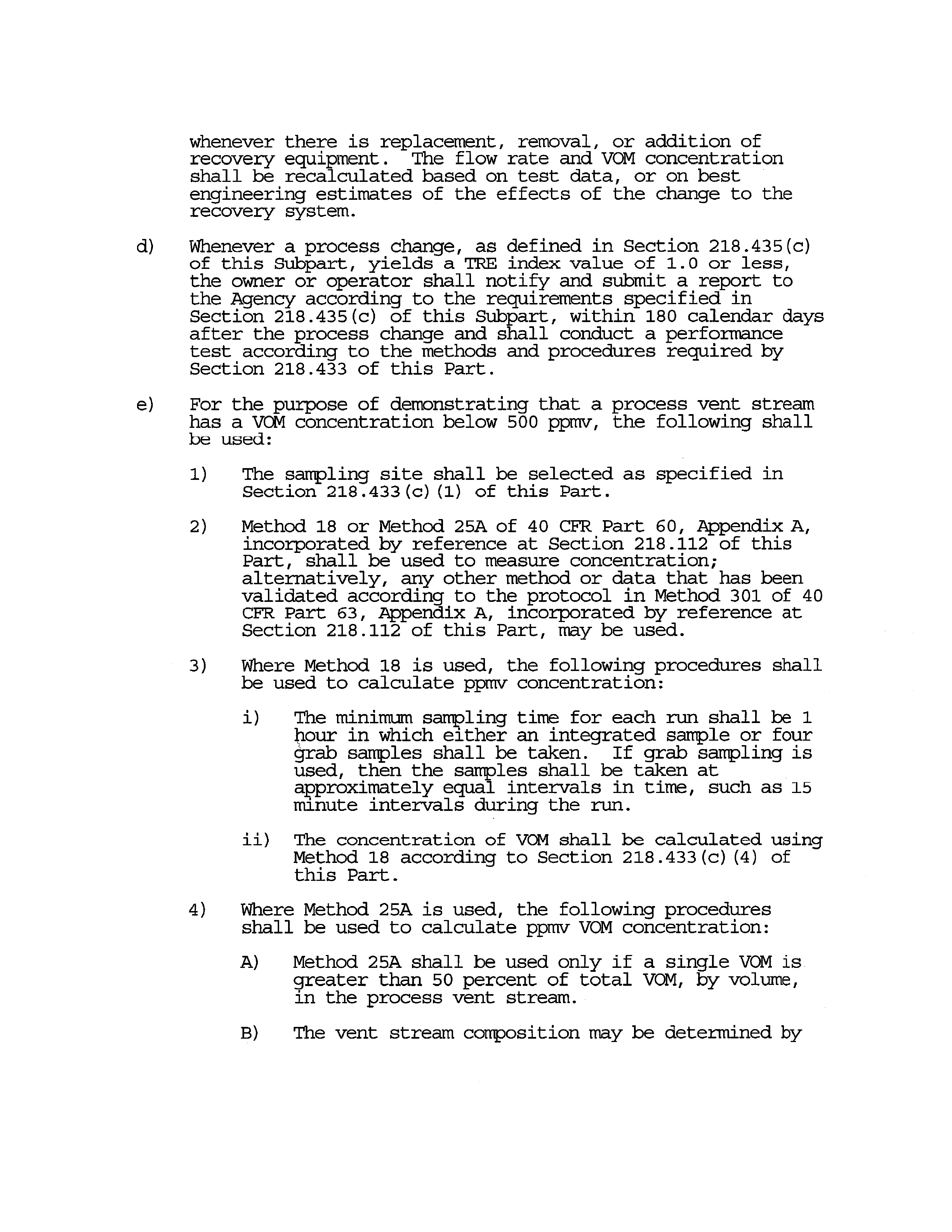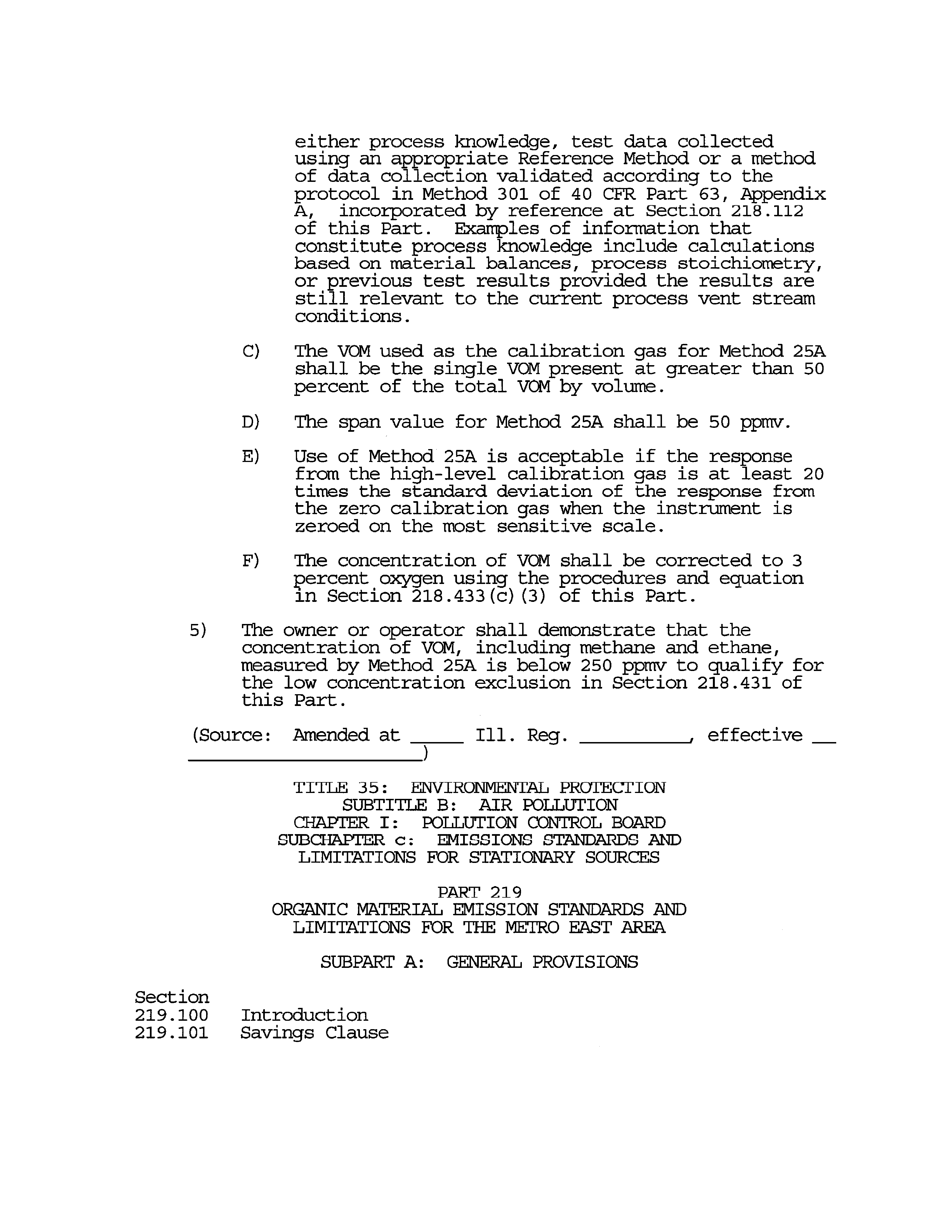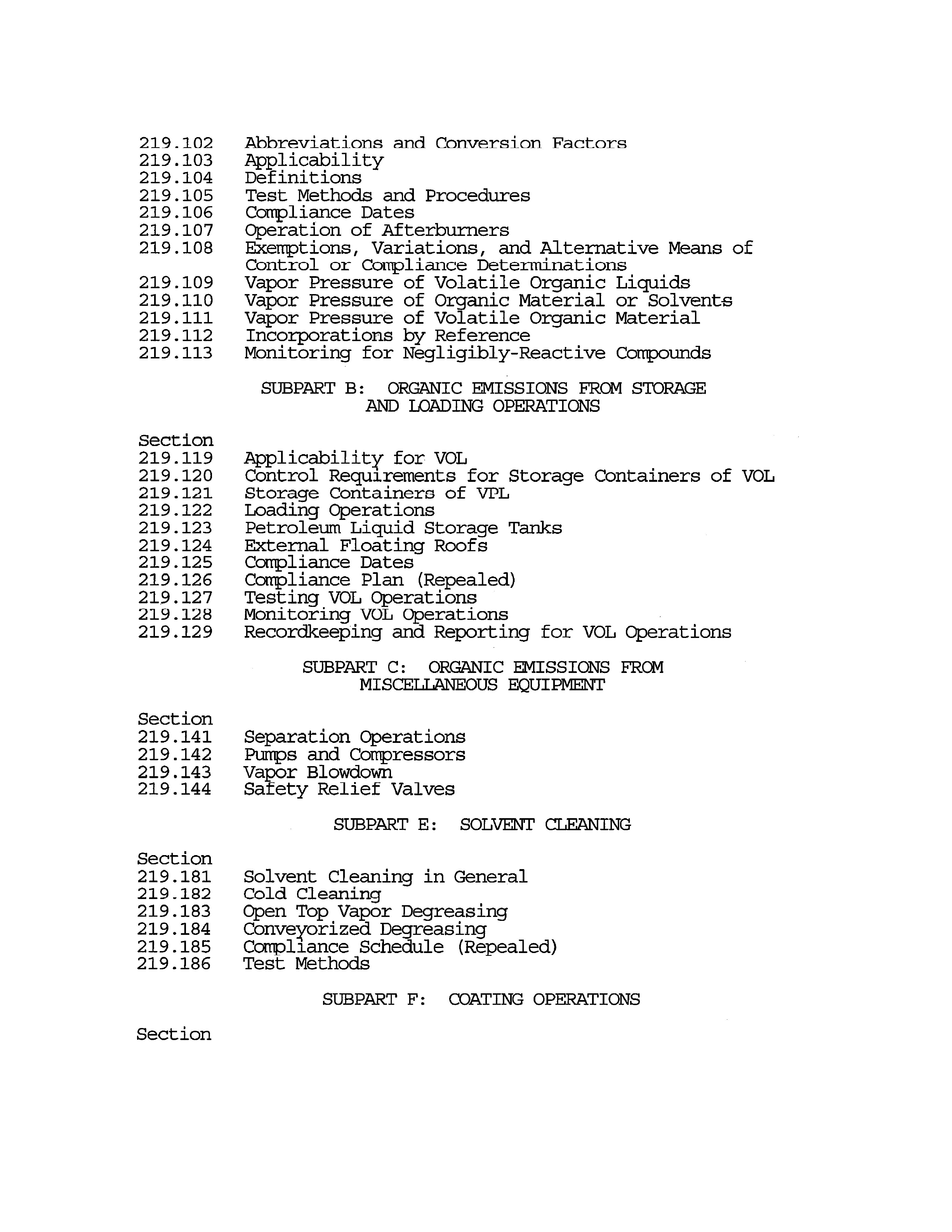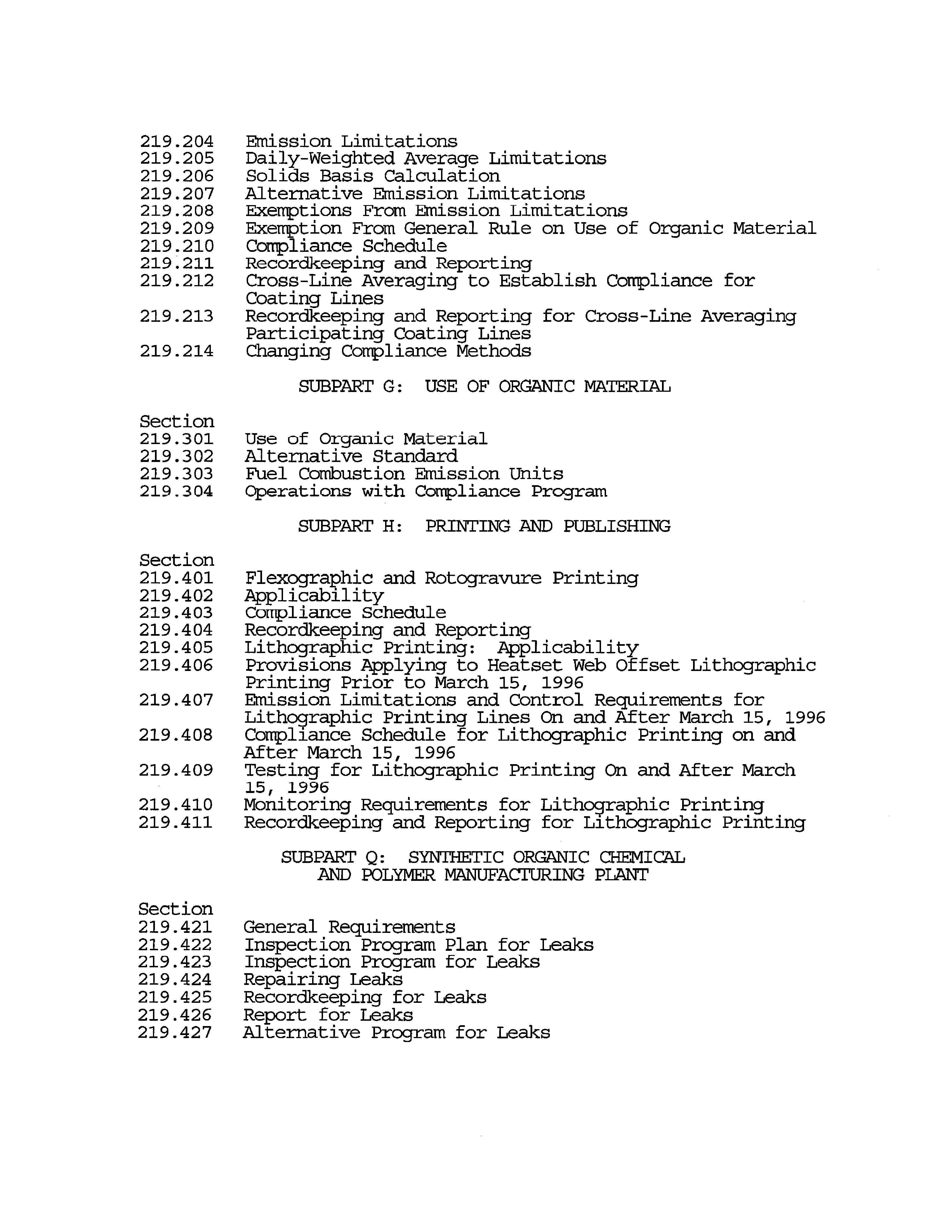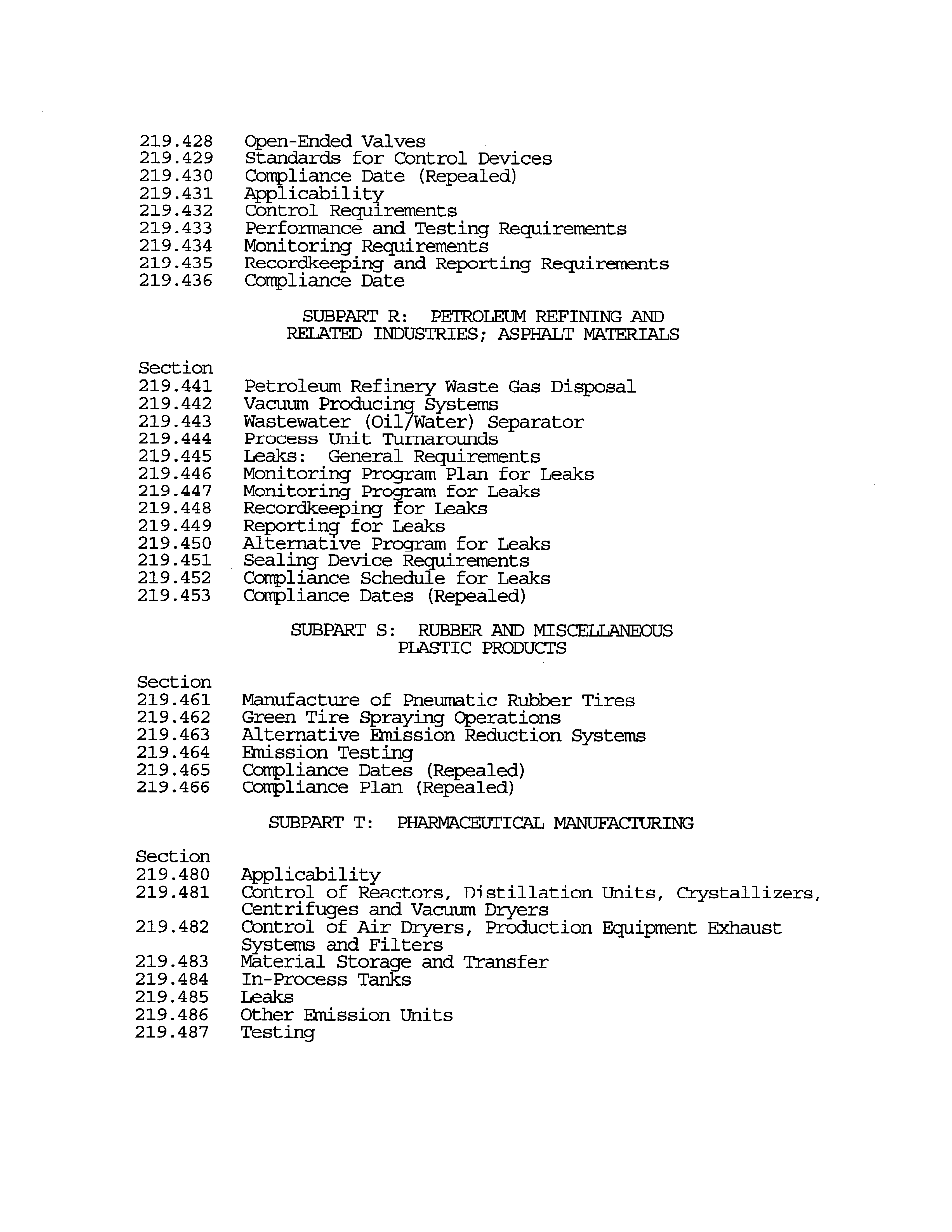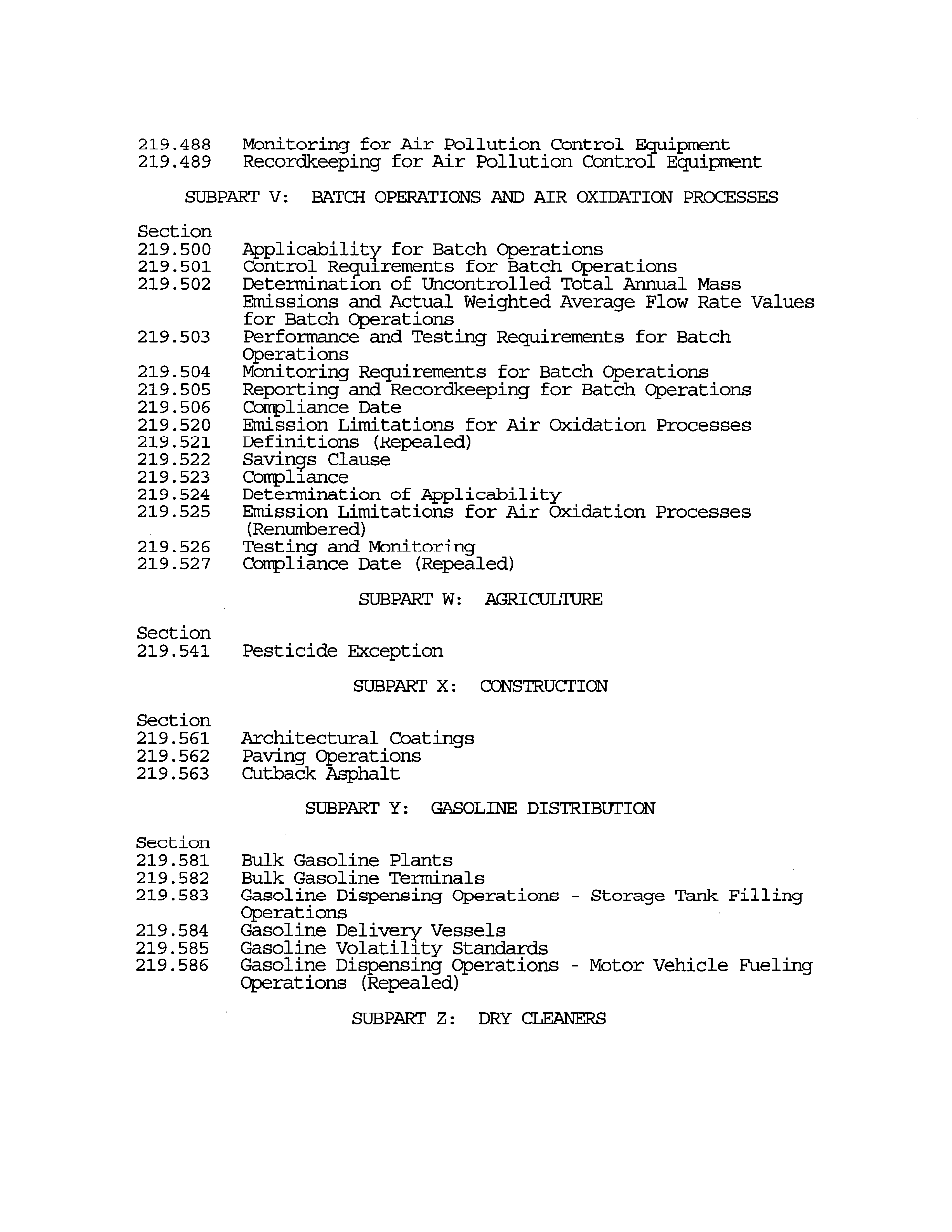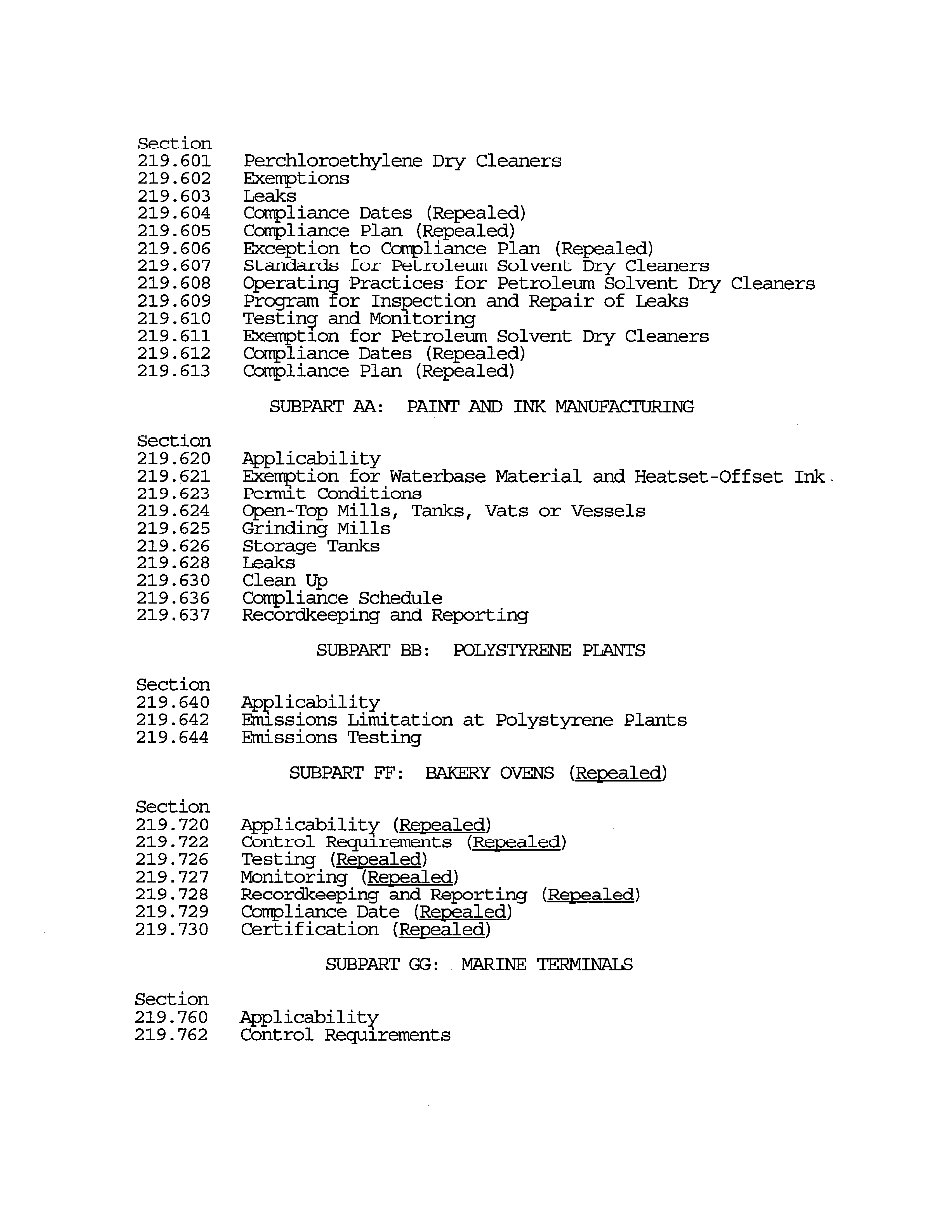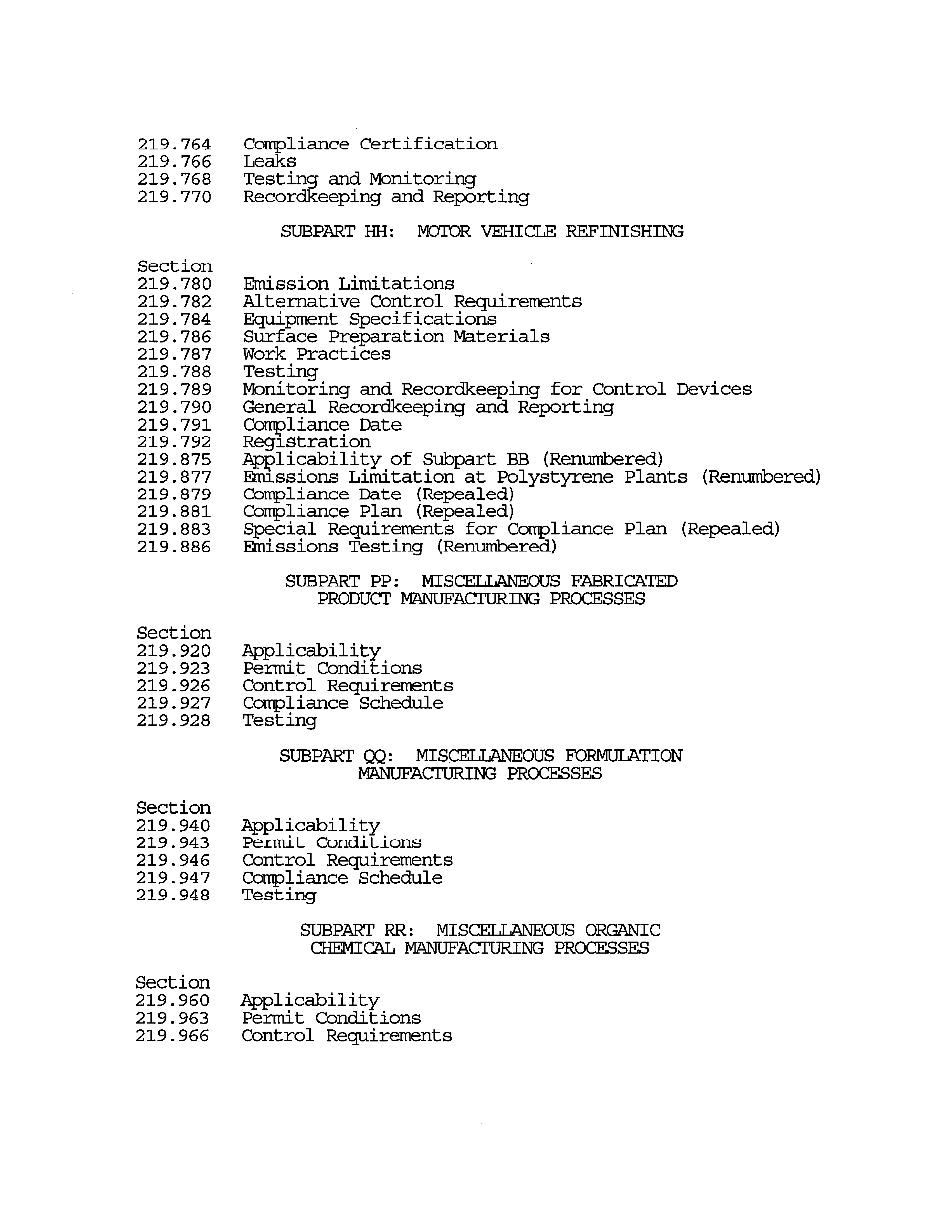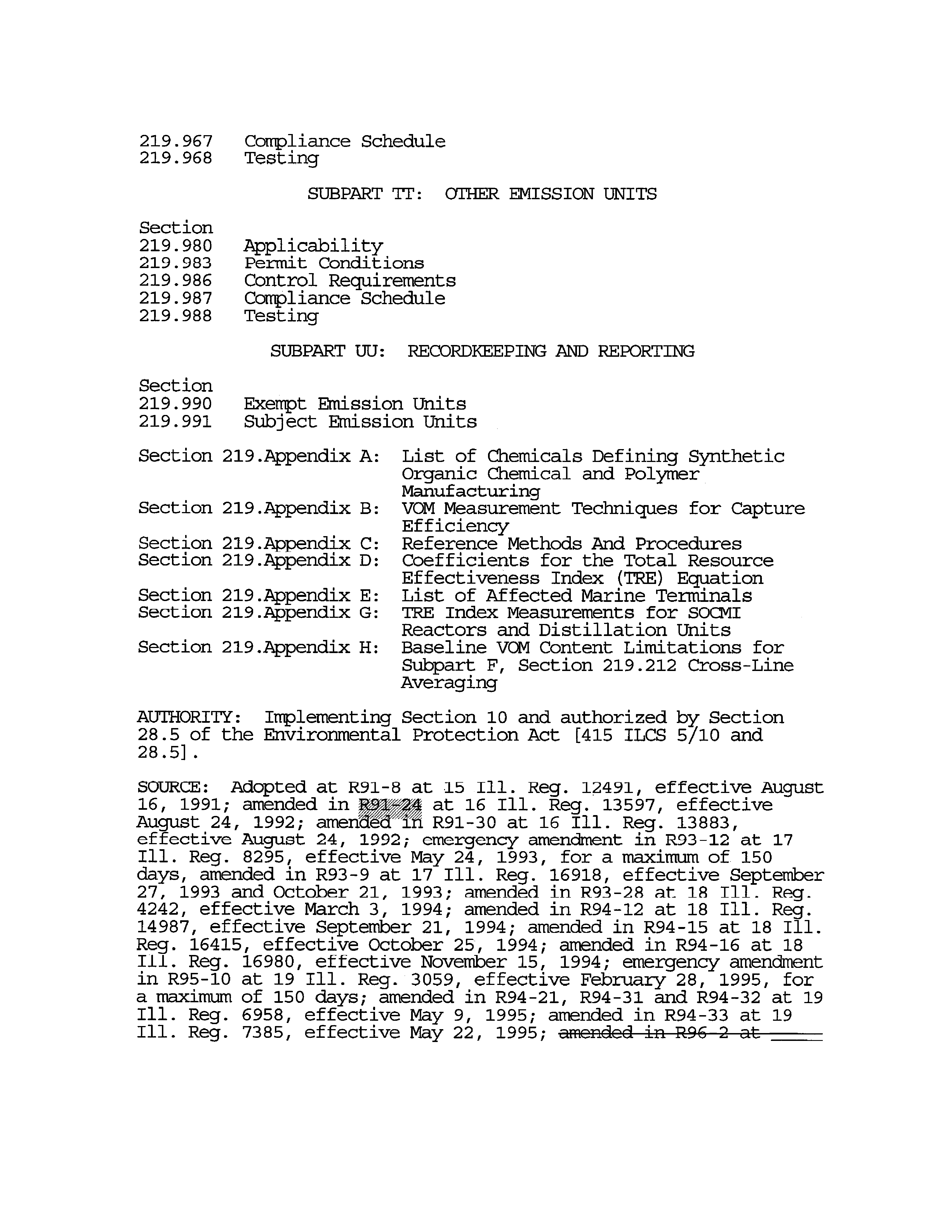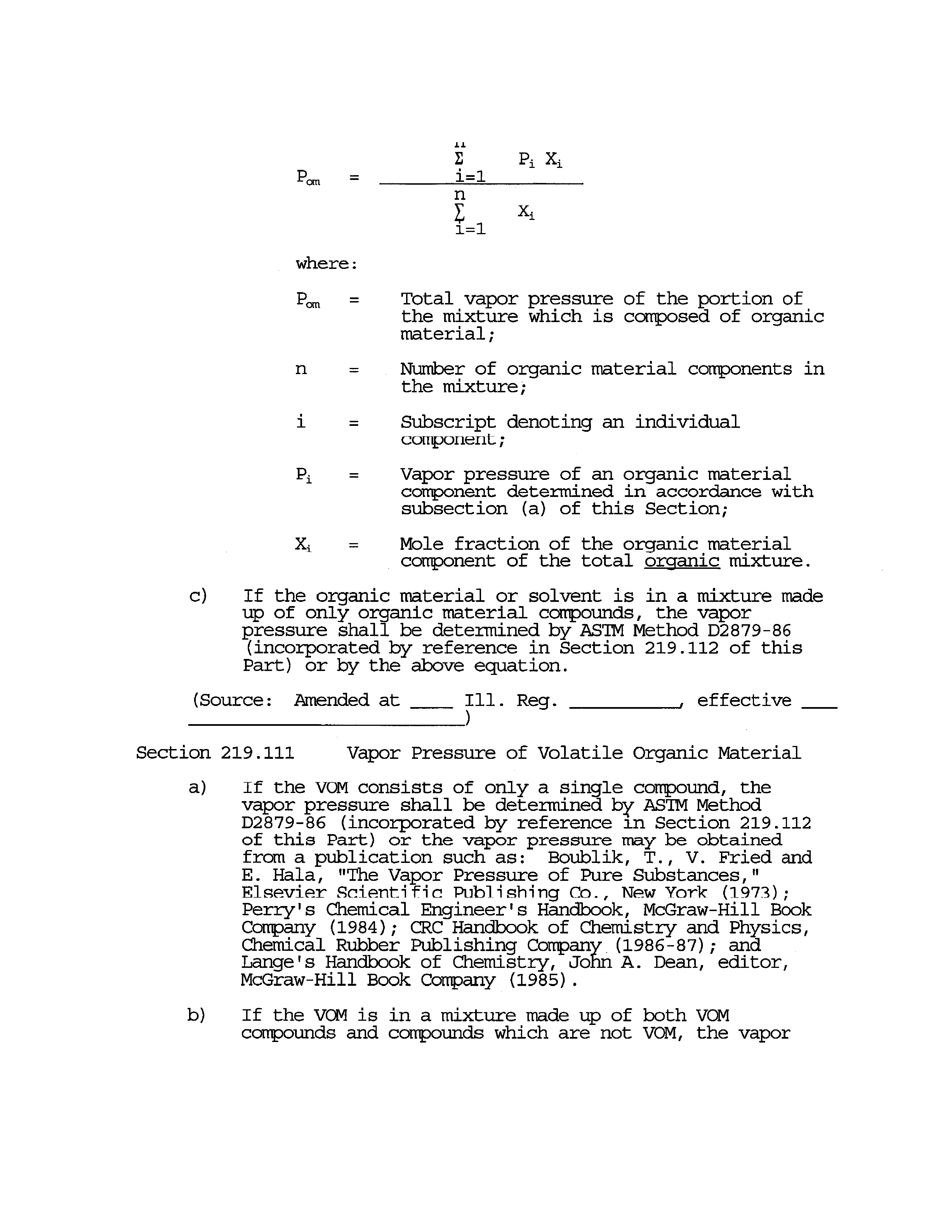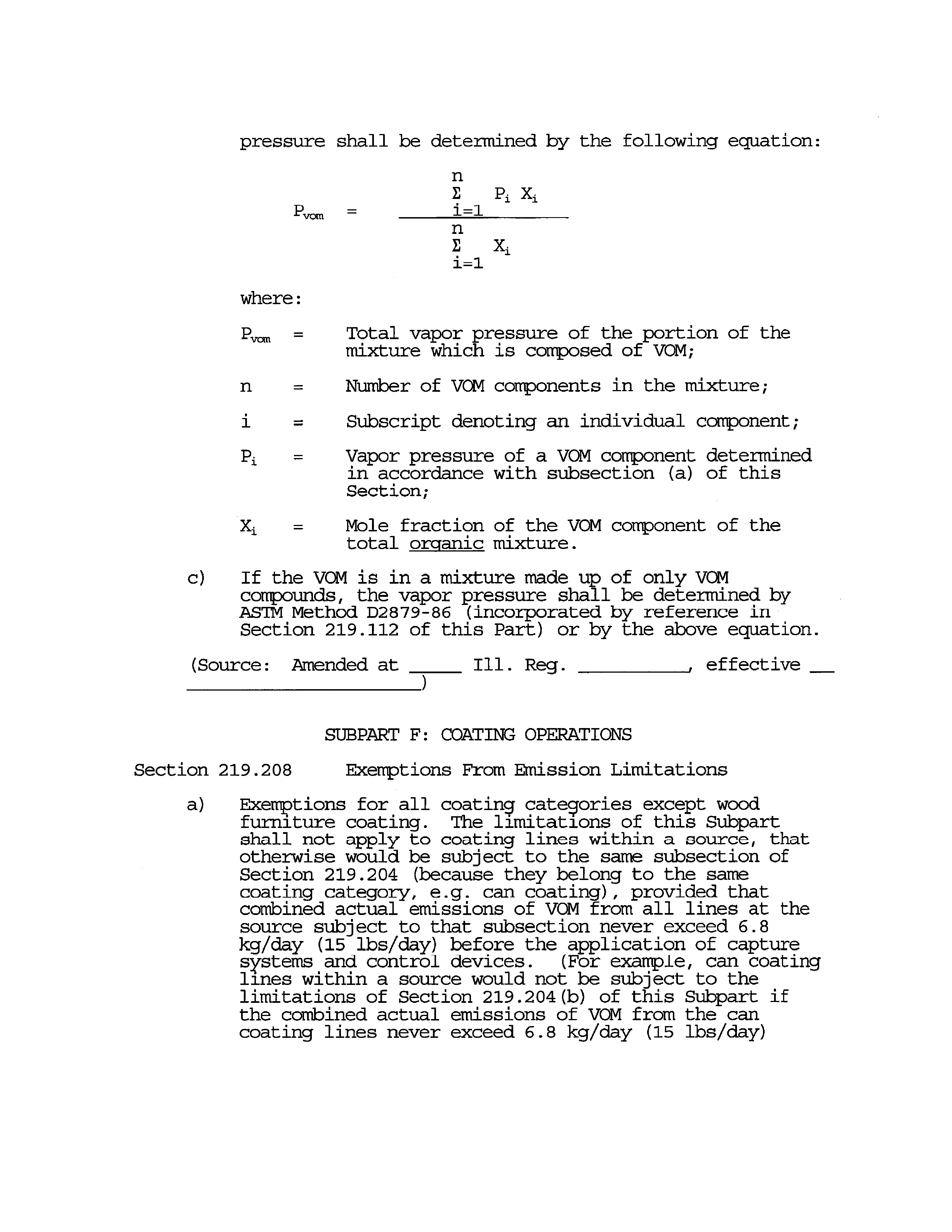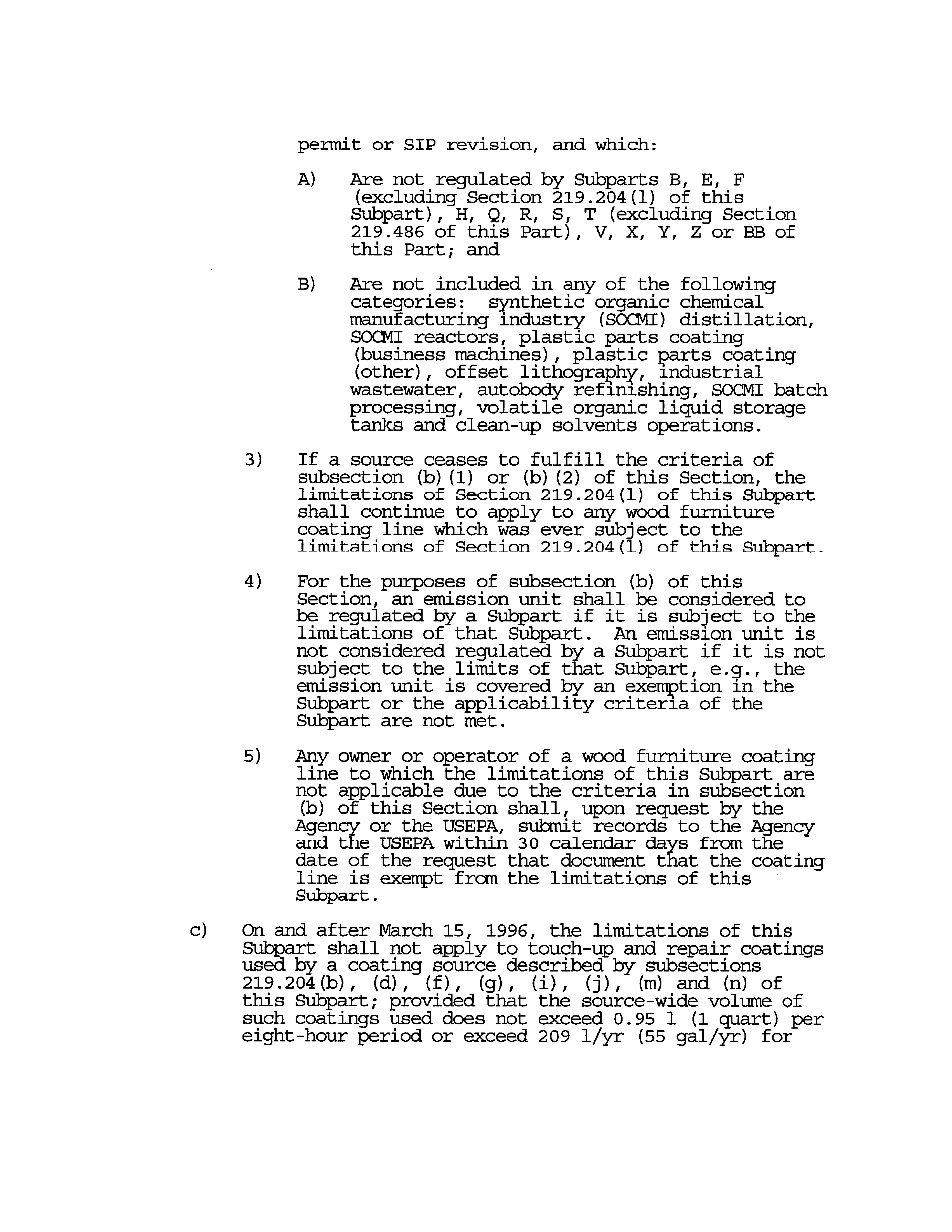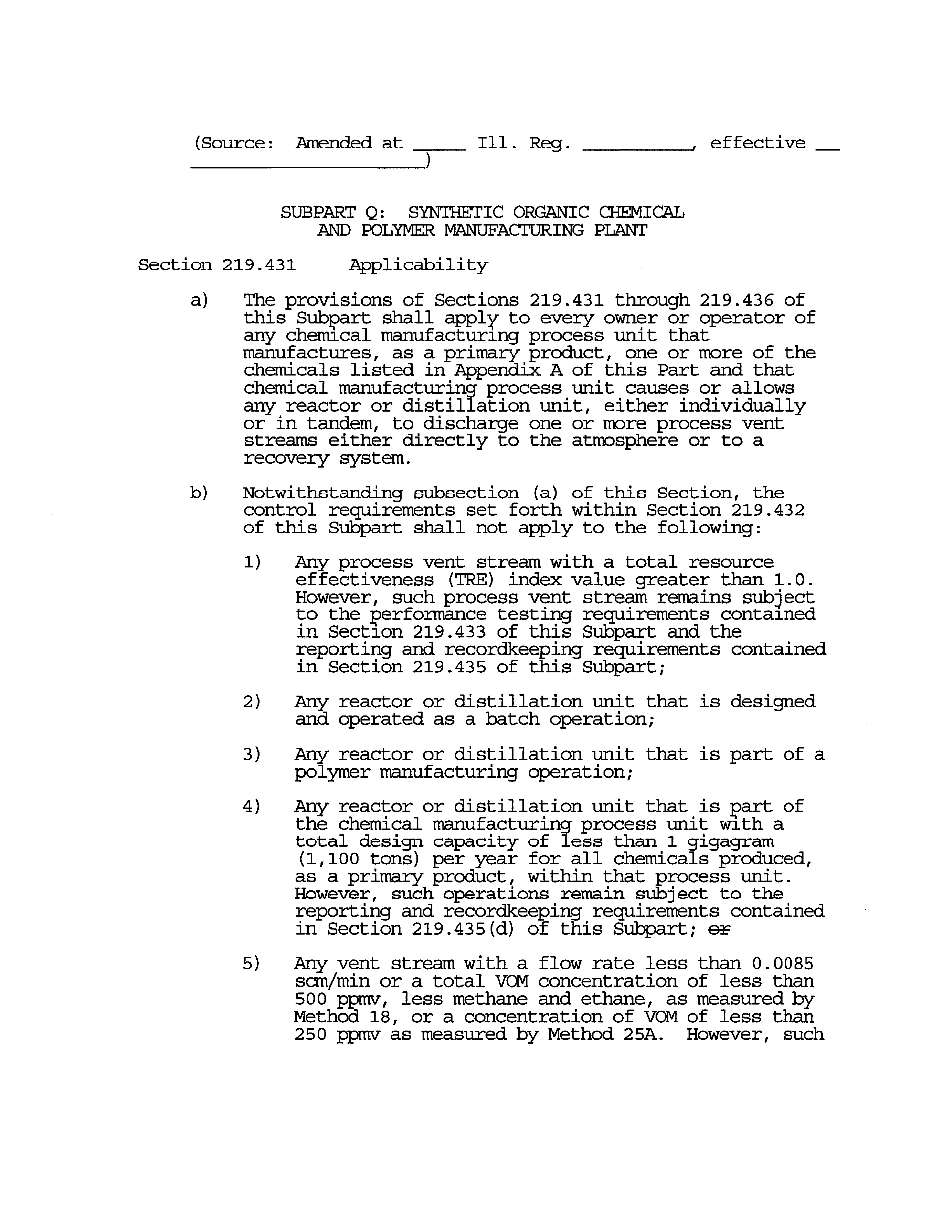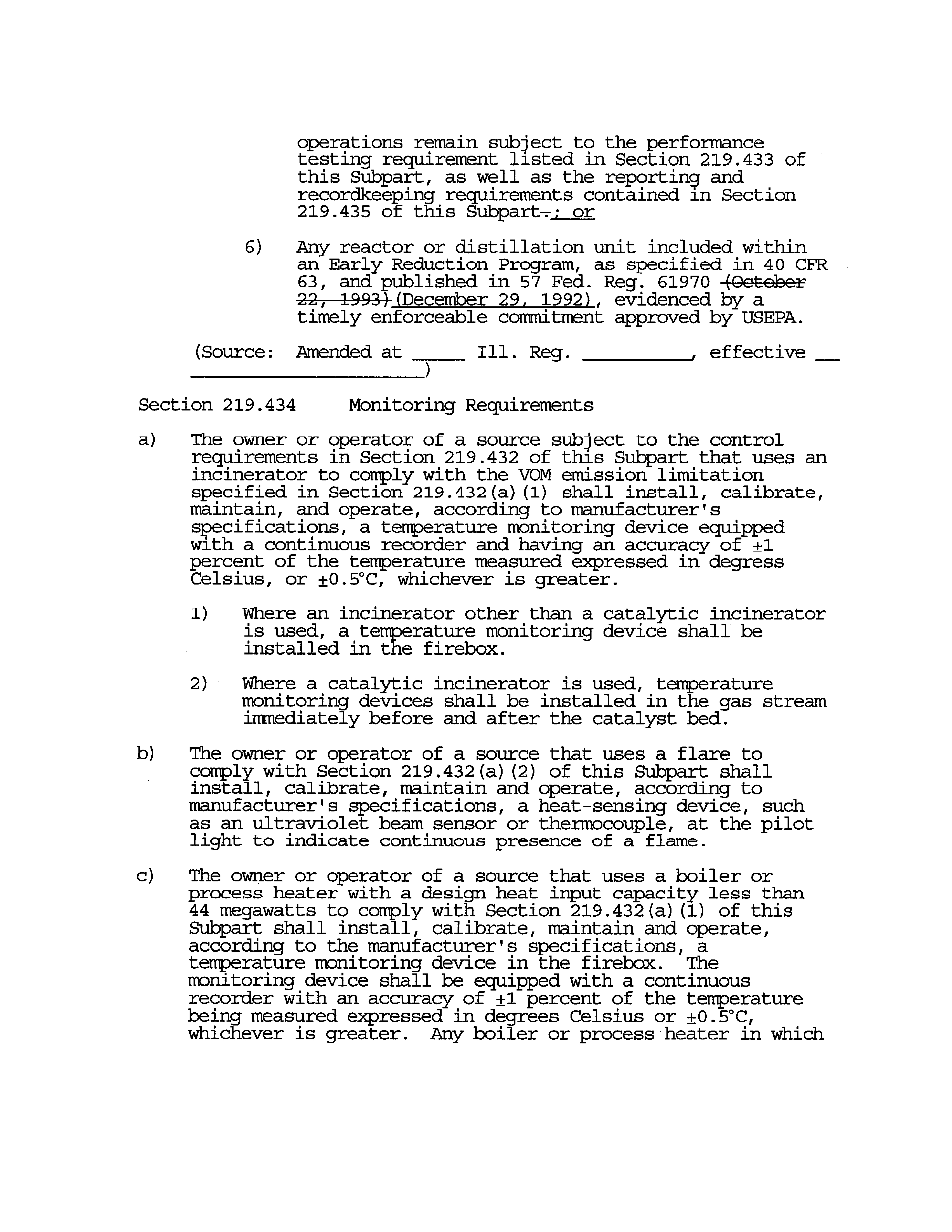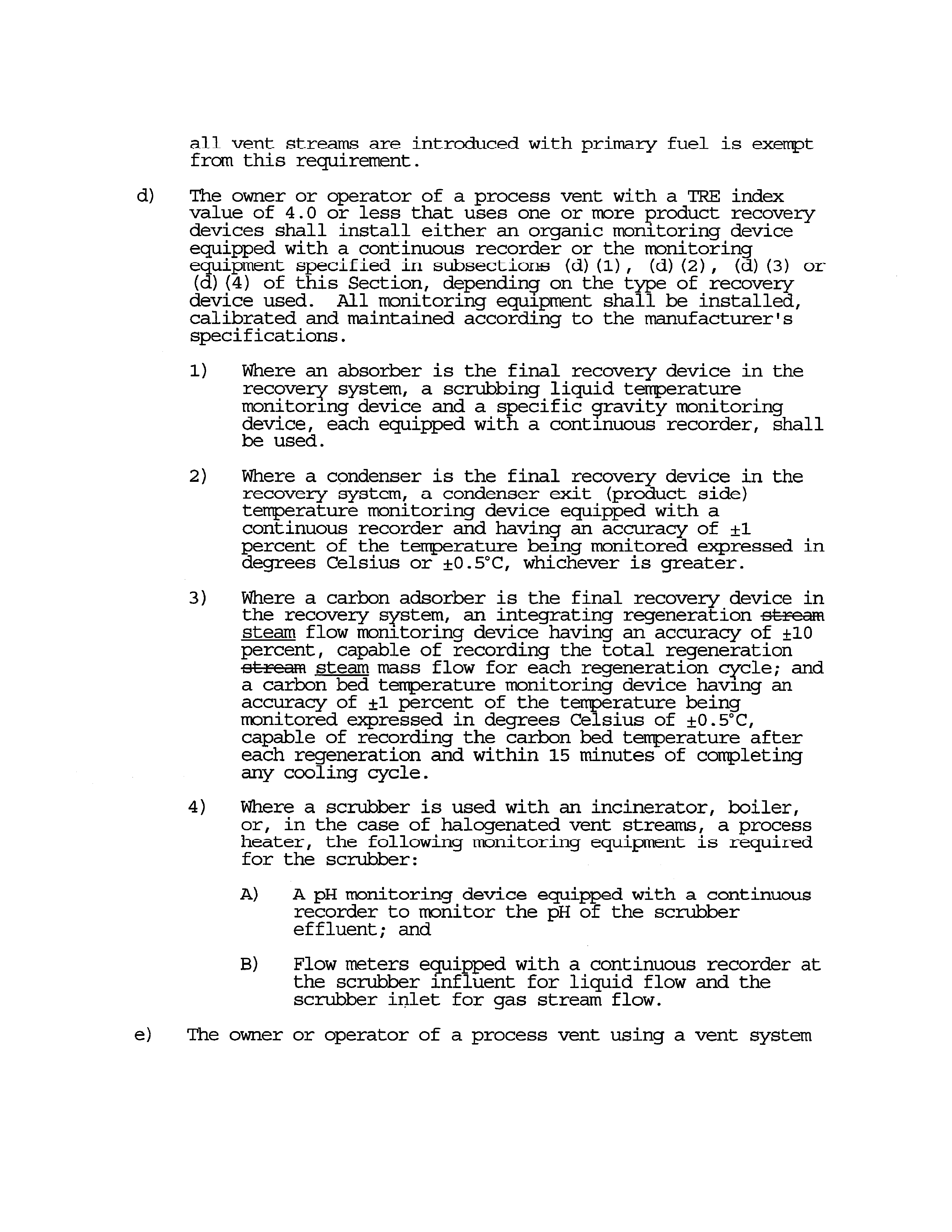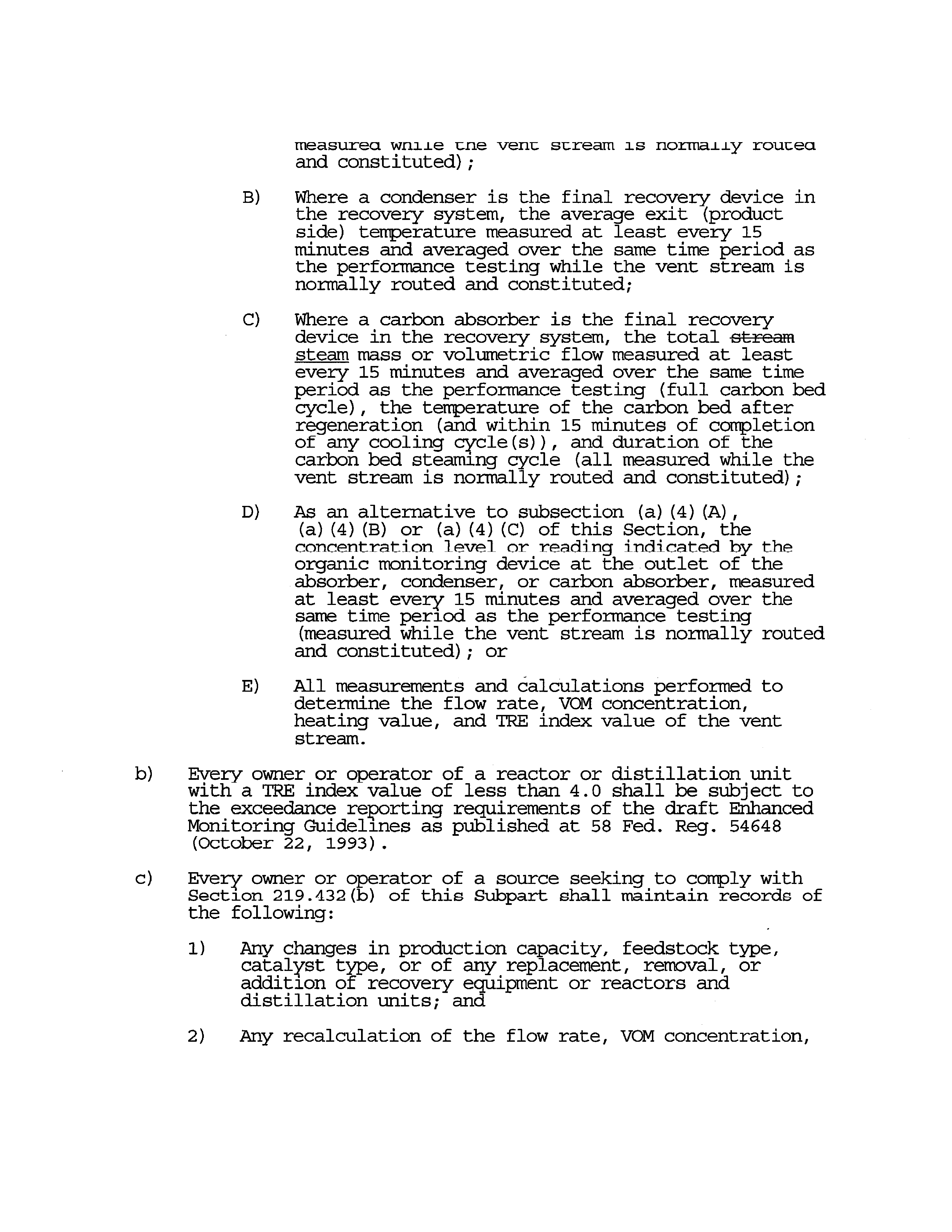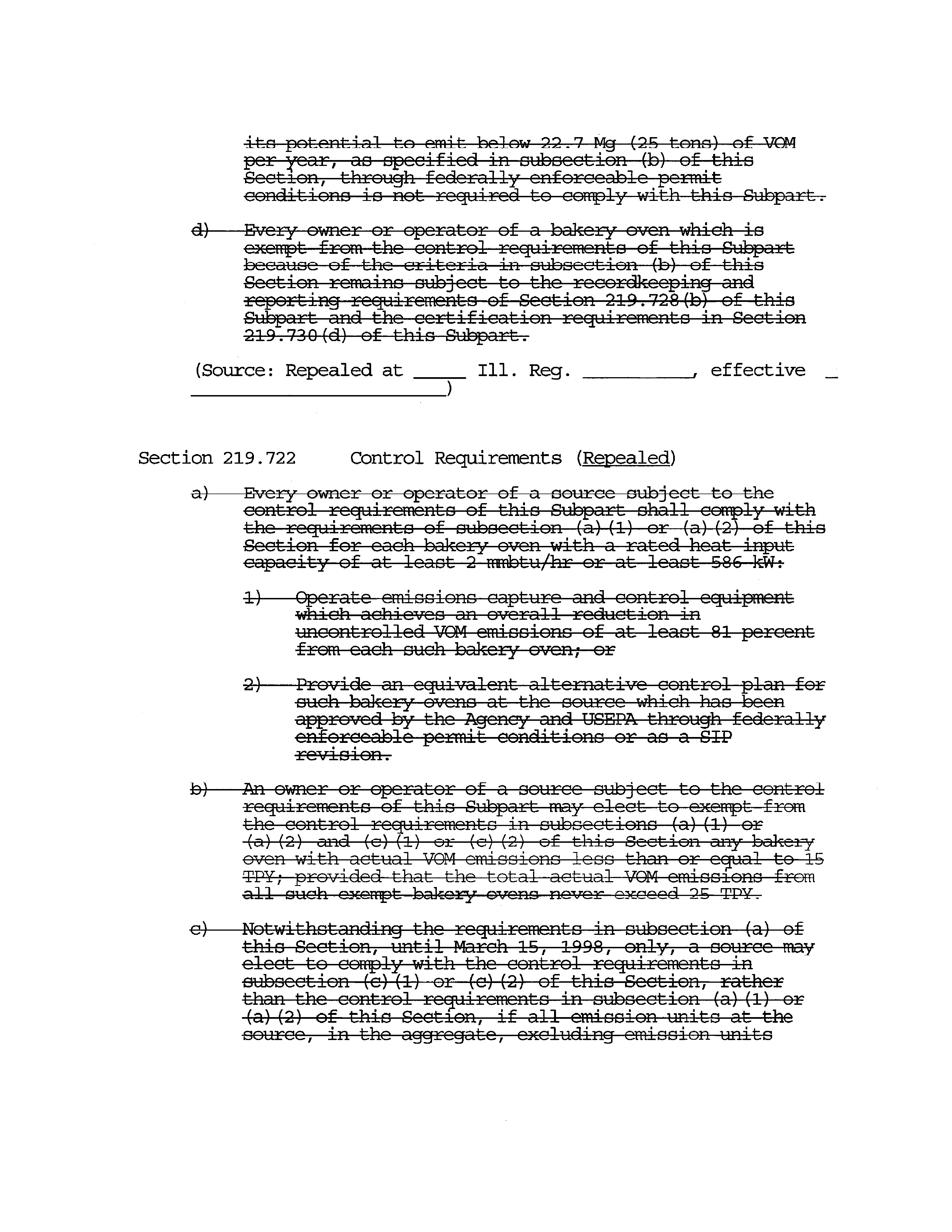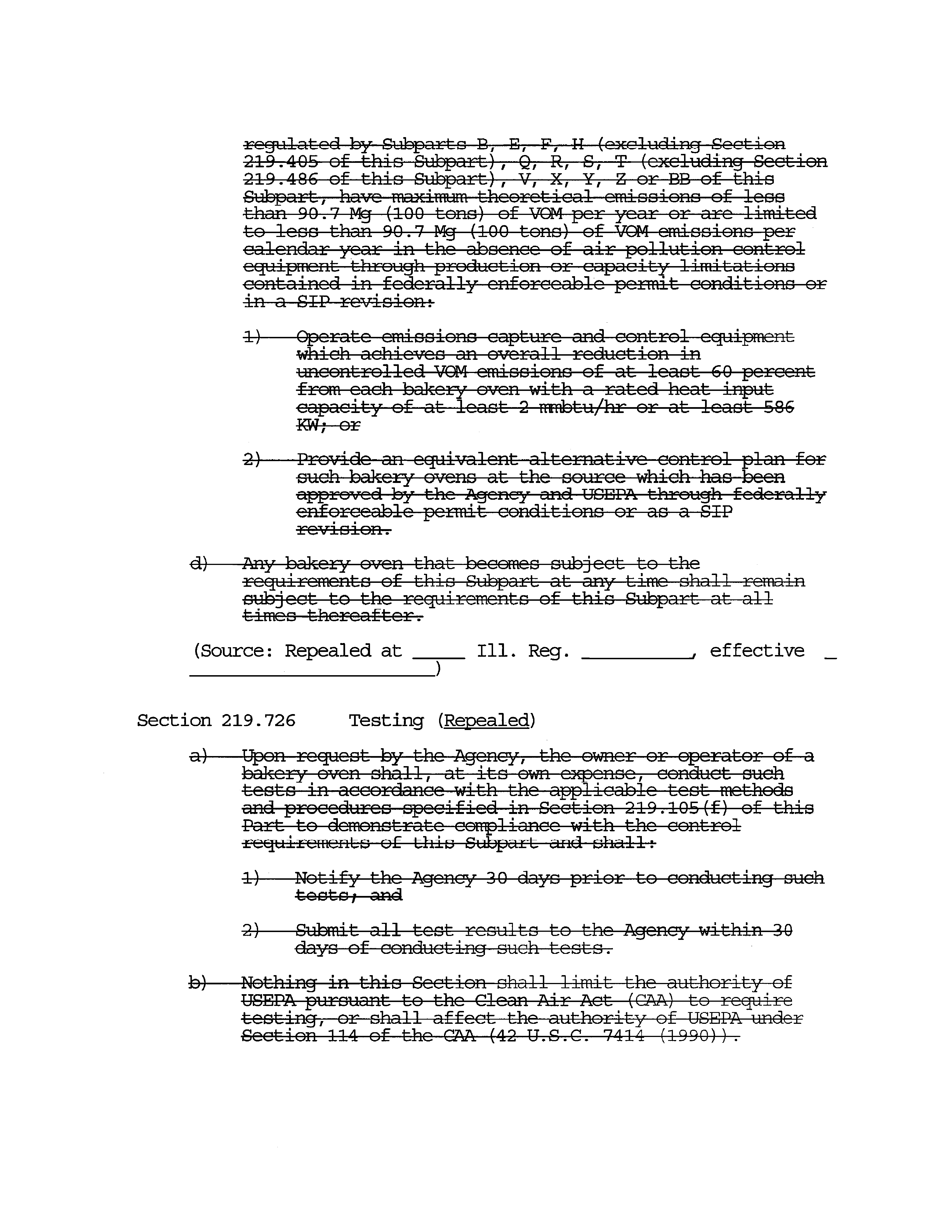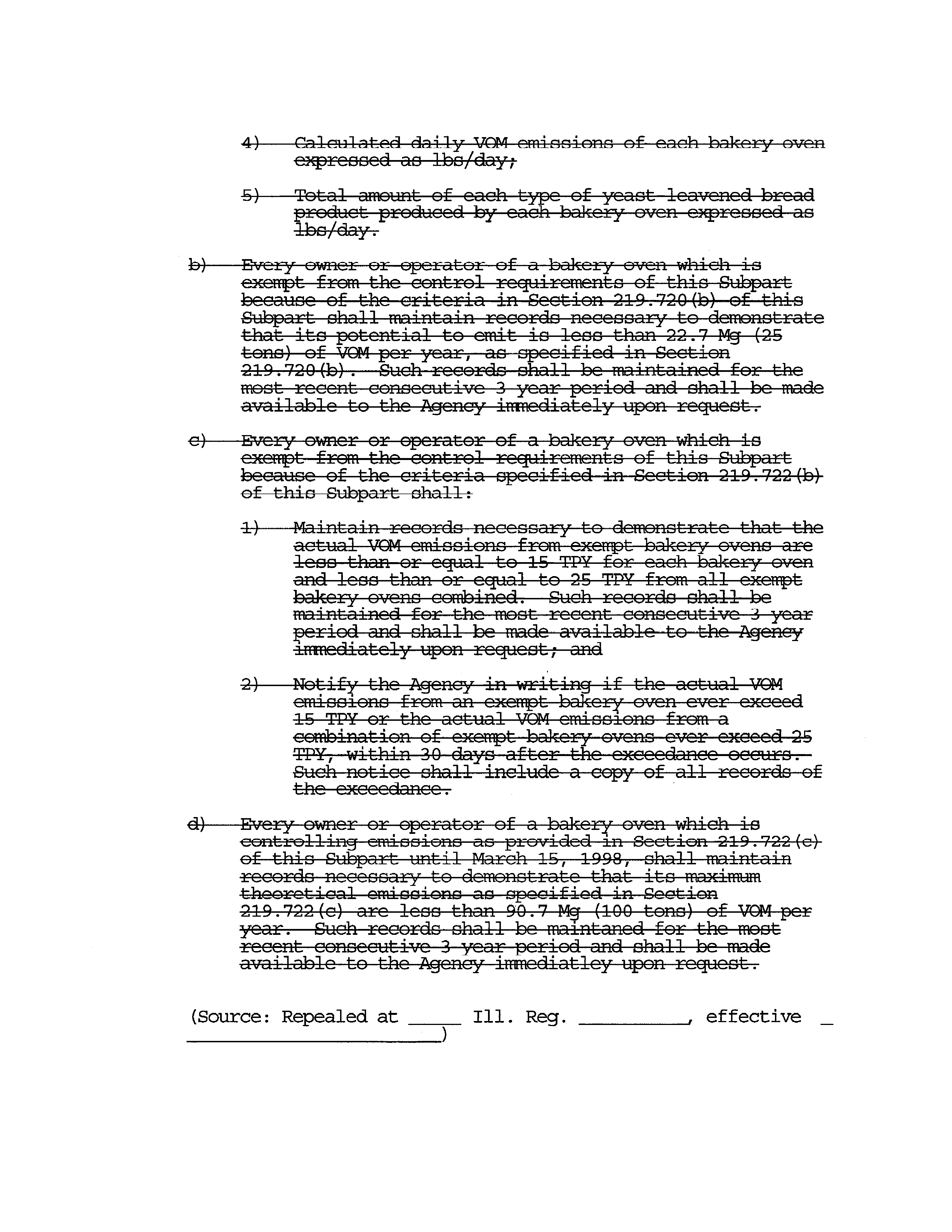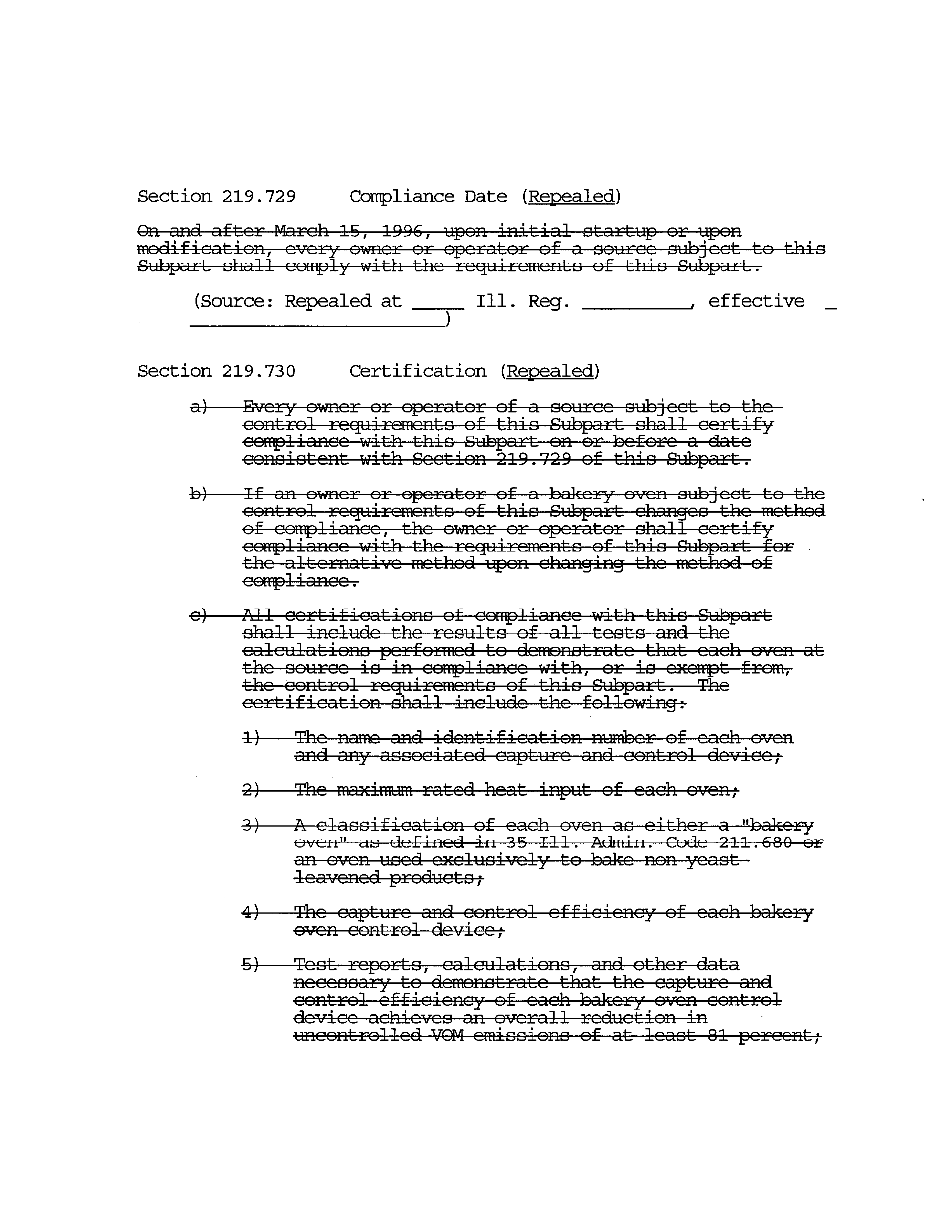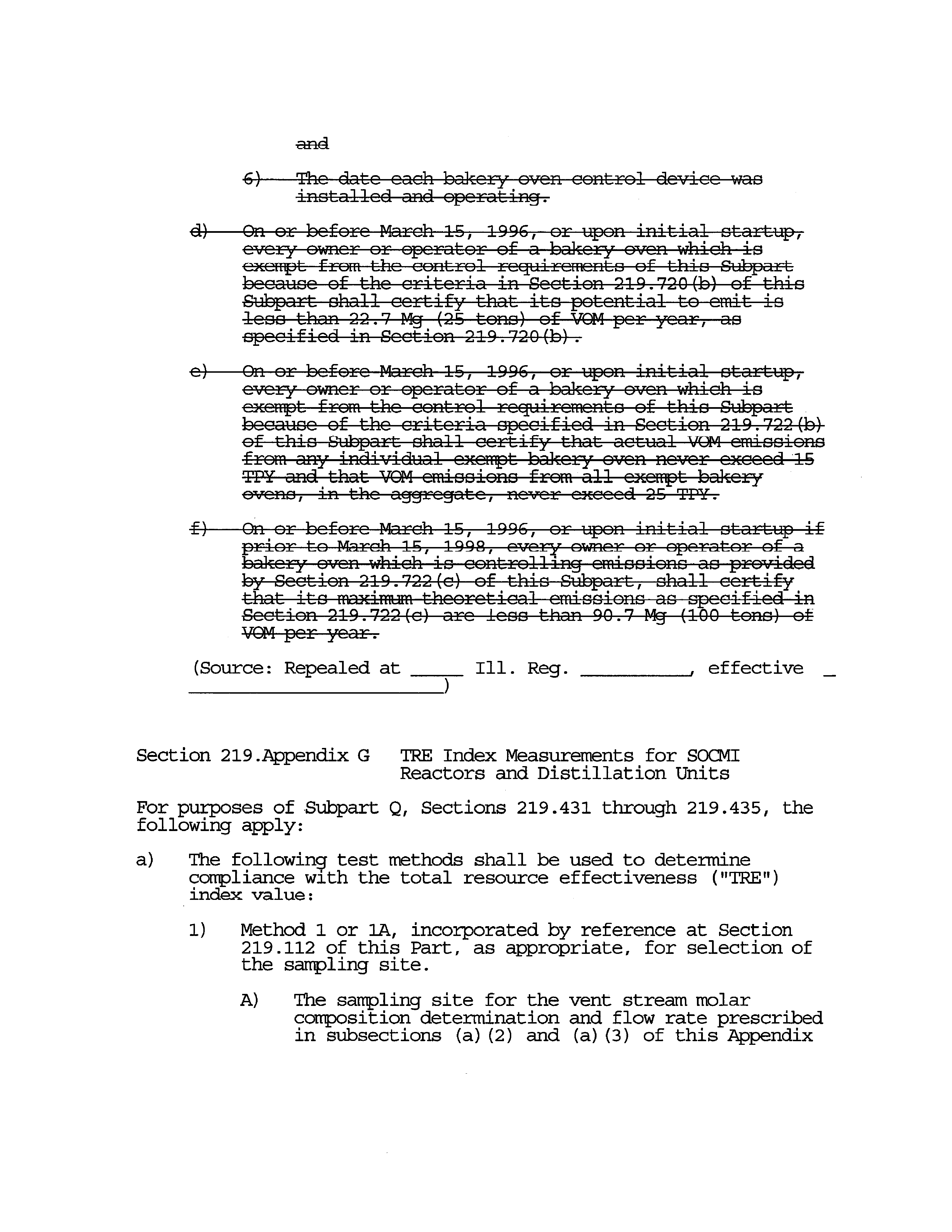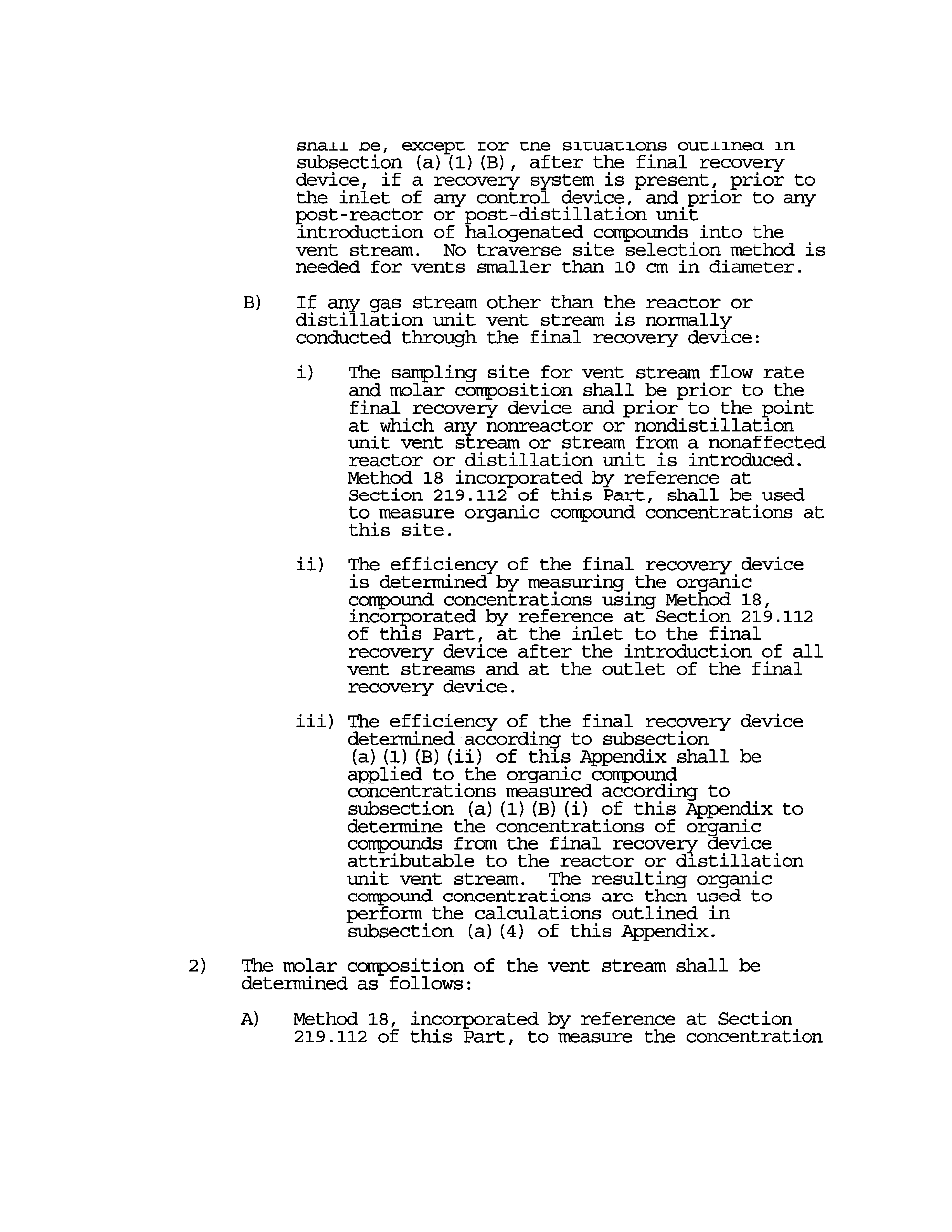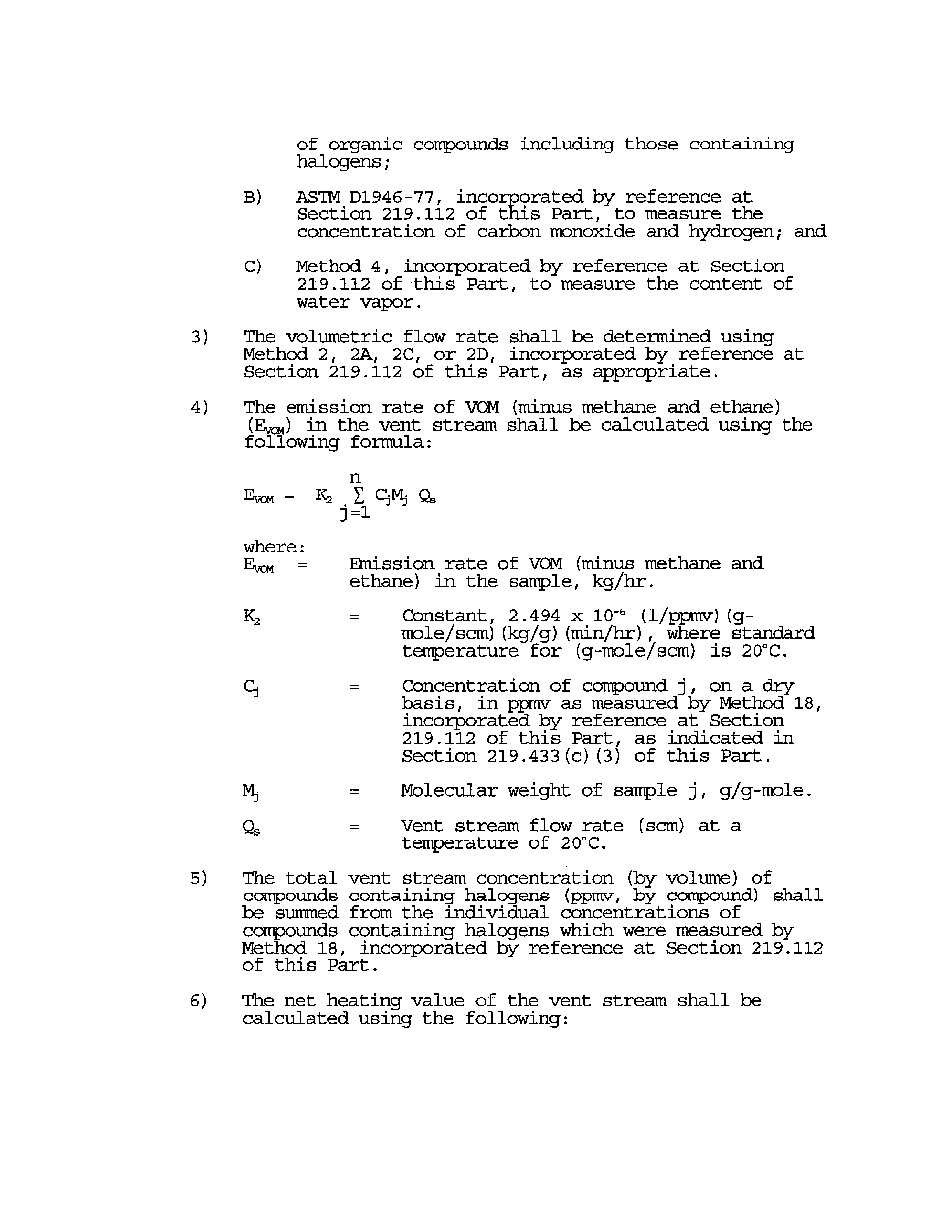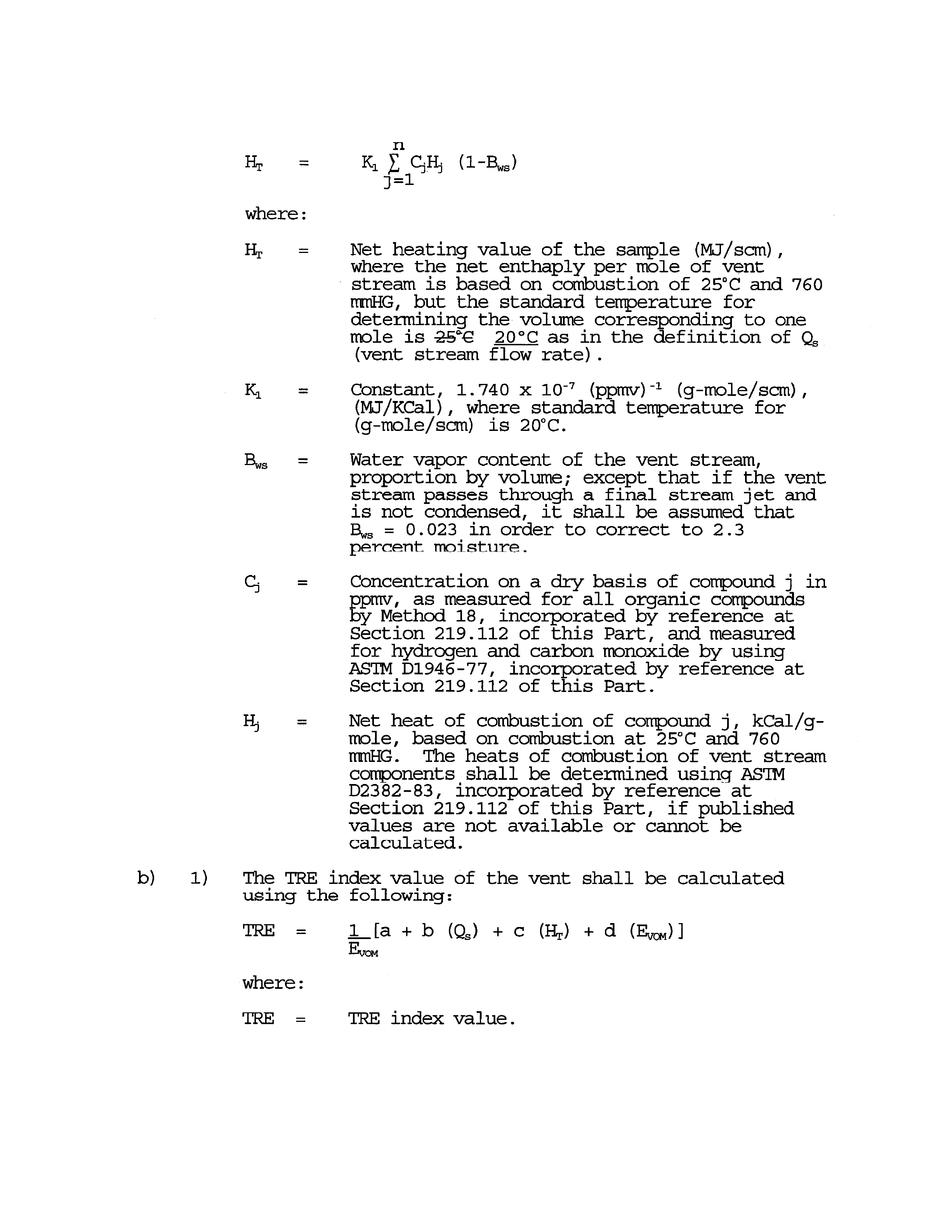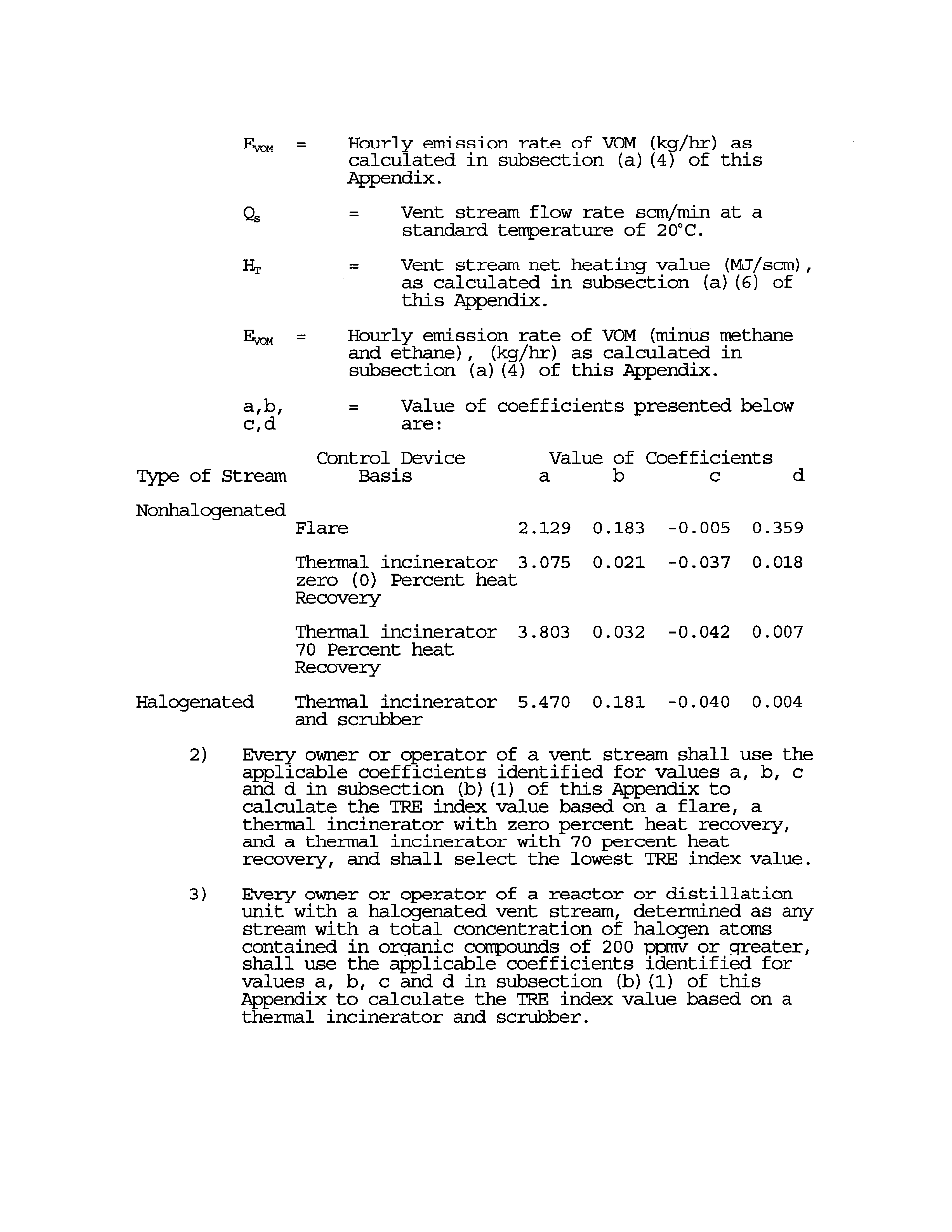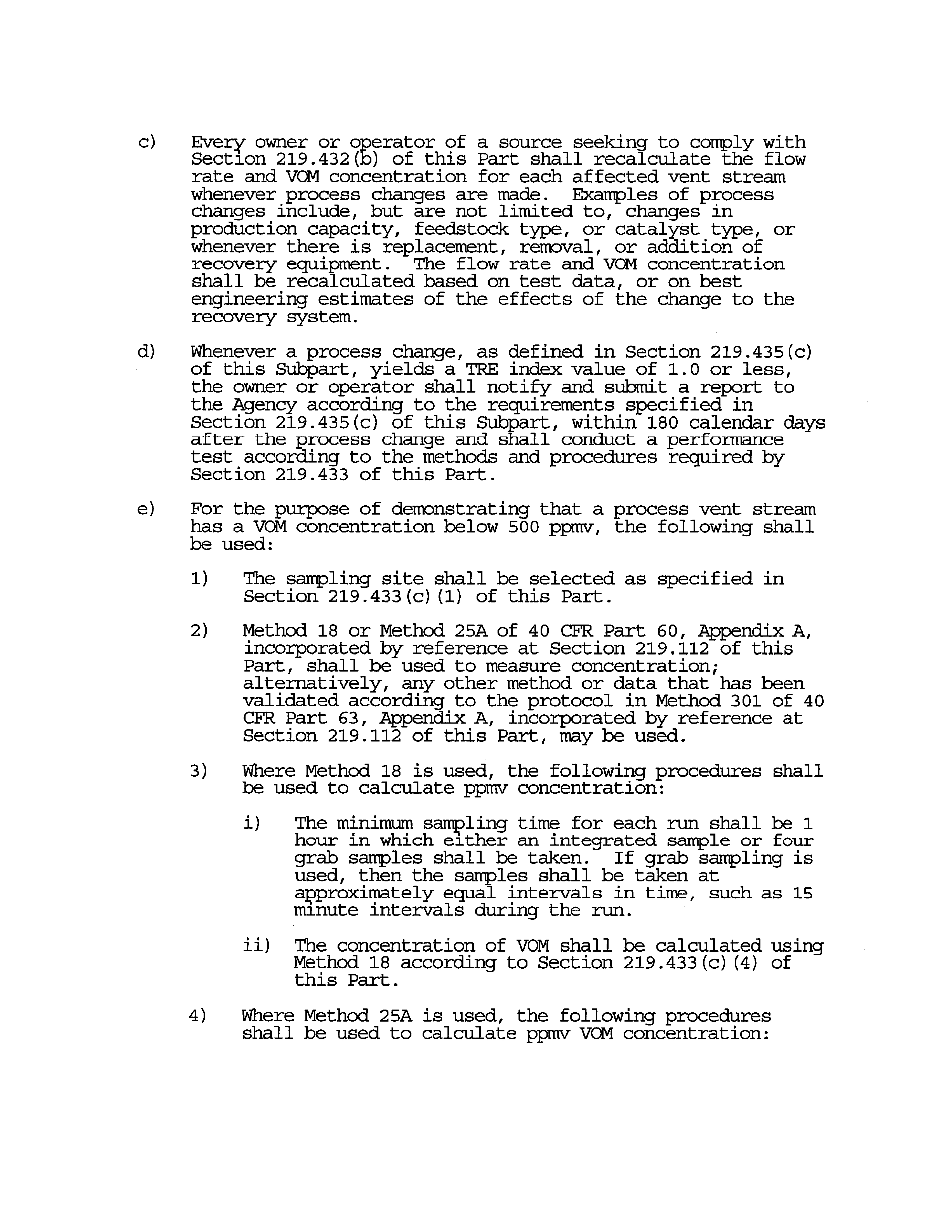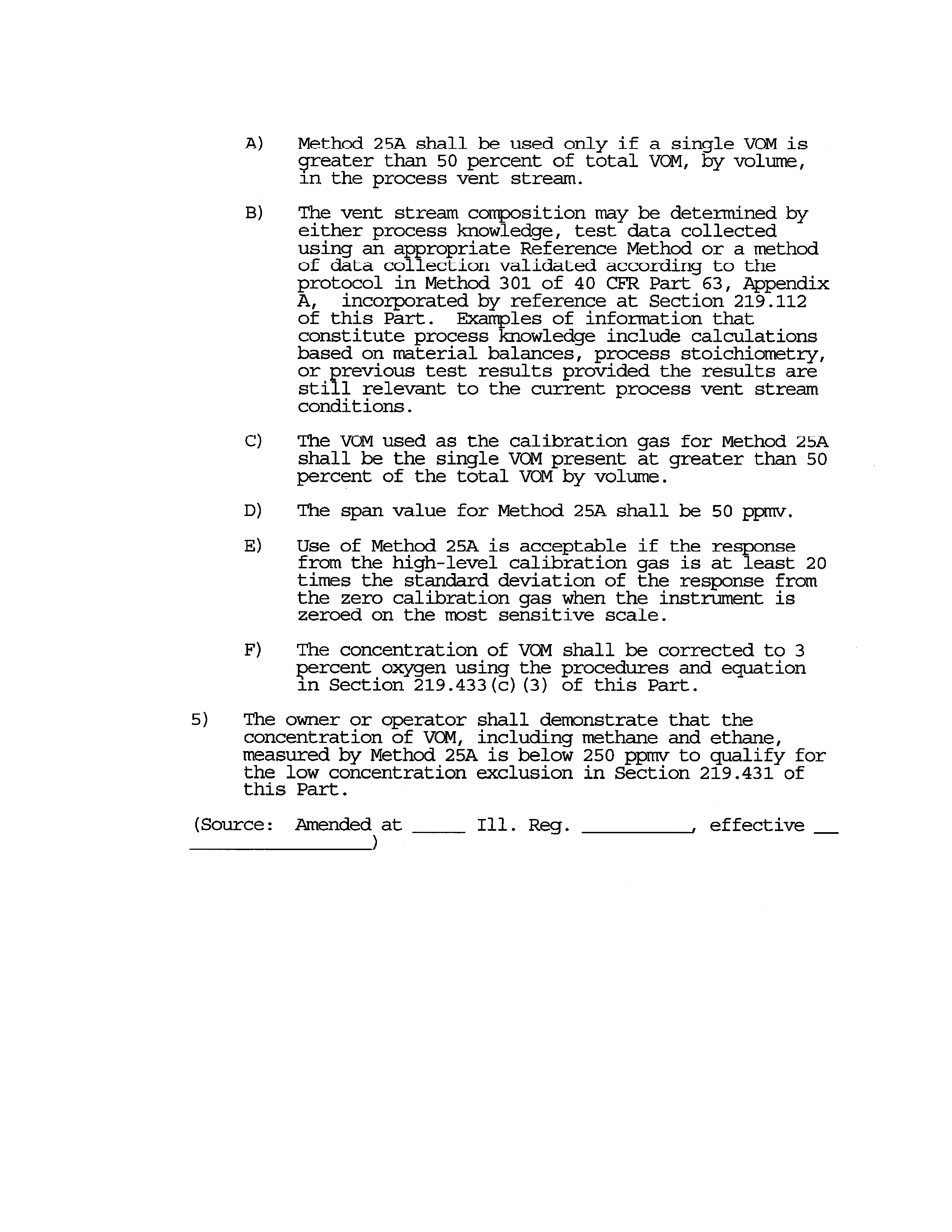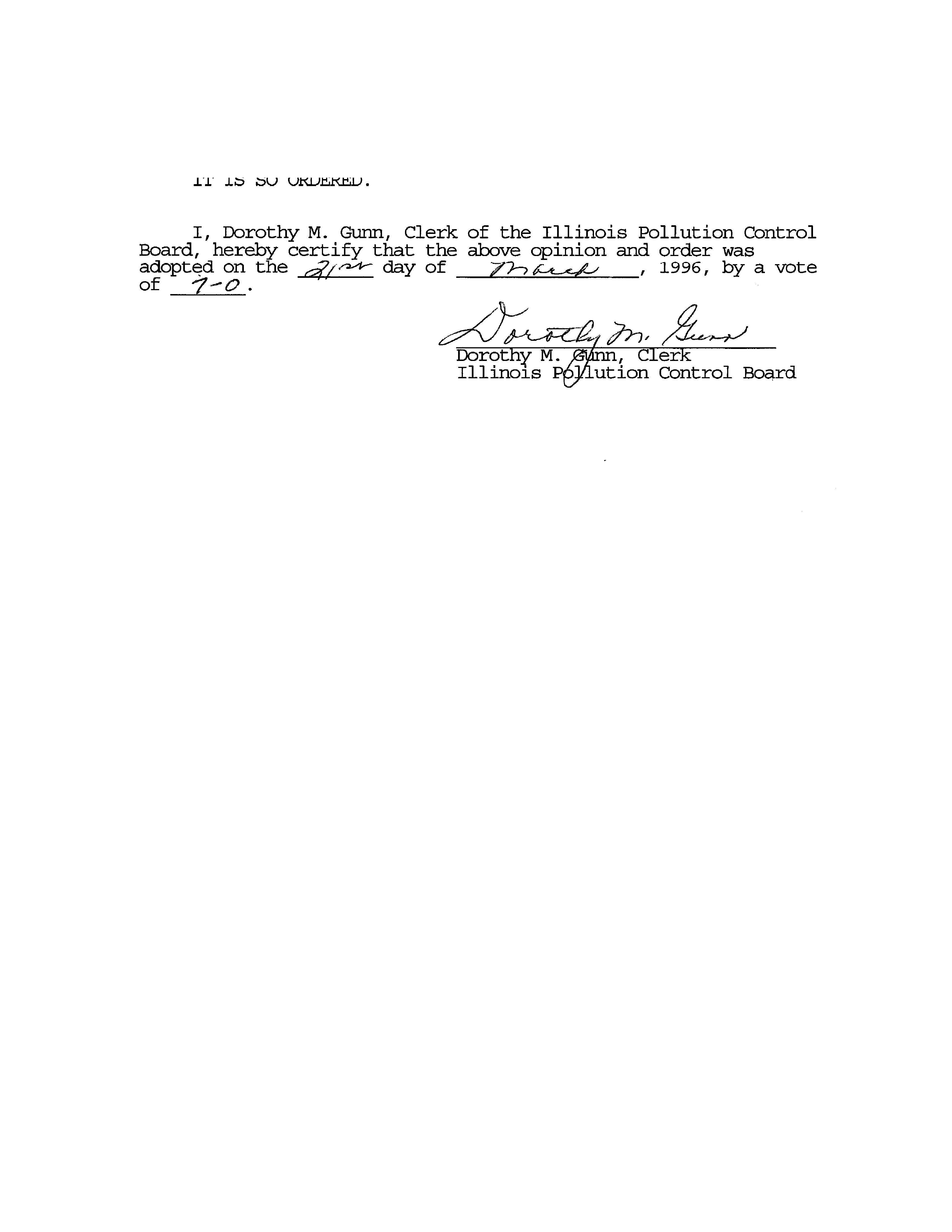ILLINOIS
POLLUTION
CONThOL BOARD
March 21,
1996
IN ThE
MATI’ER
OF:
)
151 ROP PL7~N:
CLEI½N-tJP PART II:
)
P.96-13
AMENDMENTS TO
35 ILL. ADM.
)
(Rulemaking-Air)
CODE PARTS 218 AND 219
)
Proposed Rule.
Second Notice.
OPINION AND ORDER OF ThE BOARD
(by J. Theodore Meyer):
This proposal for rulemaking before the Board was initiated
on December 13, 1995 by the Illinois Environmental Protection
Agency (Agency) pursuant to Section 28.5 of the Illinois
Environmental Protection Act
(Act) (415 ILCS 5/1
et seq.
(1994)).
The proposal seeks to make minor amendments to 35 Ill. Adm. Code
Parts 218 and 219.
The Board’s responsibility in this matter arises from the
Act
(415 ILCS
s/i
et seq.).
The Board is charged therein to
“determine, define and implement the environmental control
standards applicable in the State of Illinois”.
(415 ILCS
5/5 (b).)
More generally, the Board’s rulemaking charge is based
upon the system of checks and balances integral to Illinois
environmental governance:
the Board bears responsibility for the
rulemaking and principal adjudicatory functions; the Agency has
primary responsibility for administration of the Act and the
Board’ s regulations, including today’ s proposed regulation.
By today’s action, the Board finds that the proposal is
economically reasonable and technically feasible and is adopting
the proposed amendments for the purpose of second notice,
pursuant to the Illinois Administrative Procedure Act
(5 ILCS
100/1-1
et seq.).
The Board will direct this matter to be filed
with the Joint Committee on Administrative Rules
(JCPJR) for
consideration.
PROCEDURAL
HISTORY
AN)
BACKGROUND
Section
182(b)
(1)
of
the
Clean Air
Act
(42
U.S.C.
7511 (b) (1)) required Illinois to submit a plan by November 15,
1993, for achieving a 15
reduction of volatile organic material
(VOM) emissions in the Chicago and Metro-East ozone nonattainment
areas
(15
Rate-of-Progress
(ROP)
Plan).
Section 182 (b) of the
CAà also required Illinois to submit fully adopted measures to
implement the ROP Plan.
Illinois submitted its 15
ROP plan
November 13,
1993, and thereafter proposed regulations to
implement
the
ROP
Plan.
2
In its December 13, 1995 proposal, the Agency submitted
seven
(7) minor amendments to the ROP Plan which are detailed
below.
The Agency also filed a motion to waive certain filing
requirements of 35 Ill. Adm. Code 102 which the Board granted at
its December 20,
1995 meeting.
This proposal was filed pursuant to Section 28.5 of the Act.
(415 ILCS 5/27 and 28.5.)
As such, the Board is required to
proceed within set time frames toward the adoption of this
regulation.
The Board has no discretion to adjust these time
frames under any circumstances.
Therefore, the Board adopted the
first notice opinion and order
on December 20,
1995, without
commenting on the merits of the proposal.
The proposal was published for first notice under the
Illinois Administrative Procedure Act
(5 ILCS 100/i-i
et seq.)
on
January 5,
1996 at 20 Ill.Reg. 122
(Part 218) and 20 Ill.Reg. 155
(Part 219).
In response to the first notice publication, the
Board received two comments from JCTh~.Rregarding additional minor
changes to the proposed rulemaking.
A public hearing was held in this rulemaking docket before
hearing officer K.C. Poulos in Chicago on February 6,
1996.
The
Agency presented the pre-filed testimony of Gary E. Beckstead, an
Environmental Protection Engineer in the Air Quality Planning
Section of the Division of Air Pollution Control in the Agency’ s
Bureau of Air (Exhibit No. 1).
During the hearing the Agency
offered clarifications to the proposed language.
All testimony
supports the adoption of the language as set forth in the Board’s
December 20,
1995 order and as amended by the Agency.
Raving received no requests for another hearing, the second
and third hearings in this matter were cancelled by hearing
officer order dated February 23,
1996.
A public comment period
was established at the first hearing which expired February 27,
1996.
NO
public comments were received and the record was closed
on February 27,
1996.
PROPOSAL
In its proposal, the Agency recommended seven minor
amendments in 35 Ill. Adrn.
Code Parts 218 and 219:
1)
Add identical language found in Section 218.208(b)
regarding “equivalent alternative control plans” to
Section 219.108 (b);
2)
Revise certain equations for vapor pressure in Subpart
A of both sections;
3)
Clarify the applicable recordkeeping and reporting
requirements for coating operations using touch-up and
repair coatings in Subpart F of both sections;
4)
Correct a Federal Register citation regarding Synthetic
3
Organic Chemical and Polymer Manufacturing Plants
(SOCMI) and correct typographical errors in Subpart Q
of both sections;
-
5)
Reflect the Illinois General Assembly’s repeal in
Public Law 89-79 of the bakery oven rules in Subpart FF
of both sections;
6)
Amend the exemption for polyethylene manufacturing
operations in Subpart fl of both sections; and,
7)
Correct a typographical error in Appendix G of both
sections.
The Board also received minor editorial revisions from JCT’~R
which will be reflected in this order.
One revision is a
correction that appeared in a prior rulemaking, but was not
reflected in the final printing of that rulemaking.
(15
ROP
Plan:
Amendments to 35 Ill. Adm. Code 219.585(a) and 219.
Appendix E,
R96-2,
—
PCB
—
(February 1,
1996).)
In R96-2 the
words “Leaks from” were removed from the title of Subpart
Q
so
that it reads “Synthetic Organic Chemical and Polymer
Manufacturing Plant”.
This order reflects that correction.
DISCUSSION
The Board has carefully considered the testimony and exhibit
in this matter.
Raving received no public comments regarding the
minor amendments proposed by the Agency, the Board will amend the
proposal as suggested.
The Board will also amend the proposal as
suggested by JCPJR.
CONCUSION
The Board finds that the proposed amendments are technically
feasible and economically reasonable, and the rules are necessary
to meet the requirements of the Clean Air Act.
We find that the
record supports proceeding with the proposed rules, as amended,
to second notice.
tflCLJfilC
The
Board
hereby
directs
that
second notice of the following
proposed
amendments
be
submitted
to
the
Joint Corrmittee on
Administrative Rules
(JCAR).
The proposed lan~uageis indicated
by
underlining
and
the
proposed
deletions
are
indicated
by
striking out the previous rule.
TITLE 35:
ENVIRONMENTAL
PRC)TECflON
SUBTITLE B:
AIR POLLUTION
CHAPTER
I:
POLLUTION CON’IROL BOARD
SUBCHAPTER
c:
EMISSIONS STANDARDS AND
LIMITATIONS
FOR
STATIONARY
SOURCES
PART 218
ORGANIC
MATERIAL
EMISSION STANDARDS AND
LIMITATIONS
FOR IHE CHICAGO
AREA
SUBPART
A:
GENERAL
PROVISIONS
Section
218
.
100
Introduction
218.101
Savings Clause
218.102
Abbreviations and
conversion Factors
218.103
Applicability
218
.
104
Definitions
218.105
Test Methods and
Procedures
218.106
Compliance Dates
218.107
Operation of Afterburners
218.108
Exemptions,
Variations,
and
Alternative
Means
of
Control or Compliance Determinations
218.109
Vapor Pressure of Volatile Organic Liquids
218.110
Vapor Pressure of Organic Material or Solvents
218.111
Vapor Pressure of Volatile Organic Material
218
.
112
Incorporations by Reference
218
.
113
Monitoring for Neg1i~ibly-ReactiveCompounds
218.114
Compliance with Permit Conditions
SUBPART B:
ORGANIC EMISSIONS FROM STORAGE
AND
WADING
OPERATIONS
Section
218.119
Applicability for VOL
218.120
Control Requirements for Storage Containers of VOL
218.121
Storage Containers of VPL
218.122
Loading Operations
218.123
Petroleum Liquid Storage Tanks
218.124
External Floating Roofs
218.125
Compliance Dates
218.126
Compliance Plan
(Repealed)
218.127
Testing VOL Operations
218.128
Monitoring VOL Operations
218.129
Recordkeeping and Reporting for VOL Operations
u~ti-~c~
i
~:
(J1-~JN
J~
L~
~
LUIN5
~±~1v1
MISCELLANEOUS EQUIPMENT
Section
218.141
Separation Operations
218.142
Pumps and Compressors
218
.
143
Vapor Blowdown
218.144
Safety
Relief
Valves
SUBPART E:
SOLVENT CLEANING
Section
218.181
Solvent Cleaning in General
218.182
Cold Cleaning
218.183
Open Top Vapor Degreasing
218
.
184
Conveyorized
Degreasing
218.185
Compliance Schedule (Repealed)
218.186
Test Methods
SUBPART F:
COATING OPERATIONS
Section
218.204
Emission Limitations
218.205
Daily-Weighted Average Limitations
218.206
Solids Basis Calculation
218.207
Alternative Emission Limitations
218.208
Exemptions from Emission Limitations
218.209
Exemption from General Rule on Use of Organic Material
218
.
210
Compliance
Schedule
218.211
Recordkeeping and Reporting
218.212
Cross-Line Averaging to Establish Compliance for
Coating Lines
218.213
Recordkeeping and Reporting for Cross-Line Averaging
Participating
Coating
Lines
218 214
Changing Compliance Methods
SUBPART G:
USE OF ORGANIC MATERIAL
Section
218.301
Use of Organic Material
218.302
Alternative Standard
218.303
Fuel Combustion Emission Units
218.304
Operations with Compliance Program
SUBPART H:
PRINTING AND PUBLISHING
Section
218.401
Flexographic and
Rotogravure
Printing
218.402
Applicability
218.403
Compliance Schedule
218.404
Recordkeeping and Reporting
218.405
Lithographic Printing:
Applicability
218.406
Provisions
Applying
to
Heatset
Web Offset Lithographic
Printing Prior to March 15, 1996
21A407
Emission
Limitations
and
Control
Requirements
for
Lithographic
Printing
Lines
On and
After March 15, 1996
218.408
Compliance
Schedule for Lithographic Printing on and
After March 15, 1996
218.409
Testing for Lithographic Printing On and After March
15,
1996
218.410
Monitoring Requirements for Litho9raphic Printing
218.411
Recordkeeping
and
Reporting
for
Lithographic
Printing
SUBPART
Q:
SYNThETIC ORGANIC CHEMICAL
AND POLYMER MANUFACTURING PLANT
Section
218.421
General Requirements
218.422
Inspection
Program
Plan
for
Leaks
218.423
Inspection
Program
for
Leaks
218.424
Repairing Leaks
218.425
Recordkeeping for Leaks
218.426
Report for Leaks
218.427
Alternative Program
for
Leaks
218.428
Open-Ended
Valves
218.429
Standards
for
Control
Devices
218.430
Compliance
Date
(Repealed)
218.431
Applicability
218.432
Control Requirements
218.433
Performance and Testing Requirements
218.434
Monitoring Requirements
218.435
Recordkeeping and Reporting Requirements
218.436
Compliance Date
SUBPART R:
PEtROLEUM REFINING AND
RELAThD INDUSTRIES; ASPHALT MATERIALS
Section
218.441
Petroleum Refinery Waste Gas Disposal
218.442
Vacuum Producing Systems
218.443
Wastewater (Oil/Water)
Separator
218.444
Process
Unit
Turnarounds
218.445
Leaks:
General Requirements
218.446
Monitoring Program Plan for Leaks
218.447
Monitoring Program for Leaks
218.448
Recorclkeeping for Leaks
218.449
Reporting for Leaks
218 450
Alternative Program for Leaks
218.451
Sealing Device Requirements
218.452
Compliance Schedule for Leaks
218.453
Compliance Dates
(Repealed)
SUBPART 5:
RUBBER AND MISCELU\NEOUS
PLASTIC PRODUCTS
Section
218.461
Manufacture
of
Pneumatic
Rubber
Tires
218.462
Green Tire Spraying Operations
218.463
Alternative Emission Reduction Systems
218.464
Emission Testing
218.465
Compliance Dates
(Repealed)
218.466
Compliance Plan
(Repealed)
SUBPART T:
PHARMACEUTICAL MANUFACTURING
Section
218 .480
Applicability
218.481
Control of Reactors, Distillation Units,
Crystallizers,
Centrifuges and Vacuum Dryers
218.482
Control of Air Dryers, Production Equipment Exhaust
Systems and Filters
218.483
Material Storage and Transfer
218.484
In-Process Tanks
218.485
Leaks
218.486
Other Emission Units
218.487
Testing
218.488
Monitoring for Air Pollution Control Equipment
218.489
Recordkeeping
for
Air
Pollution
Control
Equipment
SUBPART V:
BATCH OPERATIONS AND AIR
OXIDATION
PROCESSES
Section
218.500
Applicability
for
Batch
Operations
218
.
501
Control Requirements for Batch Operations
218.502
Determination of Uncontrolled Total Annual Mass
Emissions and Average Flow Rate Values for Batch
Operations
218.503
Performance and Testing Requirements for Batch
Operations
218
.
504
Monitoring Requirements for Batch Operations
218
.
505
Reporting
and
Recordkeeping
for
Batch
Operations
218.506
Compliance Date
218.520
Emission Limitations for Air Oxidation Processes
218.521
Definitions
(Repealed)
218.522
Savin~sClause
218.523
Compliance
218.524
Determination of Applicability
218.525
Emission Limitations for Air
Oxidation
Processes
(Renumbered)
218.526
Testing
and
Monitoring
218.527
Compliance Date
(Repealed)
SUBPART
W:
AGRICULTURE
Section
218.541
Pesticide Exception
StJBPART X:
CONSTRUCTION
Architectural Coatings
Paving Operations
Cutback Asphalt
Bulk Gasoline Plants
Bulk Gasoline Terminals
Gasoline Dispensing Operations
-
Storage
Tank
Filling
Operations
Gasoline Delivery Vessels
Gasoline Volatility Standards
Gasoline
Dispensing
Operations
-
Motor
Vehicle
Fueling
Operations
SUBPART Z:
DRY CLEANERS
Perchloroethylene Dry Cleaners
Applicability
Leaks
Compliance Dates
(Repealed)
Compliance Plan
(Repealed)
Exception to Compliance Plan
(Repealed)
Standards for Petroleum Solvent
Dry
Cleaners
Operating Practices for Petroleum Solvent
Dry
Cleaners
Program for Inspection and Repair of Leaks
Testing and Monitoring
Applicablity for Petroleum Solvent Dry Cleaners
Compliance Dates
(Repealed)
Compliance Plan
(Repealed)
SUBPART AA:
PAINT AND INK MANUFACTURING
Section
218.620
218.621
218.623
218.624
218.625
218.626
218.628
218.630
218.636
218.637
Applicability
Exemption
for
Waterbase
Material
and
Heatset-Offset
Ink
Permit Conditions
(Repealed)
Open Top Mills,
Tanks, Vats or Vessels
Grinding Mills
Storage Tanks
Leaks
Clean Up
Compliance Schedule
Recordkeeping
and
Reporting
SUBPART
Y:
GASOLINE
DISTRIBUTION
Section
218.561
218.562
218.563
Section
218.581
218.582
218.583
218.584
218.585
218.586
Section
218.601
218.602
218.603
218.604
218.605
218.606
218.607
218.608
218.609
218.610
218.611
218.612
218.613
SUBPART BE:
POLYSTYRENE PLANTS
Section
218
.
640
Applicability
218.642
Emissions Limitation at Polystyrene Plants
218.644
Emissions Testing
SUBPART CC:
POLYESThR
RESIN
PRODUCT
MANTJFACTL1RING
PROCESS
Section
218
.
660
Applicability
218.666
Control Requirements
218.667
Corrpliance Schedule
218.668
Testing
218.670
Recorcikeeping and Reporting for Exempt
Emission
Units
218.672
Recordkeeping
and
Reporting
for
Subject
Emission
Units
SUBPART
DD:
AEROSOL
CAN
FILLING
Section
218
.
680
Applicability
218.686
Control Requirements
218.688
Testing
218.690
Recordkeeping and Reporting for
Exempt
Emission
Units
218.692
Recordkeeping and Reporting for Subject Emission Units
SUBPART FF:
BAKERY OVENS
(Repealed)
Section
218.720
Applicability (Repealed)
218.722
Control Requirements
(Repealed)
218.726
Testing
(Repealed)
218.727
Monitoring (Repealed)
218.728
Recordkeeping and Reporting
(Repealed)
218.729
Compliance Date
(Repealed)
218.730
Certification
(Repealed)
SUBPART
GG:
MARINE
TERMINALS
Section
218
.
760
Applicability
218.762
Control Requirements
218.764
Compliance Certification
218.766
Leaks
218.768
Testing and Monitoring
218.770
Recordkeeping and Reporting
SUBPART HH:
MOTOR
VEHICLE
REFINISHING
Section
218.780
Emission Limitations
218.782
Alternative
Control
Requirements
218.784
Equipment Specifications
218
.
786
Surface Preparation Materials
218.787
Work Practices
218.788
Testing
218.789
Monitoring and Recordkeeping for Control Devices
218.790
General Recordkeeping and Reporting
218.791
Corrvliance Date
218
.
792
Registration
218.875
ApQlicability of Subpart BB
(Renumbered)
218.877
Emissions Limitation at Polystyrene Plants
(Renumbered)
218.879
Compliance
Date
(Repealed)
218.881
Compliance Plan (Repealed)
218.883
Special Requirements for Compliance Plan
(Repealed)
218.886
Emissions
Testing
(Renumbered)
SUBPART PP:
MISCELLANEOUS
FABRICATED
PRODUCT
MANUFACTURING
PROCESSES
Section
218
.
920
Applicability
218.923
Permit Conditions
(Repealed)
218.926
Control Requirements
218.927
Compliance Schedule
218.928
Testing
SUBPART QQ:
MISCELLANEOUS FORMULATION
MANUFACITURING PROCESSES
Section
218
.
940
Applicability
218.943
Permit Conditions
(Repealed)
218.946
Control Requirements
218.947
Compliance Schedule
218.948
Testing
SUBPART
PR:
MISCELLANEOUS
ORGANIC
CHEMICAL
MANUFACTURING PROCESSES
Section
218
.
960
Applicability
218.963
Permit Conditions
(Repealed)
218.966
Control Requirements
218.967
Compliance Schedule
218.968
Testing
SUBPART
PT:
(YIHER EMISSION UNITS
Section
218
.
980
Applicability
218.983
Permit Conditions
(Repealed)
218.986
Control Requirements
218.987
Compliance Schedule
218.988
Testing
SUBPART
till:
PECOPDKEEPING AND REPORTING
Exempt Emission Units
Subject
Emission
Units
List of Chemicals Defining Synthetic
Organic Chemical and Polymer
Manufacturing
VOM Measurement Techniques for Capture
Efficiency
Reference
Methods
and
Procedures
Coefficients for the Total Resource
Effectiveness Index
(TRE)
Equation
List of Affected Marine Terminals
TRE Index Measurements for SOCMI
Reactors and Distillation Units
Baseline VOM Content Limitations for
Subpart
F,
Section
218.212
Cross-Line
Averaging
AUThORITY:
Implementing
Section
10
and
authorized
by
Section
28.5 of the Environmental Protection Act
415
ILCS s/lo and
SOURCE:
Adopted at R91-7 at 15 Ill. Reg.
12231, effective August
16,
1991; amended in R9l-2~at 16 Ill. Reg.
13564, effective
August 24,
1992; amended itt R9l-28 and R9l-30 at 16 Ill. Reg.
13864, effective August 24,
1992; amended in R93-9 at 17 Ill.
Reg. 16636, effective Septerriber 27,
1993; amended in R93-l4 at 18
Ill. Reg. at 1945, effective January 24,
1994; amended in R94-l2
at 18 Ill. Reg. at 14973, effective September 21,
1994; amended
in R94-15 at 18 Ill. Reg.
16392, effective October 25,
1994;
amended in R94-16 at 18 Ill. Reg.
16950,
effective November 15,
1994; amended in R94-21, R94-31 and R94-32 at 19 Ill. Reg.
6848,
effective May 9,
1995; amended in R94-33 at 19 Ill. Reg.
7359,
effective May 22,
1995; amended at
____
Ill. Reg.
effective __________________________
BOARD NOTE:
This Part implements the Environmental Protection
Act as of July 1,
1994.
SUBPART A:
GENERAL
PROVISIONS
Section 218.110
Vapor Pressure of Organic Material or Solvent
a)
If the organic material or solvent consists of only a
single
compound,
the
vapor
pressure
shall
be
determined
by ASTM Method D2879-86
(incorporated by reference in
Section 218.112 of this Part) or the vapor pressure may
be obtained from a publication such as:
Boublik, T.,
V. Fried and E. Hala,
“The Vapor Pressure of
Pure
Section
218.990
218.991
Section 218 .Appendix A:
Section
218 .Appendix
B:
Section 218.Appendix C:
Section
218 .Appendix
D:
Section 218.Appendix E:
Section 218.Appendix G:
Section 218 .Appendix H:
28.5.
Suhstance~,”
E1~evier
Scientific Publishing Co..,
New
York
(1973); Perry’ s Chemical Engineer’s Handbook,
McGraw-Hill Book Company (1984); CRC Handbook of
Chemistry
and
Physics, Chemical Rubber Publishing
Company (1986-87); and Lange’s Handbook of Chemistry,
John A. Dean,
editor, McGraw-Hill Book Company
(1985).
b)
If the organic material or solvent is in a mixture made
up of both organic material compounds and compounds
which are not organic material, the vapor pressure
shall be determined by the following equation:
n
B
P~ X1
Pvom ~om
=
1=1
n
B
X1
i=1
where:
P~
=
Total vapor pressure of the portion of
the mixture which is composed of organic
material;
n
=
Number
of
organic
material
components
in
the mixture;
i
=
Subscript denoting an individual
component;
P~
=
Vapor pressure of an organic material
component determined in accordance with
subsection
(a) of this Section;
X~
=
Mole fraction of the organic material
component of the total organic mixture.
c)
If the organic material or solvent is in a mixture made
up of only organic material compounds,
the
vapor
pressure
shall
be determined by
ASTM
Method
D2879-86
(incorporated by reference in Section 218.112 of this
Part) or by the above equation.
(Source:
Amended at
_____
Ill. Reg.
__________,
effective
Section 218.111
Vapor Pressure of Volatile Organic Material
a)
If the VOM consists of only a single compound, the
vapor pressure shall be determined by ASTM Method
D2879-86
(incorporated by reference in Section 218.112
of this Part) or the vapor pressure may be obtained
from a publication such as:
Boublik,
T., V. Fried and
E. Hala,
“The Vapor Pressure of
Pure
Substances,”
Elsevier Scientific Publishing Co., New York
(1973);
Perry’ s
Chemical Engineer’s Handbook,
McGraw-Hill
Book
Company
(1984);
CRC Handbook of Chemistry and Physics,
Chemical Rubber Publishing Company (1986-87); and
Lange’s Handbook of Chemistry, John A. Dean,
editor,
McGraw-Hill
Book
Company
(1985).
b)
If the VOM is in a mixture made up of both VOM
compounds and compounds which are not VOM,
the vapor
pressure shall be determined by the following equation:
n
B
P~X~
i=l
n
B
X~
i=1
where:
P~
=
Total vapor pressure of the portion of
the mixture which is composed of VOM;
n
=
Number of VOM components in the mixture;
i
=
Subscript denoting an individual
component;
P1
=
Vapor ~ressure of a VOM component
determined
in
accordance
with
subsection
(a) of this Section;
X~
=
Mole fraction of the VOM component of
the total organic mixture.
c)
If the VOM is in a mixture made up of only VOM
compounds,
the vapor pressure shall be determined by
ASTM Method D2879-86 (incorporated by reference in
Section 218.112 of this Part) or by the above equation.
(Source:
Amended at
____
Ill. Req.
_________
effective
—
SUBPART F:
COATING OPERATIONS
Section 218.208
Exemptions ~rom
Emission Limitations
a)
Exemptions for all coatin~categories except wood
furniture coating.
The limitations of this Subpart
shall not apply to coating lines within a source, that
otherwise would be subject to the same subsection of
Section 218.204
(because they belong to the same
coating category, e.g. can coating), provided that
combined actual emissions of VOM from all lines at the
source subject to that subsection never exceed 6.8
kg/thy
15
lbs/thy
before the application of capture
systems and control devices.
(For exartple, can coating
lines within a source would not be subject to the
limitations of Section 218.204(b)
of this Subpart if
the combined actual emissions of VOM from the can
coating lines never exceed 6.8 kg/thy
15
lbs/day
before the application of capture systems and control
devices.)
Volatile organic material emissions from
heavy off-highway vehicle products coating lines must
be combined with VOM emissions from miscellaneous metal
parts and products coating lines to determine
applicability.
Any owner or operator of a coating
source shall comply with the applicable coating
analysis test methods and procedures specified in
Section 218.105(a) of this Part and the recordkeeping
and reporting requirements specified in Section
218.211(a) of this Subpart if total VOM emissions from
the subject coating lines are always less than or equal
to 6.8 kg/thy
15
lbs/day
before the application of
capture systems and control devices
arid,
therefore,
are
not subject to the limitations of Section 218.204 of
this Subpart.
Once a category of coating lines at a
source is subject to the limitations in Section 218.204
of this Subpart the coating lines are always subject to
the limitations in Section 218.204 of this Subpart.
b)
Applicability for
wood
furniture coating
1)
The limitations of this Subpart shall apply to a
source’s wood furniture coating lines if the
source contains process emission units, not
regulated by Subparts B,
E, F (excluding Section
218.204(1) of this Subpart), H
(excluding Section
218.405 of this Part),
Q,
R,
5, T
(excluding
Section 218.486 of this Part),
V,
X,
Y, or BE of
this Part, which as a group both:
A)
Nave a
maximum
theoretical emissions of 91 Mg
(100 tons) or more per calendar year of VOM
if no air pollution control equipment were
usedl and
B)
Are not limited to less than 91 Mg
(100 tons)
of VOM per calendar year if no air pollution
control equipment were used, through
production or capacity limitations contained
in a federally enforceable
permit
or SIP
revision.
2)
The
limitations
of
this
Subpart
shall
apply
to
a
source’s wood furniture coating lines, on and
after March 15,
1996,
if
the
source
contains
process emission units, which as a group, have a
potential to emit 22.7 Mg
(25
tons)
or
rtnre
of
VOM
per
calendar
year
and
have
not
limited
emissions
to
less
than
22.7
Mg
(25
tons)
of
VOM per calendar
year
through
production
or
capacity
limitations
contained in a federally enforceable operating
permit
or SIP revision, and which:
A)
Are
not
regulated
by
Subparts
B,
E,
F
(excluding
Section
218.204(1)
of
this
Subpart),
H,
Q,
R,
5, T
(excluding Section
218.486
of
this
Part),
V,
X,
Y,
Z
or
UB of
this Part; and
B)
Are
not
included
in
any of the following
categories:
synthetic
organic
chemical
manufacturing
industry
(SOCMI)
distillation,
50041
reactors,
plastic
parts
coating
(business
machines),
plastic
Qarts
coating
(other),
offset
lithography,
industrial
wastewater, autobody refinishing,
50041 batch
processing,
volatile
organic
liquid
storage
tanks
and clean-up solvents operations.
3)
If a source ceases to fulfill the criteria of
subsection
(b)
(1)
or
(b)
(2)
of
this
Section,
the
limitations
of
Section
218.204(1)
of
this
Subpart
shall continue to apply to any wood furniture
coating line which was ever subject to the
limitations
of
Section
218.204(1)
of
this
Subpart.
4)
For
the
purposes
of
subsection
(b)
of
this
Section,
an
emission
unit
shall be considered to
be regulated by a Subpart if it is subiect to the
limitations
of
that
Subpart.
An emission unit is
not considered regulated by a Subpart
if
it
is not
subject
to
the
limits
of
that
Subpart,
e.~.,
the
emission
unit
is
covered
by
an
exemption
in
the
Subpart or the applicability criteria of the
Subpart are not met.
5)
Any owner or operator of a
wood
furniture coating
line
to
which
the
limitations
of
this
Subpart
are
not applicable due to the criteria in subsection
(b)
of
this
Section
shall,
upon
request
by
the
Agency
or
the
USEPA,
submit records to the Agency
arid
the
US~PAwithin
~O calendar days from the
date
of
the
request
that
document
that
the
coating
line
is
exempt
from
the
limitations of this
Subpart.
c)
On and after March 15,
1996,
the limitations of this
Subpart
shall
not
apply
to
touch-up
and
repair
coatings
used
by
a
coating
source
described
by
subsections
218.204(b),
(d),
(f),
(g),
(i),
(j),
(n)
and
(o)
of
this
Subpart;
provided
that
the
source-wide
volume
of
such coatings used does not exceed 0.95 1
(1 quart) per
eight-hour period or exceed 209 1/yr
55
gal/yr
for
any rolling twelve month period.
Recordkeeping and
reporting
for
touch-up
and
repair
coatings
shall
be
consistent
with
Section
218
.
211 (b)
(4)
of
this
Subpart
subsection
Cd)
of
this
Section.
d)
On
and
after
March
15,
1996,
the
owner
or
operator
of
a
coating
line
or
a
group
of
coating
lines
using
touch-up
and
repair
coatings
that
are
exempted
from
the
limitations
of
Section
218.204(b),
(d),
(f),
(g),
(i),
(j),
(n) and
(o)
of
this
Subpart
because
of
the
provisions
of
Section
218.208
(c)
of
this
Subpart
shall:
1)
Collect
and
record
the
name,
identification
number, and
volume
used
of
each
touch-up
and
repair coating, as applied on each coating line,
per eight-hour period and per month;
2)
Perform
calculations
on
a
daily
basis,
and
maintain
at
the
source
records
of
such
calculations,
of
the
combined
volume
of
touch-up
and
repair
coatings
used
source-wide
for
each
eight-hour
period;
3)
Perform
calculations
on
a
monthly
basis, and
maintain
at
the
source
records
of
such
calculations,
of
the
combined
volume
of
touch-up
and
repair
coatings
used
source-wide
for
the
month
and
the
rolling
twelve
month
period;
4)
Prepare
and
maintain
at
the
source
an
annual
summary of
the
information
required
to
be
compiled
pursuant
to
subsection.~
(a)
(4) (A) and
(a)
(4) (2)
Cd)
(1)
and
(d)
(2)
of
this
Section
on
or
before
January
31
of
the
following
year;
5)
Maintain
at
the
source
for
a
minimum period
of
three
years
all
records
required
to
be
kept
under
this
subsection
and
make
such
records
available
to
the
Agency
upon
request;
6)
Notify
the
Agency
in
writing
if
the
use
of
touch-
up
and
repair
coatings
at
the
source
ever
exceeds
a
volume
of
0.95
1
(1
quart)
per
eight-hour
period
or
exceeds
209
1/yr
-L55
gal/yr.-j
for any rolling
twelve
month
period
within
30
days
after
any
such
exceedance.
Such notification shall include a
copy
of
any
records
of
such
exceedan.ce;
and
7)
“Touch-up
and repair coatings
means,
for purposes
of
35
Ill.
Mm.
Code
218.208,
any
coating
used
to
cover
minor
scratches
and
nicks
that
occur
during
manufacturing
and
assembly
processes.
(Source:
Amended
at
____
Ill.
Reg.
-,
effective
SUBPART
Q:
LEAKS PROM SYNThETIC ORGANIC
CHEMICAL
AND
POLYMER
MANUFACTURING
PLANT
Section
218.431
Applicability
a)
The provisions
of
Sections
218.431
through
218.436
of
this
Subpart
shall
apply
to:
1)
Every
owner
or
operator
of
any
chemical
manufacturing
process
unit that
manufactures,
as
a
primary
product,
one
or
more
of
the
chemicals
listed
in
Appendix
A of
this
Part
and
that
chemical
manufacturing
process
unit
causes
or
allows
any
reactor
or
distillation
unit,
either
individually
or
in
tandem,
to
discharge
one
or
more
process
vent
streams
either
directly
to
the
atmosphere
or
to
a
recovery
system.
2)
All
continuous
distillation
and
reactor
process
emission
units
not
subject
to
Section
218.520
through
218.527
of
this
Part,
and
located
within
Stepan
Coripany’s
Millsdale
manufacturing
facility,
Elwood,
Illinois.
b)
Notwithstanding subsection
(a) of this Section, the
control requirements set
forth
within
Section
218.432
of this Subpart shall not apply to the following~
1)
Any
process
vent
stream
with
a
total
resource
effectiveness
(flE)
index
value
greater
than
1.0.
However,
such
process
vent
stream
remains
subject
to
the
performance
testing
requirements
contained
in
Section
218.433
of
this
Subpart
and
the
reporting
and
recordkeeping
requirements
contained
in
Section
218.435
of
this
Subpart;
2)
Any
reactor
or
distillation
unit that is designed
and
operated
as
a
batch
operation;
3)
Any
reactor
or
distillation
unit
that
is
part
of
a
polymer
manufacturing
operation;
4)
Any reactor or distillation unit
that
is
part
of
the
chemical
manufacturing
process
unit with a
total
design
capacity
of
less
than
1
gigagram
(1,100
tons)
per
year
for
all
chemicals produced,
as
a
primary
product,
within
that
process
unit.
However,
such
operations
remain
subject
to
the
reporting
and recordkeeping requirements contained
in
Section
218.435
(d)
of
this
Subpart;
5)
Any
vent
stream
with
a
flow
rate
less
than
0.0085
scm/mm
or
a
total
VOM
concentration
of
less
than
500
ppmv,
less
methane arid
ethane,
as
measured
by
Method
18,
or
a
concentration
of
VOM of
less
than
250
ppmv as
measured
by
Method
25A.
However,
such
operations remain subject to the performance
testing requirement listed in Section 218.433 of
this Subpart, as well as the reporting and
recordkeeping requirements contained in Section
218.435 of this Subpart; or
6)
Any reactor or distillation unit included within
an Early Reduction Program, as specified in 40 CFR
63, and published in 57 Fed. Reg. 61970
(October
22,
1993)
(December 29, 1992), evidenced by a
timely enforceable commitment approved by USEPA.
(Source:
Amended at
_____
Ill. Reg.
__________,
effective
Section
218.434
Monitoring
Requirements
a)
The
owner
or
operator
ot
a
source
subject
to
the
control
requirements
in
Section
218.432
of
this
Subpart
that
uses
an
incinerator
to
corr~1ywith
the
VOM
emission
limitation
specified
in
Section
218 .432
(a)
(1)
shall install,
calibrate,
maintain,
and operate, according to manufacturer’s
specifications,
a
terr~erature monitoring
device
equipped
with a continuous recorder and having an accuracy
of
±1
percent of the ten~eraturemeasured expressed in degress
Celsius, or ±0.5°C,whichever is greater.
1)
Where an
incinerator
other
than a catalytic incinerator
is used,
a tenperature monitoring device shall be
installed in the firebox.
2)
Where
a
catalytic
incinerator
is
used,
teriperature
monitoring
devices
shall
be
installed
in
the
gas
stream
immediately
before
and
after
the
catalyst
bed.
b)
The
owner
or
operator
of
a
source
that
uses
a
flare
to
comply with Section 218.432 (a) (2) of this Subpart shall
install, calibrate, maintain and operate, according to
manufacturer’s specifications, a heat
-
sensing device, such
as an ultraviolet beam sensor or thermocouple, at the pilot
light to indicate continuous presence of a flame.
c)
The owner or operator of a source that uses a boiler or
process
heater
with
a
design heat input capacity less
than
44 megawatts to comply with Section 218.432 (a) (1) of this
Subpart
shall
install,
calibrate,
maintain
and
operate,
according
to
the
manufacturer
‘s
specifications,
a
terr~eraturemonitoring device in the firebox.
The
monitoring device shall be equipped with a continuous
recorder with art accuracy of ±1percent of the temperature
being measured expressed in degrees Celsius or ±0.5°C,
whichever is greater.
Any boiler or process heater in which
all vent streams are introduced with primary fuel is exempt
from this requirement.
d)
The owner or operator of a process vent with a
TPE
index
value of 4.0 or less that uses one or more product recovery
devices shall install either an organic monitoring device
equipped with a continuous recorder or the monitoring
equipment
specified
in
subsections
(d) (1),
(d) (2),
(d) (3) or
(d) (4)
of this Section, depending on the type of recovery
device used.
All monitoring equipment shall be installed,
calibrated and maintained according to the manufacturer’s
specifications.
1)
Where
an
absorber is the final recovery device in the
recovery
system,
a
scrubbing
liquid
temperature
monitoring
device
and a specific gravity monitoring
device, each equipped with a continuous recorder, shall
be
used.
2)
Where a condenser is the final recovery device in the
recovery
system,
a
condenser
exit (product side)
temperature monitoring device equipped with a
continuous recorder and having an accuracy of ±1
percent of the temperature being monitored expressed in
degrees
Celsius
or
±0.5°C,whichever is greater.
3)
Where a carbon adsorber is the final recovery device
in
the
recovery
system,
an
integrating
regeneration
strcam
steam flow monitoring device having an accuracy of ±10
percent, capable of recording the total regeneration
stream steam mass flow for each regeneration cycle; and
a carbon bed temperature monitoring device having an
accuracy
of
±1percent
of
the
temperature
being
monitored
expressed
in
degrees
Celsius
of
±0.5°C,
capable
of
recording
the
carbon
bed temperature after
each
regeneration
and
within
15
minutes
of
completing
any
cooling
cycle.
4)
Where a scrubber is used with an incinerator, boiler,
or,
in the case of halogenated vent streams,
a process
heater,
the following monitoring equipment is required
for the scrubber:
A)
A
pH
monitoring
device
equipped
with
a
continuous
recorder to monitor the pH of the scrubber
effluent;
and
B)
Flow meters equipped with a continuous recorder at
the
scrubber influent for liquid flow and the
scrubber inlet for gas stream flow.
e)
The owner or operator of a process vent using a vent system
that contains bypass
lines
capable
of
diverting
a
vent
stream away from the control device associated with a
process
vent
shall
comply
with
either
(e)
(1)
or
(e)
(2)
of
this
Section.
Equipment
needed
for
safety
purposes,
including,
but
not
limited
to,
pressure
relief
devices,
are
not
subject
to
this
subsection.
1)
The
owner
or
operator
shall
install,
calibrate,
maintain
and
operate
a
flow
indicator
that
provides
a
record of vent stream flow at least once every 15
minutes.
The flow indicator shall be installed at the
entrance
to
any
bypass
line
that
could
divert
the
vent
stream away from the control device to the atmosphere.
2)
The owner or operator shall secure the bypass line
valve in the closed position with a car-seal or a
lock-and-key type configuration.
A visual inspection
of the seal or closure mechanism shall be performed at
least
once
every
month
to
ensure
that
the
valve
is
maintained
in
the
closed
position
and
the
vent
stream
is
not
diverted
through
the
bypass
line.
f)
The owner or operator of a process vent may monitor by an
e9uivalent alternative
means
or parameters other than those
listed
in
subsections
(a)
through
(d)
of
this
Section.
Any
equivalent
alternative
shall
be
approved
by
the
Agency
and
tJSEPA,
and
contained
in
the
source’ s
operating
permit
as
federally
enforceable
permit
conditions.
(Source:
Amended
at
Ill.
Reg.
_________,
effective
Section 215 435
Recordkeeping
and
Reporting
Requirements
a)
Every owner or operator of a reactor or distillation unit
with a TR.E index value of 4.0 or less shall keep records,
for a minimum of 3 years,
of the following parameters
measured
during
a
performance
test
or
TRE
determination
required under Section 218.433 of this Subpart, and required
to be monitored under Section 218.434 of this Subpart.
1)
Every
owner or operator of a source that seeks to
demonstrate
compliance with Section 218.432 (a) (1)
of
this
Subpart
through
the
use
of
either
a
thermal
or
catalytic incinerator shall maintain records of the
following:
A)
The average firebox temperature of the incinerator
(or the average temperature upstream and
downstream
of
the
catalyst
bed
for
a
catalytic
incinerator),
measured
at
least
every
15
minutes
and averaged over the same time period of the
performance testing; and
B)
The percent
reduction
of
VOM determined as
specified
in
Section
218.433(c)
of
this
Subpart
achieved
by
the
incinerator,
or
the
concentration
of
VCM
(ppmv, by compound)
determined
as
specified
in
Section
218.433(c)
of
this
Subpart
at
the
outlet
of
the
control
device,
on
a
dry basis,
corrected
to
3
percent
oxygen.
2)
Every
owner
or
operator
of
a
source
that
seeks
to
demonstrate compliance with Section 218.432 (a) (1)
of
this Subpart through the use of a boiler or process
heater shall maintain the records described below.
Any
boiler or process heater in which all vent streams are
introduced with primary fuel are exempt from these
requirements.
A)
A description of the location at which the vent
stream is introduced into the boiler or process
heater; and
B)
The average combustion temperature of the boiler
or process heater with a design heat input
capacity of less than
44
megawatt
measured
at
least every 15 minutes and averaged over the same
time period of the performance testing.
3)
Every owner or operator of a source
that
seeks
to
demonstrate compliance with Section 218.432 (a) (2)
of
this Subpart through use of a smokeless flare, or flare
design
(i.e.,
steam-assisted, air-assisted, or
nonassisted),
shall
maintain
records
of
all
visible
emission readings, heat content determinations, flow
rate
measurements,
and exit
velocity
determinations
made
during
the
performance
test,
continuous
records
of
the
flare
pilot
flame
monitoring,
and
records
of
all
periods
of
operations
during
which
the
pilot
flame
is
absent.
4)
Every
owner
or
operator
of
a
source
that
seeks
to
demonstrate coripliance with Section 218.432(b)
of this
Subpart shall maintain records of the following:
A)
Where an absorber is the final recovery device in
the
recovery
system,
the
exit
specific
gravity
(or
alternative parameter which is a measure of the
degree of absorbing liquid saturation, if approved
by the Agency and USEPA, and average exit
temperaLure of the absorbing liquid measured at
least every 15 minutes and averaged over the same
time
period
as
the
performance
testing
(both
measured while the vent stream is normally routed
and constituted);
B)
Where a condenser is the final recovery device in
the
recovery
system,
the
average
exit
(product
side) tetrperature measured at least every 15
minutes
and
averaged
over
the
same
time
period
as
the
performance
testing
while
the
vent
stream
is
normally routed and constituted;
C)
Where a carbon absorber is the final recovery
device
in
the
recovery
system,
the
total
otream
steam
mass
or
volumetric
flow
measured
at
least
every
15
minutes
and
averaged
over
the
same
time
period
as
the
performance
testing
(full
carbon
bed
cycle), the terrperature of the carbon bed after
regeneration
(and
within
15
minutes
of
conpletion
of
any
cooling
cycle(s)),
and
duration
of
the
carbon bed steaming cycle
(all measured while the
vent stream is normally routed and constituted);
D)
As an alternative to subsection
(a) (4) (A),
(a) (4) (B) or
(a) (4) (C) of this Section, the
concentration level or reading indicated by the
organic monitoring device at the outlet of the
absorber, condenser, or carbon absorber, measured
at least every 15 minutes and averaged over the
same time period as the performance testing
(measured while the vent stream is normally routed
and constituted); or
E)
All measurements and calculations performed to
determine the flow rate, VOM concentration,
heating value, and IRE index value of the vent
stream.
b)
Every owner or operator of a reactor or distillation unit
with a TRE index value of less than 4.0 shall be subject to
the exceedance reporting requirements of the draft Enhanced
Monitoring Guidelines as published at 58 Fed. Reg. 54648
(October 22,
1993).
c)
Every owner or operator of a source seeking to coniply with
Section 218.432 (b) of this Subpart shall maintain records of
the following:
1)
Any changes in production capacity, feedstock type,
catalyst type, or of any replacement,
removal, or
addition of recovery equipment or reactors and
distillation units; and
2)
Any recalculation of the flow rate, VOM concentration,
or IRE index value calculated according to Seation
Subsection
(c) of Appendix G of this Part.
d)
Every owner or operator of a source claiming a design
capacity of less than 1 gigagram (1,100 tons) per year,
as
contained in Section 218.431(b) of this Subpart, shall
maintain records of the design capacity or any changes in
equipment or operations that may affect the design capacity.
e)
Every owner or operator of a source claiming a vent stream
flow rate or vent stream concentration exemption level,
as
contained in Section 218.431(b) (5) of this Subpart,
shall
maintain records to indicate that the stream flow rate is
less than 0.0085 scm/mm
or the vent stream concentration is
less than 500 ppmtr.
(Source:
Amended at
Ill. Reg.
_________
,
effective
SUBPART FF:
BAKERY OVENS
(Repealed)
Section 218.720
Applicability (Repealed)
a)—
The provisions of this Subpart shall apply to every
owner or operator of a source which operates a b~cery
oven, as defined at 35 Ill. Admin. Code 211.680, unless
the source b~cesproducts only for on site h~
cons~tionor on site retail sale.
b)
Notwithctandmns subsection
(a)
of this Section,
a
source is required to comply with the control
requirements of this Subpart only if the source han the
potential to emit 22.7 Mg
(25
tons)- or-more of VOM per
year, in the aggregate, from all emission units at the
source,
excluding÷
1)
Emission
(1
It,
5,
Part),
V,
units
T
(cxc
X,
Y,
regulated by Subparts
luding Section 218.486
Z or BE of this Part;
B,
E,
F,
H,
of this
and
Control Requirements
(Repealed)
effective
a)
Every owner or operator of a source subject to the
control rcquiremcnts of
this
subpart
shall
comply
with
the requirements of subsection
(a) (1) or
(a) (2)
of this
Section for each bakery oven with a rated heat input
capacity of at least 2 ~tu/hr
or at least 526 kW:
1)
Operate emissions capture and control equipment
which achieves an overall reduction in
uncontrolled VOM emissions of at least 81 percent
from each such bakery oven; or
2)
2)
Emission units that are included in any of the
following cate9ories:
synthetic organic chemical
manufacturing industry (SOCMI)
distillation, SOG4I
reactors,
wood
furniture coating, elastic parts
coating (business machines), plastic parts coating
(other),
offset
lithography,
industrial
wastewater,
autobody
refinishing,
SOCMI batch
processing, volatile organic liquid storage taks
and clean up solvents operations.
c)
Every owner or operator of a source which has limited
its potential to emit below 22.7 Mg
(25 tons) of VOM
per year,
as specified in subsection
(b)
of this
Section, through federally enforceable
permit
conditions is not
required
to—corr~lywith—this Subpart.
d)
Every owner or operator of a bakery oven which is
exempt from the control requirements of this Subpart
because of the criteria in subsection
(b)
of this
Section remains subject to the recordkeeping—and
reporting requirements of Section 218.728(b)
-of this
Subpart and the certification requirements in Section
218.730(d) of this Subpart.
(Source: Repealed at
_____
Ill. Reg
Section 218.722
Provide an equivalent alternative control plan for
ouch bakery ovens at the source which has been
approved by the Agency and USEPA through federally
enforceable permit conditions or as a SIP
revision.
hi
An owner or operator
of
a
source
subj ect
to
the
control
requirements of this Subpart may elect to exempt from
the control requirements in subsections
(a) (1) or
(a) (2)
and
(c)-(1) or
(c) (2) of this Section-any bakery
oven with actual VOM emissions less than or equal to 15
TPY; provided that the total actual VOM emissions from
all such exempt bakery ovens never exceed 25 TPY.
c)
Notwithstanding the requirements in subsection
(a) of
this Section, until March 15,
1998, only, a source may
elect to comply with the control requirements in
subsection
(c) (1) or
(c) (2) of this Section, rather
than the control requirements in subsection
(a) (1) or
(a) (2)
of this Section,
if all e~ssionunits at the
source,
in the aggregate, excluding emission units
regulated by Subparts B,
E,
F, H (excluding Section
2-1&~40S--ofthis
Subpart-)-1---Q1--R-1-—84
T-
(excluding--Sect-ion
218.486
of
thin
Subpart)-,
V,
X,
Y,
Z or
BR
o-f this
Part, have m~cim~
theoretical emissions of less than
90.7 Mg
(100 tons) of VOM per year or are limited to
lesst~ 90.7 Mg
(100 tons) of VOM emissions per
calendar year in the absence of air pollution control
equipment through production or capacity limitations
containcd in federally enforceable permit conditions or
in a SIP revision:
1)
Operate emissions capture and control equipment
which achieves an overall reduction in
uncontrolled VOM emissions of at least 60 percent
from each bakery oven with a rated heat input
capacity of at least
2 ~tu/hr
or at least 586
KW; or
n
L.
Provide an c;~•ivalent--alternative--control-plan--for
such
bakery—ovens at the source which has been
approved
by
the
Agency
and
USEPA
through
federally
enforccablc
pcrmit
conditions
or
as
a
SIP
revision.
_____
________
effective
—
d)
Any bakery oven that becomes subject to the
requirements of this Su~artat any time shall remain
subject to the requirements of this Subpart at all
times thereafter.
(Source: Repealed at
____
Ill. Reg.
Section 218.726
Testing
(Repealed)
a)
Upon request by the Agency,
the owner or operator of a
bakery oven shall,
at its own o~ense,conduct such
tests in accordance with the applicable test methods
and procedures specified in Section 218.105(f)
of this
Part to demonstrate compliance with the control
requirements of this Subpart and shall:
1)
Notify the Agency 30 days prior to conducting such
tests; and
2)
Submit all test results to the Agency within 30
days of conducting such tests.
b)
Nothing- in this Section shall limit the authority of
USEPA pursuant to the Clean Air Act
(CPA) to require
testing, or shall affect the authority of USEPA under
Section 114 of the CPA
(42 U.S.C.
7414
(19-9-OD.
(Source: Repealed at
____
Ill. Reg.
-,
effective
Section 218.727
Monitoring (Repealed)
a)
Every
owner
or
operator
of
a
bakery
oven
subject
to
the
control requirements of this Subpart shall install and
operate at all times a device to continuously monitor
the,following parameters for each type of control
device as follows-÷
I)
For catalflic oxidizers, the inlet and outlet
temperatures of the oxidizer
2)
For regenerative oxidizers,
co~ustioncha~er;or
the te~eraturein the
3)
For the~l incinerators, the temperature in the
cembustion charter.
b)
The owner or operator nny monitor with an alternative
method or monitor other parameters if approved by the
Agency and USEPA through federally enforceable permit
conditions or as a SIP revision.
(Source: Repealed at
____
Ill. Reg.
_________
effective
—
Section 218
.
728
Recordkeeping and Reporting
(Repealed)
a)
Every
owner or
operator
of
a
bakery
oven
shall
maintain
the following records for the most recent consecutive 3
year period for all bakery -ovens subj-eet to the control
requirements of this Subpart.
Such records shall be
made available to the Agency immediately upon request--
1)
Parameters for control devices as monitored
pursuant to Section 218.727 of this Subpart;
2)
Hrs/thy
of
operation
of
each
bakery
oven•~
3)
Factors
necessary
to
calculate
VOM emissions for
all
bakery
ovens including, but not limited to,
type of dough used for each yeast leavened baked
product, initial yeast percentage for each
product, total fermentation time for each product,
any
additional
percentage
of
yeast
added1
and
the
fermentation
time
of
any
additional
yeast;
4)
Calculated daily VOM emissions of each
bakery
oven
expressed as lbs/day
5)
Total amount of each type of yeast leavened bread
product produced by each bakery oven expressed as
lbs/day.
b)
Every owner or operator of a
bakery
oven which is
exempt from the control requirements of this Subpart
because of the criteria in Section 218.720(b) of this
Subpart shall maintain records- neccssary to demonstrate
that its potential to emit is less than 22.7 Mg
(25
tons) of VOM per year, as specified in Section
218.720(b).
Such records shall be maintained for the
most
recent
consecutive
3
year
period
and
shall
be made
available to the Agency immediately upon request--ET?1 w?156 313 m?488 313 l?S?BT?
c)
Every owner or
exempt from the
because of the
operator
control
criteria
of a bakery oven which is
requirements of this Subpart
specified in Section 218.722(b)
of this Subpart shall:
1)
Maintain records neceosary
to
demonstrate
that the
actual VOM emissions from exempt bakery ovens are
less t~ or equal to 15 TPY for each bakery oven
and less than or equal to 25 TPY from all exempt
bakery ovens conbined.
Such
records
shall
be
maintained
for the most recent consecutive 3
year
period and shall be made available to the Agency
immediately
upon
request;
and
2)
Notify the Agency in v~itingif the actual VOM
emissions fr-em an exempt
bakery
oven ever exceed
15 TPY or the actual VOM emissions from a
coiribinat-i-on of—exempt
bakery
ovens -over
exceed
25
TPY, within 30 days after the exceedance occurs.
Such notice shall include a copy of all records of
the exceedance.
d)
Every owner or operator of a bakery oven which is
controlling emissions as provided in Section 218.722(c)
of this Subpart—until March 15,
1998,
shall-maintain
records necessary to demonstrate that its
maximum
theoretical emissions as specified in Section
218.722(c) are less than 90.7 Mg
(100 tons)
of VOM per
year.
Such records shall be maintaned for the most
recent consecutive 3 year period and shall be made
available to the Agency irwnediatley upon request.
(Source: Repealed at
____
Ill. Reg.
_________,
effective
Section 218.729
Compliance Date
(Repealed)
On and after March 15,
1996, upon initial startup or upon
modification, every owner or operator of a source subject to this
Subpart
shall
comply
with
the
requirements
of
this
Subpart.
(Source: Repealed at
____
Ill. Reg.
_________,
effective
—
Section 218.730
Certification (Repealed)
a)
Every owner or—operator of a source subject to the
control requirements of this Subpart shall certify
compliance
with
this
Subpart
on
or
before
a
date
consistent with Section 218.729 of this Subpart.
b)
It an owner or operator of a bakery oven subject to the
control requirements of this Subpart changes the method
of compliance, the
owner or
operator
shall
certify
compliance with the requirements of this Subpart for
the alternative method upon changing the method of
compliance.
c)
All certifications of compliance with this Subpart
shall include the results of all tests and the
calculations performed to demonstrate that each oven at
the source ic--in coupliance with, or is exempt
rem,
the control requirements of this Subpart.
The
certification shall include the following:
1)
The name and-4dentification--nurter of each oven
and any-associated capture and control devicet
2)
The
maximum
rated heat input of each oven;
3)
A classification of each oven as either a “bakery
oven-”-- as defined—in 35 Ill. Acimin. Code 211.680 or
an oven used exclusively to
bake
non yeast
leavened products;
4)
The capture and control efficiency of each bakery
oven control device;
5)
Test reports, calculations, and other data
necessary—t-o demonctrate that the capture and
control efficiency of each bakery oven control
device achieves an overall reduction in
uncontrolled VOM emissions of at least 81 percentt
6)
The date each bakery oven control device was
installed
and
operatinn.
d)
On or
before
March 15,
1996, or upon initial startup,
every owner or operator of a bakery
oven
which
is
exempt from the control requirements of this Subpart
because of the criteria in Section 218.720(b)
of this
Subpart shall certify that its potential to emit is
less than 22.7 Mg
(25 tons)
of VOM per year, as
specified in Section 218.720(b).
e)
On or before March 15,
1996, or upon initial startup,
every owner or operator of a bakery oven which is
exempt from the control requirements of this Subpart
because of the criteria specified in Section 218.722 (b)
of this Subpart shall certify that actual VOM emissions
from any individual exempt
bakery
oven never exceed 15
TPY and that VOM emissions from all exempt bakery
ovens,
in the- aggregate, never exceed 25 ThY.
f-)
On or before March 15,
1996, or upon initial startup if
prior to March 15,
1998,
every owner or operator of a
bakery oven which is controlling emissions as provided
by Section 218.722(c)
of this Subpart shall certify
that its maximum theoretical emissions as specified in
Section 218.722(c) are less t~
90.7 Mg
(100 tons)
of
VOM per year.
(Source: Repealed at
____
Ill. Reg.
_________,
effective
—
SUBPART IT:
CYIHE~REMISSION
UNITS
Section 218.980
Applicability
a)
Maximum
theoretical emissions:
1)
A source is subject to this Subpart if it contains
process emission units not regulated by Subparts
B,
E, F
(excluding Section 218.204(1)
of this
Part), H (excluding Section 218.405 of this Part),
Q,
R,
5, T
(excluding Section 218.486 of this
Part),
V,
X,
Y,
Z or BB of this Part, which as a
group both:
A)
Have
maximum
theoretical emissions of 90.7 Mg
(100 tons)
or more per calendar year of VOM,
and
B)
Are not limited to less than 90.7 Mg
(100
tons) of VOM emissions per calendar year in
the absence of air pollution control
equipment through production or capacity
limitations contained in a federally
enforceable permit or a SIP revision.
2)
If a source is subject to this Subpart as provided
in this Subpart, the requirements of this Subpart
shall
apply
to
a
source’s
VON
emission
units
which
are not included within any of the categories
specified in Subparts B,
E,
F, H,
Q,
R,
5,
T,
V,
X,
Y,
Z,
P24, BB,
PP, QQ, or PR of this Part or
which are not exempted from permitting
requirements pursuant to 35 Ill. Adm. Code
201.146.
b)
Potential to emit:
1)
A source is subject to this Subpart if it has the
potential to emit 22.7 Mg
(25 tons) or more of VON
per year, in aggregate, from emission units,
other
than furnaces at glass container manufacturing
sources and VOM leaks from components,
that are:
A)
Not regulated by Subparts B,
E,
F,
H,
Q,
R,
5,
T,
(excluding Section 218.486 of this
Part), V,
X,
Y,
2, or PB of this Part, or
B)
Not included in any of the followin9
categories:
synthetic organic chemical
manufacturing industry
(5OCt41) distillation,
5OCt41 reactors, wood furniture, plastic parts
coating (business machines), plastic parts
coating
(other), offset lithography,
industrial wastewater, autobody refinishing,
5OCt41 batch processing, volatile organic
liquid storage tanks and clean-up solvents
operations.
2)
If a source is subject to this Subpart as provided
above, the requirements of this Subpart shall
apply to a source’s VON emission units, which are:
A)
Not included within any of the categories
specified in Subparts B,
E,
F,
H,
Q,
R,
5,
T,
V, X,
Y,
Z, PA,
BB, CC,
DD,
PP, QQ or PR of
this
Part,
or
which
are
not
exempted
from
permitting requirements pursuant to 35 Ill.
Adm. Code 201.146
(excluding Section
201.146(o) and (p)), or
B)
Not included in any of the followin9
categories:
synthetic organic chemical
manufacturing industry
(5OCt41)
distillation,
SOCMI reactors,
wood
furniture,
plastic
parts
coating (business machines), plastic parts
coating (other),
offset lithography,
industrial wastewater,
autobody refinishing,
SOONI
batch
processing,
volatile
organic
liquid storage tanks and clean-up solvents
operations.
c)
If a source ceases to fulfill the criteria of
subsections
(a)
and/or
(b) of this Section, the
requirements of this Subpart shall continue to apply to
an
emission
unit
which
was
ever
subject
to
the
control
requirements
of
Section
219.986
of
this
Part.
d)
No limits under this Subpart shall apply to emission
units with emissions of VOM to the atmosphere less than
or equal to 2.3 Mg (2.5 tons) per calendar year if the
total emissions from such emission units not complying
with Section 219.986 of this Part does not exceed 4.5
Mg
(5.0 tons) per calendar year.
e)
For the
purposes
of
this
Subpart,
an
emission
unit
shall be considered regulated by a Subpart, if it is
subject to the limits of that Subpart.
An emission
unit is considered not regulated by a Subpart if it is
not
subject
to
the
limits
of
that
Subpart,
e.g.,
the
emission
unit
is
covered
by
an
exemption
in
the
Subpart
or the applicability criteria of the Subpart are not
met.
f)
The control requirements in Subpart IT shall not apply
to sewage treatment plants; vegetable oil extraction
and processing;
coke ovens
(including by-product
recovery plants); fuel combustion units; bakeries;
barge loading facilities; jet engine test cells;
production of polystyrene foam insulation board
including
storage
and
extrusion
of
scrap
where
blowing
agent
is
added
to
the
polystyrene
resin
at
the
source,
but not including blending and preliminary expansion
of
resin prior to molding where blowing agent is
incorporated into the polystyrene resin by the producer
of the resin; production of polystyrene or polyethylene
foam packaging not including blending and preliminary
expansion of resin prior to molding where blowing agent
is incorporated into the polystyrene or polyethylene
resin by the producer of the resin, and not including
storage and extrusion of scrap where blowing agent is
added
to
the
polystyrene
or
polyethylene
resin
at
the
source; and iron and steel production; and
furnaces
at
glass container manufacturing sources.
(Source:
Amended at
____
Ill. Reg.
_________
effective
Section
218 .Appendix
G
TRE
Index
Measurements
for
SOCMI
Reactors
and
Distillation
Units
For
purposes of Subpart Q,
Sections
218.431
through
218.435,
the
following apply:
a)
The followins test methods shall be used to determine
corpliance with the total resource effectiveness
(“TEE”)
index value:
1)
Method 1 or 1A, incorporated by reference at Section
218.112 of this Part,
as appropriate,
for selection of
the sanpling site.
A)
The sarrpling site for the vent stream molar
composition determination and flow rate prescribed
in subsections
(a) (2) and
(a) (3) of this Appendix
shall be, except for the situations outlined in
subsection
(a)
(1)
(B),
after the final recovery
device, if a recovery system is present, prior to
the inlet of any control device, and prior to any
post-reactor or post-distillation unit
introduction of halogenated compounds into the
vent stream.
No traverse site selection method is
needed for vents smaller than 10 cm in diameter.
B)
If any gas stream other than the reactor or
distillation unit vent stream is normally
conducted through the final recovery device:
i)
The sampling site for vent stream flow rate
and molar composition shall be prior to the
final
recovery
device
and
prior
to
the
point
at which any nonreactor or nondistillation
unit vent stream or stream from a nonaffected
reactor or distillation unit is introduced.
Method 18 incorporated by reference at
Section
218.112
of
this Part,
shall be used
to measure organic compound concentrations at
this site.
ii)
The efficiency of the final recovery device
is determined by measuring the organic
compound concentrations using Method 18,
incorporated by reference at Section 218
.
112
of this Part, at the inlet to the final
recovery device after the introduction of all
vent streams and at the outlet of the final
recovery device.
iii)
The efficiency of the final recovery device
determined
accordin?
to
subsection
(a) (1) (B) (ii) of this Appendix shall be
applied to the organic compound
concentrations measured according to
subsection
(a) (1) (B) (i) of this
Appendix
to
determine the concentrations of organic
compounds from the final recovery device
attributable to the reactor or distillation
unit vent stream.
The resulting
organib
compound concentrations are then used to
perform the calculations outlined in
subsection
(a) (4)
of this Appendix.
2)
The molar composition of the vent stream shall be
determined as follows:
A)
Method 18, incorporated by reference at Section
218.112 of this Part, to measure the concentration
of organic compounds including those containing
halogens;
B)
ASTh D1946-77, incorporated by reference at
Section
21~.112 of
this
Part, to measure the
concentration
of
carbon
monoxide
and
hydrogen;
and
C)
Method 4, incorporated by reference at Section
218.112 of this Part, to measure the content of
water
vapor.
3)
The volumetric flow rate shall be determined using
Method
2,
2A,
2C,
or
2D,
incorporated
by
reference
at
Section 218.112 of this Part, as appropriate.
4)
The
emission
rate
of
VOM
(minus
methane
and
ethane)
(E~) in
the
vent
stream
shall
be
calculated
using
the
following
formula:
n
~
K2ZC1MjQS
j
=1
where:
Emission rate of yaM
(minus methane and
ethane)
in the sample,
kg/hr.
=
Constant, 2.494 x 106
(l/ppmv) (g-
mole/scm) (kg/g) (min/hr), where standard
temperature for
(g-mole/scm) is 20°C.
=
Concentration of compound
j,
on a dry
basis, in ppmv as measured by Method 18,
incorporated by reference at Section
218.112 of this Part,
as indicated in
Section 218.433(c) (3) of this Part.
=
Molecular weight of sample
j,
g/g-mole.
=
Vent stream flow rate
(scm)
at a
temperature of
20CC.
5)
The total vent stream concentration (by volume)
of
compounds containing
halogens
(ppmv,
by
compound)
shall
be summed from the individual concentrations of
compounds containing halogens which were measured,by
Method 18, incorporated by reference at Section 218.112
of this Part.
6)
The net heating value of the vent stream shall be
calculated using the following:
n
Hr
=
IC~~ C~H~(‘—~~~)
:
=1
where:
=
Net
heating
value
of
the
sample
(MY/scm),
where
the
net
enthaply
per
mole
of
vent
stream
is
based
on
combustion
of
25°C and
760
rnmHG,
but
the
standard
temperature
for
determining
the
volume corresponding to one mole is 2&?
20°C,as in the definition of Q~(vent
stream flow rate).
=
Constant, 1.740 x 1O~(ppmvY1
(g-mole/scm),
(MJ/KCa1), where standard
temperature for
(g-mole/scm)
is 20°C.
=
Water vapor content of the vent stream,
proportion
by
volume;
except
that
if the vent
stream passes through a final stream jet and
is not condensed,
it shall be assumed that
B~
=
0.023
in
order
to
correct
to
2.3
percent moisture.
=
Concentration on a dry basis of compound
j
in ppmv, as measured for all organic
compounds by Method 18,
incorporated by
reference at Section 218.112 of this
Part, and measured for hydrogen and
carbon
monoxide by using ASTM D1946-77,
incorporated by reference at Section
218.112
of
this
Part.
H~
=
Net heat of combustion of compound
j,
kCal/g-mole, based on combustion at 25°C
and 760
rrmHG.
The heats of combustion
of vent stream components shall be
determined using ASTM D2382-83,
incorporated
by
reference
at
Section
218.112 of this Part,
if published
values are not available or cannot be
calculated.
b)
1)
The ThE index value of the vent shall be calculated
using the following:
TRE
=
i~a
+
b
(Q~)
+
c
(HT)
+
d (E~)
Eva~
where:
ThE
=
ThE
index
value
-
=
Hourly
emission
rate
of
VOM
(kg/hr)
as
calculated
in
subsection
(a)
(4)
of
this
Appendix.
=
Vent stream flow
rate
scm/mm
at
a
standard
temperature
of
20°C.
Hr
=
Vent stream net heating value
(NJ/scm),
as calculated in subsection
(a) (6) of
this Appendix.’
Hourly emission rate
of
VOM
(minus
methane
and ethane),
(kg/hr) as calculated in
subsection
(a) (4) of this Appendix.
a,b,
=
Value
of
coefficients
presented
below
c,d
are:
Value of Coefficients
Type
of
Control Device
a
b
c
d
Stream
Basis
Nonhalogenated
Flare
2.129
0.183 -0.005
0.359
Thermal incinerator
3.073
0.021 -0.037
0.018
zero
(0)
Percent heat
Recovery
Thermal incinerator
3.803
0.032 -0.042
0.007
70 Percent heat
Recovery
Halogenated
Thermal
5.470
0.181 -0.040
0.004
incinerator
and scrubber
2)
Every owner or operator of a vent stream shall use the
applicable coefficients identified for values a,
b, c
and d in subsection
(b) (1) of this Appendix to
calculate the ThE index value based on a flare, a
thermal incinerator with zero percent heat recovery,
and a thermal incinerator with 70 percent heat
recovery, and shall select the lowest TRE index value.
3)
Every owner or operator of a reactor or distillation
unit with a halogenated vent stream, determined as any
stream with a total concentration of halogen atoms
contained in organic compounds of 200 ~pmv or greater,
shall use the applicable coefficients identified for
values a,
b, c and d in subsection
(b) (1)
of this
Appendix to calculate the ThE index value based on a
thermal incinerator and scrubber.
c)
Every owner or operator of a source seeking to comply with
Section 218.432(b) of this Part shall recalculate the flow
rate and VOM concentration for each affected vent stream
whenever process changes are made.
Examples of process
changes include, but are not limited to, changes in
production
capacity,
feedstock
type, or catalyst type, or
whenever there is replacement, removal, or addition of
recovery equipment.
The flow rate and VOM concentration
shall be recalculated based on test data, or on best
engineering estimates of the effects of the change to the
recovery system.
d)
Whenever a process change, as defined in Section 218.435(c)
of this Subpart, yields a ThE index value of 1.0 or less,
the owner or operator shall notify and submit a report to
the Agency according to the requirements specified in
Section 218.435(c) of this Subpart, within 180 calendar days
after the process change and shall conduct a performance
test according to the methods and procedures required by
Section 218.433 of this Part.
e)
For the purpose of demonstrating that a process vent stream
has a VOM concentration below 500 ppmv, the following
shall
be used:
1)
The sampling site shall be selected as specified in
Section 218433 (c) (1) of this Part.
2)
Method 18 or Method 25A of 40 CFR Part 60, Appendix A,
incorporated
by
reference
at
Section
218.112
of
this
Part,
shall be used to measure concentration;
alternatively, any other method or data that has been
validated according to the protocol in Method 301 of 40
CFR Part 63, Appendix A, incorporated by reference at
Section 218
.
112 of this Part, may be used.
3)
Where Method 18 is used, the following procedures shall
be used to calculate ppmv concentration:
i)
The minimum sampling time for each run shall be 1
hour in which either an integrated sample or four
grab samples shall be taken.
If grab sampling is
used,
then the samples shall be
taken
at
approximately equal intervals in time, such as 15
minute intervals during the run.
ii)
The concentration of VON shall be calculated using
Method 18 according to Section 218.433 (c) (4) of
this Part.
4)
Where Method 25A is used, the following procedures
shall be used to calculate ppmv VOM concentration:
A)
Method 25A shall be used only if a single VOM is
greater than 50 percent of total VOM, by volume,
in the process vent stream.
B)
The vent stream composition may be determined by
either process knowledge,
test data collected
using
an
appropriate
Reference
Method
or
a
method
of data collection validated according to the
protocol in Method 301 of 40 CFR Part 63, Appendix
A,
incorporated by reference at Section 218.112
of this
Part.
Exarrples
of
information
that
constitute process knowledge include calculations
based on material balances, process sto±chiometry,
or previous test results provided the results are
still relevant to the current process vent stream
conditions.
C)
The VOM used as the calibration gas for Method 25A
shall be the single VOM present at greater than 50
percent of the total VC~1by volume.
D)
The span value for Method 25A shall be 50 ppmv.
E)
Use of Method 25A is acceptable if the response
from the high-level calibration gas is at least 20
times the standard deviation of the response from
the zero calibration gas when the instrument is
zeroed on the most sensitive scale.
F)
The
concentration
of
VOM
shall
be corrected to 3
percent
oxygen
using
the
procedures
and
equation
in
Section
218.433
(c)
(3)
of
this
Part.
5)
The
owner
or operator shall demonstrate that the
concentration of VOM,
including methane and
ethane,
measured by Method 25A is below 250
ppmv to
qualify for
the low concentration exclusion in Section 218.431 of
this Part.
(Source:
Amended at
_____
Ill. Reg.
__________,
effective
—
TIThE
35:
ENVIRONMENTAL
PRUIECUON
SUBTIThE B:
AIR POLLUTION
CHAP1ER
I:
POLLUTION CONTROL
BOARD
SUDCtJAPThR
C:
EMISSIONS STANDARDS AND
LIMITATIONS FOR STATIONARY SOURCES
PART 219
ORGANIC
MAThRIAL
EMISSION
STANDARDS AND
LIMITATIONS FOR ThE
METRO
EAST AREA
SUBPART A:
GENERAL
PROVISIONS
Section
219.100
Introduction
219.101
Savings Clause
219.102
Abbreviations and Conversion Factors
219.103
Applicability
219
.
104
Definitions
219.105
Test
Methods
and
Procedures
219.106
Corrpliance Dates
219.107
Operation of Afterburners
219.108
Exemptions, Variations, and Alternative Means of
Control or Compliance Determinations
219.109
Vapor Pressure of Volatile Organic Liquids
219.110
Vapor Pressure of Organic Material or Solvents
219.111
Vapor Pressure of Volatile Organic Material
219.112
Incorporations by Reference
219.113
Monitoring for Negligibly-Reactive Compounds
SUBPART
B:
ORGANIC EMISSIONS FROM
STORAGE
AND WADING OPERATIONS
Section
219.119
Applicability
for
VOL
219.120
Control Requirements for Storage Containers of VOL
219.121
Storage Containers of VPL
219.122
Loading Operations
219.123
Petroleum Liquid Storage Tanks
219.124
External Floating Roofs
219.125
Compliance Dates
219.126
Compliance Plan (Repealed)
219.127
Testing VOL Operations
219.128
Monitoring VOL Operations
219.129
Recordkeeping and Reporting for VOL Operations
SUBPART C:
ORGANIC EMISSIONS FROM
MISCELLANEOUS EQUIPMENT
Section
219.141
Separation Operations
219.142
Pumps
and Compressors
219.143
Vapor Blowdown
219.144
Safety Relief Valves
SUBPART
E:
SOLVENT CLEANING
Section
219.181
Solvent Cleaning in General
219.182
Cold
Cleaning
219.183
Open Top Vapor Degreasing
219.184
Conveyorized Degreasing
219.185
Conpliance Schedule (Repealed)
219.186
Test Methods
SUBPART
F:
COATING
OPERATIONS
Section
219.204
Emission Limitations
219.205
Daily-Weighted Average Limitations
219.206
Solids Basis Calculation
219.207
Alternative Emission Limitations
219.208
Exemptions From Emission Limitations
219.209
Exemption From General Rule on Use of Organic Material
219.210
Compliance Schedule
219
.
21.
Recordkeeping and Reporting
219.212
Cross-Line Averaging to Establish Compliance for
Coating Lines
219.213
Recordkeeping and Reporting for Cross-Line Averaging
Participating Coating Lines
219
.
214
Changing
Compliance Methods
SUBPART G:
USE OF ORGANIC MAThRIAL
Section
219.301
Use of Organic Material
219.302
Alternative Standard
219.303
Fuel Combustion Emission Units
219.304
Operations with Compliance Program
SUBPART H:
PRINTING AND PUBLISHING
Section
219.401
Flexographic and Rotogravure Printing
219.402
Applicability
219.403
Compliance
Schedule
219.404
Recordkeeping
and
Reporting
219.405
Lithographic
Printing:
Applicability
219.406
Provisions Applying to Heatset Web
Offset
Lithographic
Printing Prior to March 15, 1996
219.407
Emission Limitations and Control Requirements for
Lithographic Printing Lines On and After March 15,
1996
219.408
Compliance Schedule for Lithographic Printing on and
After
March 15, 1996
219.409
Testing for Lithographic Printing On and After March
15, 1996
219.410
Monitoring Requirements for Litho~raphicPrinting
219
.
411
Recordkeeping and Reporting for Lithographic Printing
SUBPART Q:
SYNThETIC ORGANIC
CHEMICAL
AND
POLYMER
MANUPAC~URINGPLANT
Section
219.421
General Requirements
219.422
Inspection Program Plan for Leaks
219.423
Inspection Program for Leaks
219.424
Repairing
Leaks
219.425
Recordkeeping for
Leaks
219.426
Report
for
Leaks
219.427
Alternative
Program
for Leaks
219.428
Open-Ended Valves
219.429
Standards for Control Devices
219.430
Compliance Date
(Repealed)
219.431
Applicability
219.432
control
Requirements
219.433
Performance and Testing Requirements
219.434
Monitoring Requirements
219.435
Recordkeeping and Reporting Requirements
219.436
Compliance Date
SUBPART R:
PEThOLLEfJM REFINING AND
RELATED
INDUS’IRIES;
ASPHALT
MATERIALS
Section
219.441
Petroleum
Refinery
Waste
Gas
Disposal
219.442
Vacuum
Producing Systems
219.443
Wastewater
(Oil/Water) Separator
219.444
Process
Unit
Turnarouncis
219.445
Leaks:
General Requirements
219.446
Monitoring
Program
Plan for Leaks
219.447
Monitoring Program for
Leaks
219.448
Recordkeeping for Leaks
219.449
Reporting for Leaks
219.450
Alternative
Program
for
Leaks
219.451
Sealing Device Requirements
219.452
Compliance Schedule for Leaks
219.453
Compliance Dates
(Repealed)
SUBPART 5:
RUBBER AND MISCELLANEOUS
PLASTIC
PRODUCTS
Section
219.461
Manufacture of Pneumatic Rubber
Tires
219.462
Green Tire Spraying Operations
219.463
Alternative
Emission
Reduction
Systems
219.464
Emission Testing
219.465
Compliance Dates
(Repealed)
219.466
compliance Plan
(Repealed)
SUBPART
T:
PHARMACEUTICAL
MANUPACIURING
Section
219.480
Applicability
219.481
Control of Reactors, flistillation Units,
Crystallizers,
Centrifuges and Vacuum Dryers
219.482
Control
of
Air Dryers, Production Equipment Exhaust
Systems
and
Filters
219.483
Material Storage and Transfer
219.484
In-Process Tanks
219.485
Leaks
219.486
Other Emission Units
219.487
Testing
219.488
Monitoring for Air Pollution Control Equipment
219.489
Recordkeeping for Air Pollution Control Equipment
SUBPART V:
BATCH OPERATIONS
AND
AIR
OXIDATION
PROCESSES
Section
219.500
Applicability for Batch Operations
219.501
Control Re3uirements for Batch Operations
219.502
Determination of Uncontrolled Total Annual Mass
Emissions and Actual Weighted Average Flow Rate Values
for
Batch
Operations
219.503
Performance
and
Testing
Requirements
for
Batch
Operations
219.504
Monitoring Requirements for Batch Operations
219.505
Reporting and Recordkeeping for Batch Operations
219.506
Compliance
Date
219.520
Emission Limitations for Air Oxidation Processes
219.521
Definitions
(Repealed)
219.522
Savings Clause
219.523
Compliance
219.524
Determination of Applicability
219.525
Emission Limitations for Air Oxidation Processes
(Renumbered)
219.526
Testing and Monitoring
219.527
Compliance Date
(Repealed)
SUBPART W:
AGRICULTURE
Section
219.541
Pesticide Exception
SUBPART
X:
CONSTRUCTION
Section
219.561
Architectural
Coatings
219.562
Paving Operations
219.563
Cutback Asphalt
SUBPART Y:
GASOLINE DISTRIBUTION
Section
219.581
Bulk Gasoline Plants
219.582
Bulk Gasoline Terminals
219.583
Gasoline Dispensing Operations
-
Storage Tank Filling
Operations
219.584
Gasoline Delivery Vessels
219.585
Gasoline Volatility Standards
219.586
Gasoline Dispensing Operations
-
Motor
Vehicle
Fueling
Operations
(Repealed)
SUBPART
Z:
DRY
CLEANERS
Section
219.601
Perchioroethylene
Dry
Cleaners
219.602
Exemptions
219.603
Leaks
219.604
Compliance Dates
(Repealed)
219.605
Compliance Plan
(Repealed)
219.606
Exception to Compliance Plan
(Repealed)
219.607
Standards for Petroleum Solvent Dry Cleaners
219.608
Operating Practices for Petroleum Solvent Dry Cleaners
219.609
Program for Inspection and Repair of
Leaks
219.610
Testing and Monitoring
219.611
Exemption for Petroleum Solvent Dry
Cleaners
219.612
Compliance
Dates
(Repealed)
219.613
Compliance
Plan
(Repealed)
SUBPART AA:
PAINT AND INK MANUFACTURING
Section
219.620
Applicability
219.621
Exemption for Waterbase Material and Heatset-Offset Ink~
219.623
Pcrmit Conditions
219.624
Open-Top Mills,
Tanks, Vats or Vessels
219.625
Grinding Mills
219.626
Storage Tanks
219.628
Leaks
219.630
Clean tJ~p
219.636
Compliance Schedule
219.637
Recordkeeping and Reporting
SUBPART BB:
POLYSTYRENE PLANTS
Section
219.640
Applicability
219.642
Emissions Limitation at Polystyrene Plants
219.644
Emissions Testing
SUBPART FF:
BAKERY OVENTS
(Repealed)
Section
219.720
Applicability (Repealed)
219
.
722
Control
Requirements
(Repealed)
219.726
Testing (Repealed)
219.727
Monitoring (Repealed)
219.728
Recordkeeping and Reporting (Repealed)
219.729
Compliance Date
(Repealed)
219.730
Certification (Repealed)
SUBPART
GG:
MARINE
TERMINALS
Section
219.760
Applicability
219.762
Control Requirements
219.764
Corrpliance Certification
219.766
Leaks
219
.
768
Testing and Monitoring
219
.
770
Recordkeep±ngand Reporting
StJBPP~RTHH:
I~bVIORVEHICLE REFINISHING
Section.
219.780
Emission
Limitations
219.782
Alternative
Control
Requirements
219
.
784
Equipment
Specifications
219.786
Surface
Preparation
Materials
219.787
Work Practices
219.788
Testing
219.789
Monitoring and Recordkeeping for Control Devices
219.790
General Recordkeeping and Reporting
219.791
Corr?liance Date
219.792
Registration
219.875
Applicability
of
Subpart
BB
(Renumbered)
219.877
Emissions
Limitation
at Polystyrene Plants
(Renumbered)
219.879
Corrpliance
Date
(Repealed)
219.881
Con?liance Plan (Repealed)
219.883
Special Requirements for CorTpliance Plan
(Repealed)
219.886
Emissions Testing
(Renumbered)
SUBPART PP:
MISCELLANEOUS FABRICPITED
PRODUCT MANUFACTURING PROCESSES
Section
219.920
Applicability
219.923
Permit
Conditions
219.926
Control Requirements
219.927
Corr~lianceSchedule
219.928
Testing
SUBPART QQ:
MISCELLANEOUS FORMULATION
MANUFACTURING
PROCESSES
Section
219.940
Applicability
219.943
Permit Conditions
219.946
Control Requirements
219.947
Conpliance Schedule
219.948
Testing
SUBPART
PR:
MISCELLANEOUS
ORGANIC
CHEMICAL
MANUFACTURING
PROCESSES
Section
219.960
Applicability
219.963
Permit Conditions
219.966
Control Requirements
Section
219.980
Applicability
219.963
Permit Conditions
219.986
Control Requirements
219.987
Compliance Schedule
219.988
Testing
Section
219.990
Exempt Emission Units
219.991
Subject
Emission
Units
List of Chemicals Defining Synthetic
Organic
Chemical
and
Polymer
Manufacturing
VOM Measurement Techniques for Capture
Efficiency
Reference Methods And Procedures
Coefficients for the Total Resource
Effectiveness Index (WE) Equation
List of Affected Marine Terminals
ThE Index Measurements for
SOCMI
Reactors and Distillation Units
Baseline
VOM
Content
Limitations
for
Subpart
F, Section 219.212 Cross-Line
Averaging
AUThORITY:
Implementing Section 10 and authorized by Section
28.5
of the Environmental Protection Act
415
ILCS 5/10 arid
28.5.
SOURcE:
Adopted at R91-8 at is Ill. Reg.
12491, effective August
16,
1991; amended in ~
at 16 Ill. Reg.
13597,
effective
August 24,
1992; amend’é&’1f~R9l-30 at 16 Ill. Reg. 13883,
effective August 24,
1992; emergency amendment in R93-12 at 17
Ill. Reg.
8295, effective May 24,
1993, for a maxinum of 150
days, amended in R93-9 at 17 Ill. Reg.
16918, effective September
27, 1993 and October 21,
1993; amended in R93-28 at 18 Ill. Reg.
4242, effective March 3,
1994; amended in R94-l2 at 18 Ill. Reg.
14987, effective September 21,
1994; amended in R94-15 at 18 Ill.
Reg.
16415, effective October 25,
1994; amended in R94-l6 at 18
Ill. Reg. 16980, effective November 15,
1994; emergency amendment
in R95-10 at 19 Ill. Reg.
3059, effective February 28,
1995,
for
a maximum of 150 days; amended in P34-21, R94-3l and R94-32 at 19
Ill. Reg. 6958, effective May 9,
1995; amended in R94-33 at 19
Ill. Reg.
7385, effective May 22,
1995; amended in R96 2 at
____
219.967
Compliance Schedule
219.968
Testing
SUBPART TT:
OThER EMISSION UNITS
SUBPART UU:
PECOPDKEEPING AND REPORTING
Section 219.Appendix A:
Section 219.Appendix B:
Section 219.Appendix C:
Section 219.Appendix D:
Section 219 .Appendix E:
Section 219.Appendix G:
Section
219.Appendix
H:
Ill. Rcq.
_________,
cffcctivc ______________________
amended
in
R96___ at
Ill.
Reg.
__________,
effective
BOARD NOTE:
This Part implements the Illinois Environmental
Protection
Act
as
of
July
1,
1994.
SUBPART A:
GENERAL
PROVISIONS
Section 219.108
Exeriptions, Variations, and Alternative Means
of Control or Compliance Determinations
Notwithstanding the provisions of any other Sections of this
PartT
—
~
a~nyexemptions, variations or alternatives to the
control requirements, emission limitations, or test
methods set forth in this Part shall be effective only
when approved by the Agency and approved by the USEPA
as a SIP revision.
bi
Any
equivalent
alternative
control
plans,
equivalent
device, or other equivalent alternative practice
authorized by the Agency where this Part provides for
such alternative or e9uivalent practice or equivalent
variations or alterations to test methods approved by
the
Agency
shall
be
effective
only
when
included
in
a
federally enforceable permit or approved as a SIP
revision.
(Source:
Amended at
_____
Ill. Reg.
-,
effective
Section 219.110
Vapor Pressure of Organic Material or Solvent
a)
If the organic material or solvent consists of only a
single
compound,
the
vapor
pressure
shall
be
determined
by
ASTN
Method
D2879-86
(incorporated
by
reference
in
Section 219
.
112 of this Part)
or the vapor pressure may
be obtained from a publication such as:
Boublik,
T.,
V. Fried and E.
Hala,
“The Vapor Pressure of Pure
Substances,” Elsevier Scientific Publishing Co., New
York
(1973);
Perry’ s
Chemical
Engineer’ s
Handbook,
McGraw-Hill
Book
Company
(1984);
CRC Handbook of
Chemistry and Physics, Chemical Rubber Publishing
Company (1986-87); and Lange’s Handbook of Chemistry,
John A. Dean,
editor, McGraw-Hill Book Company (1985).
b)
If the organic material or solvent is in a mixture made
up of both organic material compounds and compounds
which
are
not
organic
material,
the
vapor
pressure
shall be determined by the following equation:
Li
B
P1 X~
~om
i=1
n
1=1
where:
P~
=
Total vapor
pressure
of
the
portion
of
the mixture which is composed of organic
material;
n
=
Number of organic material components in
the mixture;
i
=
Subscript denoting an
individual
component;
P~
=
Vapor pressure of an organic material
component determined in accordance with
subsection
(a) of this Section;
=
Mole fraction of the organic material
component of the total organic mixture.
c)
If
the
organic
material
or
solvent
is
in
a mixture
made
up of only organic material compounds, the vapor
pressure shall be determined by ASTM Method D2879-86
(incorporated by reference in Section 219
.
112 of this
Part)
or
by
the
above
equation.
(Source:
Amended at
___
Ill. Reg.
_________
effective
Section 219.111
Vapor Pressure of Volatile Organic Material
a)
if the VOM consists of only a single compound, the
vapor pressure shall be determined by ASTM Method
D2879-86 (incorporated by reference in Section 219.112
of this Part) or the vapor pressure may be obtained
from a publication such as:
Boublik, T., V. Fried and
E. Hala,
“The
Vapor
Pressure of Pure Substances,”
Elsevier Scientific Publishing Co., New York
(1973);
Perry’ s Chemical Engineer’ s Handbook, McGraw-Hill Book
Company
(1984); CRC Handbook of Chemistry and Physics,
Chemical Rubber Publishing Company. (1986-87); and
Lange’s Handbook of Chemistry, John A. Dean,
editor,
McGraw-Hill Book Company (1985).
b)
If the VON is in a mixture made up of both VON
compounds and compounds which are not VOM, the vapor
pressure
shall
be
determined
by
the
following
equation:
n
E
P1X1
~vom
i=1
n
E
X~
i=1
where:
P~
=
Total
vapor
pressure
of
the
portion
of
the
mixture which is composed of VOM;
n
=
Nurrber of VOM components in the mixture;
I
=
Subscript denoting an individual component;
P~
Vapor pressure of a VOM component determined
in accordance with subsection
(a)
of this
Section;
X~
=
Mole fraction of the VOM component of the
total
organic
mixture.
c)
If the VOM is in a mixture made up of only VOM
compounds, the
vapor
pressure shall be determined by
ASTM Method D2879-86
(incorporated by reference in
Section 219
.
112 of this Part) or by the above equation.
(Source:
Amended at
____
Ill. Reg.
_________,
effective
—
SUBPART F: COATING OPERATIONS
Section 219.208
Exemptions From Emission Limitations
a)
Exemptions for all coating cate~oriesexcept wood.
furniture coating.
The limitations of this Subpart
shall not apply to coating lines
within
a
source,
that
otherwise would be subject to the same subsection of
Section
219.204
(because
they
belong
to
the
same
coating category, e
.
g. can coating), provided that
combined actual emissions of yaM from all lines at the
source subject to that subsection never exceed 6.8
kg/thy
(15 lbs/thy) before the application of capture
systems and control devices.
(For example, can coating
lines within a source would not be subject to the
limitations of Section 219.204 (b)
of this Subpart if
the combined actual emissions of VOM from the can
coating lines never exceed 6.8 kg/day (15 lbs/day)
before
the application of capture systems arid control
devices.)
Volatile organic material emissions from
heavy off-highway vehicle products coating lines must
be combined with VOM emissions from miscellaneous metal
parts and
products
coating lines to determine
applicability.~Any
owner
or operator of a coating
source shall comply with the applicable coating
analysis test methods and procedures specified in
Section 219
.
105 (a) of this Part and the recordkeeping
and reporting requirements specified in Section
219.211(a) of this Subpart if total VON emissions from
the subject coating lines are always less than or equal
to 6.8 kg/day
(15 lbs/day) before the application of
capture systems and control devices and, therefore, are
not subject to the limitations of Section 219.204 of
this Subpart.
Once a category of coating lines at a
source is subject to the limitations in Section 219.204
of this Subpart the coating lines are always subject to
the limitations in Section 219.204 of this Subpart.
b)
Applicability for wood furniture coating
1)
The limitations of this Subpart shall apply to a
source’s wood furniture coating lines if the
source contains process emission units, not
regulated by Subparts B,
E, F (excluding Section
219.204(1)
of this Subpart), H
(excluding Section
219.405
of this Part), Q,
R,
S, T
(excluding
Section 219.486 of this Part), V,
X,
Y,
Z or BB of
this Part, which as a group both:
A)
Have
a
maximum
theoretical emissions of
91 Mg
(100 tons) or more per calendar year of VOM
if no air pollution control equipment were
used-7-~
and
B)
Are not limited to less than 91 Mg
(100 tons)
of VON per calendar year if no air pollution
control equipment were used, through
production or capacity limitations contained
in a federally enforceable permit or SIP
revision.
2)
The limitations of this Subpart shall apply to a
source’s wood furniture coating lines, on and
after March 15,
1996,
if the source contains
process emission units, which as a group have a
potential to emit 22.7 Mg
(25 tons) or more of VON
per calendar year and have not limited emissions
to less than 22.7 Mg
(25 tons) of VOM per calendar
year through production or capacity limitations
contained in a federally enforceable operating
permit
or SIP revision, and which:
A)
Are not regulated by
Subparts
B,
E,
F
(excluding
Section 219.204(1)
of this
Subpart), H,
Q,
R,
S, T
(excluding Section
219.486 of this Part),
V,
X,
Y,
Z or BB of
this
Part;
and
B)
Are not included in any of the following
categories:
synthetic
organic
chemical
manufacturing
industry
(SOCMI) distillation,
SO~MIreactors, plastic parts coating
(business machines), plastic parts coating
(other), offset lithography, industrial
wastewater,
autobody
refinishing,
SOCMI
batch
processing,
volatile
organic
liquid
storage
tanks and
clean-up
solvents
operations.
3)
If a source ceases to fulfill the criteria of
subsection
(b) (1) or
(b) (2) of this Section,
the
limitations of Section 219.204(1)
of this Subpart
shall continue to apply to any wood furniture
coating line which was ever subject to the
1imitations of Section 219.204(1)
of
this
Subpart..
4)
For
the
purposes
of
subsection
(b)
of
this
Section,
an
emission
unit
shall
be
considered
to
be
regulated
by
a
Subpart
if
it
is
sublect
to
the
limitations
of
that
Subpart.
An emission
unit
is
not
considered
regulated
by
a
Subpart
if
it
is
not
subject
to
the
limits
of
that
Subpart,
e
.
g.,
the
emission
unit
is
covered
by
an
exen~t
ion
in
the
Subpart
or
the
applicability
criteria
of
the
Subpart are not met.
5)
Any owner or operator of a wood furniture coating
line to which the limitations of this Subpart are
not applicable due to the criteria in subsection
(b) of this Section shall, upon request by the
Agency or the USEPA,
suthtit records to the Agency
~tndthe USEPA within 30 calendar days from the
date
of
the
request
that
document
that
the
coating
line
is
exempt
from
the
limitations
of
this
Subpart.
c)
On and after March 15,
1996, the limitations of this
Subpart shall not apply to touch-up and repair coatings
used by a coating source described by subsections
219.204(b),
(d)
,
(f),
(g)
,
(i),
(j),
(m)
and
(n) of
this
Subpart;
provided
that
the
source-wide
volume
of
such coatings used does not exceed 0.95 1
(1 quart) per
eight-hour period or exceed 209 1/yr (55
gal/yr)
for
any rolling twelve month
period.
Recordkeeping and
reporting for touch-up and repair coatings shall be
consistent with Section 219.211(b) (4)
of thi3 Subpart
subsection
(d) of this Section.
d)
On and after March 15,
1996, the owner or operator of a
coating line or a group of coating lines using touch-up
and repair coatings that are exempted from the
limitations of Section 219.204 (b),
(d),
(f),
(g),
(i),
(j),
(m) and
(n) of this Subpart because of the
provisions of Section 219.208 (c) of this Subpart shall:
1)
Collect and record the name, identification
number,
and volume used of each touch-up and
repair coating, as applied on each coating me,
per eight-hour period and per month;
2)
Perform calculations on a daily basis, and
maintain at the source records of such
calculations of the combined volume of touch-up
and repair coatings used source-wide for each
eight-hour period;
3)
Perform calculations on a monthly
basis,
and
maintain at the source records of such
calculations of the combined volume of touch-up
and repair coatings used source-wide for the month
and the rolling twelve month period;
4)
Prepare and maintain at the source an
annual
sunimary
of the information required to be compiled
pursuant to subsections
(c) (4) (A)
and
(c) (4) (B)
(d) (1) and
(d) (2) of this Section on or before
January
31 of the following year;
5)
Maintain at the source for a minimum
period
of
three
years all records reuqired to be kept under
this subsection and make such records available to
the Agency upon request;
6)
Notify the Agency in writing if the use of touch-
up and repair coatings at the source ever exceeds
a volume of 0.95 1
(1 quart) per eight-hour period
or exceeds 209 1/yr (55
gal/yr)
for any rolling
twelve month period within 30 days after any such
exceedance.
Such notification shall include a
copy of any records of such exceedance; and
7)
“Touch-up and repair coatings” means, for purposes
of 35 Ill. Mm. Code 219.208, any coating used to
cover minor scratches and nicks that occur during
manufacturing and assembly processes.
(Source:
Amended
at
____
Ill.
Reg.
_________
effective
—
SUBPART Q:
SYNThETIC
ORGANIC
CHEMICAL
AND
POLYMER MANUFACI1JRING PLANT
Section 219.431
Applicability
a)
The provisions of Sections 219.431 through 219.436 of
this Subpart shall apply to every owner or operator of
any chemical manufacturing process unit that
manufactures,
as a primary product, one or more of the
chemicals
listed
in
Appendix
A of
this
Part
and
that
chemical manufacturing process unit causes or allows
any reactor or distillation unit, either individually
or in tandem, to discharge one or more process vent
streams
either
directly
to
the
atmosphere
or
to
a
recovery system.
b)
Notwithstanding subsection
(a) of this Section, the
control requirements set forth within Section 219.432
of
this
Subpart
shall
not
apply
to
the
following:
1)
Any process vent stream with a total resource
effectiveness
(TRE)
index value greater than 1.0.
However,
such
process
vent
stream
remains
subject
to the Qerformance testing requirements contained
in Section 219.433 of this Subpart and the
reporting and recordkeeping requirements contained
in Section 219.435 of this Subpart;
2)
Any reactor or distillation unit that is designed
and operated as a batch operation;
3)
Any reactor or distillation unit that is part of a
polymer manufacturing operation;
4)
Any reactor or distillation unit that is part of
the chemical manufacturing process unit with a
total design capacity of less than 1 gigagram
(1,100 tons) per year for all chemicals produced,
as a primary product, within that process unit.
However, such operations remain subject to the
reporting and recordkeeping requirements contained
in Section 219.435(d)
of this Subpart; e~
5)
Any vent stream with a flow rate less than 0.0085
scm/mm
or a total VON concentration of less than
500 ppmv, less methane and ethane, as measured by
Method 18, or a concentration of VON of less than
250 ppmv as measured by Method 25A.
However, such
operations remain sublect
to
the
performance
testing requirement listed in Section 219.433 of
this Subpart, as well as the reportin~and
recordkeeping requirements contained in Section
219.435 of this Subpart-~or
6)
Any reactor or distillation unit included within
an Early Reduction Program, as specified in 40 CFR
63, and
published
in
57
Fed.
Reg.
61970
(October
22, 1993) (December 29,
1992), evidenced by a
timely
enforceable
commitment approved by USEPA.
(Source:
Amended
at
_____
Ill.
Reg.
__________-,
effective
Section 219.434
Monitoring Requirements
a)
The owner or operator of a source subject to the control
requirements in Section 219.432 of this Subpart that uses an
incinerator to comply with the VON emission limitation
specified in Section 219
.
432 (a) (1)
shall install,
calibrate,
maintain,
and operate, according to
manufacturer’s
specifications, a temperature monitoring device equipped
with a continuous recorder and having an accuracy of ±1
percent
of
the
temperature
measured
expressed
in
degress
Celsius,
or
±0.5°C,whichever
is
greater.
1)
Where
an
incinerator
other
than
a
catalytic
incinerator
is
used,
a
temperature
monitoring
device
shall
be
installed
in
the
firebox.
2)
Where
a
catalytic
incinerator
is
used,
temperature
monitoring
devices
shall
be
installed
in
the
gas
stream
irrmediately before and after the catalyst bed.
b)
The owner or operator of a source that uses a flare to
comply with Section 219 .432 (a) (2)
of
this
Subpart
shall
install,
calibrate, maintain and operate, according to
manufacturer’
s
specifications, a heat-sensing device,
such
as an ultraviolet beam sensor or thermocouple, at the pilot
light to indicate continuous presence of a flame.
c)
The owner or operator of a source that uses a boiler or
process heater with a design heat input capacity less than
44 megawatts to comply with Section 219 .432 (a) (1) of this
Subpart shall install, calibrate, maintain and
operate,
according to the manufacturer’s specifications,
a
temperature
monitoring
device
in
the
firebox.
The
monitoring device shall be equipped with a continuous
recorder with an accuracy of ±1percent of the temperature
being
measured
expressed
in degrees Celsius or ±0.5°C,
whichever is greater.
Any
boiler
or process heater in which
all
vent streams
are
introduced
with
primary
fuel
is
exelrpt
from this requirement.
d)
The
owner or
operator
of
a
process
vent
with
a
ThE
index
value of 4.0 or less that uses one or more product recovery
devices shall install either an organic monitoring device
equipped
with
a
continuous
recorder
or
the
monitoring
equipment
specified
in subsections
(d) (1),
(d) (2),
(d) (3) or
(d)
(4)
of
this
Section,
depending
on
the
type of recovery
device used.
All monitoring equipment shall be installed,
calibrated and maintained according to the manufacturer’ s
specifications.
1)
Where
an
absorber
is
the
final
recovery
device
in
the
recover~’system,
a
scrubbing
liquid
terr~erature
monitoring
device
and
a
specific
gravity
monitoring
device,
each
equipped
with
a
continuous recorder, shall
be
used.
2)
Where
a
condenser
is
the
final
recovery
device
in
the
recovery
systcm,
a
condenser
exit
(product
side)
terr~erature monitoring
device
equipped
with
a
continuous
recorder
and havin? an accuracy
of
±1
percent
of
the
terrperature
being
monitored
expressed
in
degrees
Celsius
or
±0.5°C,whichever
is
greater.
3)
Where
a
carbon
adsorber
is
the final recovery device in
the
recovery
system,
an
integrating
regeneration
ctrc3m
steam
flow monitoring
device
having
an
accuracy
of
±10
percent, capable of recording the total regeneration
otrc~msteam
mass
flow
for
each
regeneration
c~’cle;
and
a
carbon
bed
terrperature
monitoring
device
having
an
accuracy
of
±1percent
of
the
terr~erature being
monitored
expressed
in
degrees
Celsius
of
±0.5°C,
capable
of
recording
the
carbon
bed
terr~perature after
each regeneration and within 15 minutes of conpleting
any
cooling
cycle.
4)
Where a scrubber is used with an incinerator, boiler,
or,
in
the
case
of
halogenated
vent
streams,
a
process
heater,
the following monitoring equipment
is
required
for the scrubber:
A)
A pH monitoring device equipped with a continuous
recorder to monitor the pH of the scrubber
effluent; and
B)
Flow meters equipped with a continuous recorder at
the scrubber
influent
for
liquid
flow
and the
scrubber
inlet
for
gas
stream
flow.
e)
The owner or operator of a process vent using a vent system
that contains bypass lines capable of diverting a vent
stream away from the control device associated with a
process vent shall corr~1ywith either
(e) (1) or
(e) (2)
of
this Section.
Equipment needed for safety purposes,
including, but not limited to, pressure relief devices, are
not subject to this subsection.
1)
The owner or operator shall install,
calibrate,
maintain and operate a flow indicator that provides a
record of vent stream flow at least once every 15
minutes.
The flow indicator shall be installed at the
entrance to any bypass line that could divert the vent
stream away from the control device to the atmosphere.
2)
The
owner or
operator
shall
secure
the
bypass
line
valve in the closed position with a car-seal or a
lock-and-key type configuration.
A visual inspection
of the seal or closure mechanism shall be performed at
least once every month to ensure that the valve is
maintained in the closed position and the vent stream
is not diverted through the bypass line.
f)
The
owner
or
operator
of
a
process
vent
may monitor
by
an
equivalent alternative means or parameters other than those
listed in subsections
(a) through
(d)
of this Section.
Any
equivalent alternative shall be approved by the Agency and
USEPA, and contained in the source’ s operating permit as
federally enforceable permit conditions.
(Source:
Amended at
____
Ill. Reg.
_________.
effective
—
Section 219.435
Recordkeeping and Reporting Requirements
a)
Every owner or operator of a reactor or distillation unit
with a ThE index value of 4.0 or less shall keep records,
for
a
minimum of
3 years, of the following parameters
measured
during
a
performance
test
or
ThE
determination
required
under
Section
219.433
of
this
Subpart,
and
required
to
be
monitored
under
Section
219.434
of
this
Subpart.
1)
Every owner or operator of a source that seeks to
demonstrate
conpliance
with
Section
219.432
(a)
(1)
of
this Subpart through the use of either a thermal or
catalytic incinerator shall maintain records of the
following:
A)
The average firebox terrperature of the incinerator
(or the average temperature upstream and
downstream
of
the
catalyst
bed
for
a
catalytic
incinerator),
measured
at
least
every
15
nunutes
and averaged over the same time period of the
performance testing; and
B)
The percent reduction of VOM determined as
specified in Section 219.433(c)
of this Subpart
achieved by the incinerator, or the concentration
of VON
(ppmv, by compound) determined as specified
in Section 219.433(c)
of this Subpart at the
outlet of the control device, on a dry basis,
corrected to 3 percent oxygen.
2)
Every owner or operator of a source that seeks to
demonstrate compliance with Section 219.432 (a) (1) of
this Subpart through the use of a boiler or process
heater shall maintain the records described below.
Any
boiler or process heater in which all vent streams are
introduced with primary fuel are exempt from these
requirements.
A)
A description of the location at which the vent
stream is introduced intothe boiler or process
heater; and
B)
The average combustion temperature of the boiler
or process heater with a design heat input
capacity of less than 44 megawatt measured at
least every 15 minutes and averaged over the same
time period of the performance testing.
3)
Every owner or operator of a source that seeks to
demonstrate compliance with Section 219.432 (a) (2)
of
this Subpart through use of a smokeless flare, or flare
design
(i.e.,
steam-assisted, air-assisted, or
nonassisted)7 shall maintain records of all visible
emission readings, heat content determinations, flow
rate
measUrements,
and
exit velocity determinations
made during the performance test, continuous records of
the flare pilot flame monitoring, and records of all
periods
of
operations
during
which
the
pilot
flame
is
absent.
4)
Every owner or operator of a source that seeks to
demonstrate compliance with Section 219.432(b) of this
Subpart shall maintain records of the following:
A)
Where an absorber is the final recovery device in
the recovery system, the exit specific gravity (or
alternative parameterl which is a measure of the
degree of absorbing liquid saturation,
if approved
by the Agency and USEPA, and average exit
temperature of the absorbing liquid measured at
least every 15 minutes and averaged over the same
time period as the performance testing
(both
measurea wnne cne venc scream is normany roucea
and constituted);
B)
Where a condenser is the final recovery device in
the recovery system, the average exit
(product
side) temperature measured at least every 15
minutes and averaged over the same time period as
the performance testing while the vent stream is
normally routed and constituted;
C)
Where a carbon absorber is the final recovery
device in the recovery system, the total strcam
steam mass or volumetric flow measured at least
every
15
minutes
and averaged
over
the
same
time
period as the performance testing
(full carbon bed
cycle), the temperature of the carbon bed after
regeneration
(and within 15 minutes of completion
of any cooling cycle
(5)),
and duration of the
carbon bed steaming cycle
(all measured while the
vent stream is normally routed and constituted);
D)
As an alternative to subsection
(a) (4) (A),
(a) (4) (B) or
(a) (4) (C) of this Section, the
concentration level or reading indicated by the
organic monitoring device at the outlet of the
absorber, condenser, or carbon absorber, measured
at least every 15 minutes and averaged over the
same
time
period
as
the
performance
testing
(measured while the vent stream is normally routed
and constituted); or
E)
All measurements and dalculations performed to
determine the flow rate, VOM concentration,
heating value, and ThE index value of the vent
stream.
b)
Every owner or operator of a reactor or distillation unit
with a ThE index value of less than 4.0 shall be subject to
the exceedance reporting requirements of the draft Enhanced
Monitoring Guidelines as published at 58 Fed. Reg. 54648
(October 22,
1993).
c)
Every owner or operator of a source seeking to comply with
Section 219.432(b) of this Subpart shall maintain records of
the following:
1)
Any changes in production capacity, feedstock type,
catalyst type, or of any replacement, removal, or
addition of recovery equipment or reactors and
distillation units; and
2)
Any recalculation of the flow rate, VOM concentration,
or TRF index value calculated according to subsection
Section
(c) of Appendix G of this Part.
d)
Every owner or operator of a source claiming a design
capacity of less than
1
gigagram
(1,100
tons)
per
year,
as
contained in Section 219.431(b)
of this Subpart, shall
maintain records of the design capacity or any changes in
equipment or operations that may affect the design capacity.
e)
Every owner or operator of a source claiming a vent stream
flow
rate
or
vent
stream
concentration
exemption
level,
as
contained in Section 219.431(b) (5) of this Subpart, shall
maintain records to indicate that the stream flow rate is
less than
0.0085
scm/mm
or the vent stream concentration is
less than 500 ppmv.
(Source:
Amended at
____
Ill. Reg.
_________,
effective
_____
SUBPART FF:
BAKERY OVENS
(Repealed)
Section 219.720
Applicability (Repealed)
a)
The provisions of this Subpart shall apply to every
owner or operator of a source which -operates a bakery
oven, as defined at 35 Ill. A~. Code 211.680, ~ess
the
source
bakes
products
only
for
on
site
human
consurrption
or
on
site
retail
sale.
b)
Notwithstandins subsection
(a)
of this Section,
a
source is required to comply with the control
requirements of this Subpart only if the source has the
potential to—emit
22.7
Mg
(25
tons)
or
more
of
VON per
year,
in the aggregate, from all emission units at the
source, excluding:
1)
Erniss-ioi~
Q,
R,
5,
Part),
V,
un
T
X
its—regulat-ed--by Subparts
(excluding Section 219.486
,
Y,
Z or BE of this Part;
B1
E,
F,
H,
of this
and
Emission ~its
that
...~.
included
i~ ~
of
the
following categories:
synthetic organic chemical
manufacturing inductry
(SOCMI)
distillation,
SOC/lI
reactors, wood furniture coating, plastic parts
coating
(business machines), plastic parts coating
(other),
offset lithography,
industrial
wastewater,
autobody
refinishing,
SOG’II batch
processing,
volatile
organic
liquid
storage
tanks
and clean up solvents operations.
2)
c)
Every owner or operator of a source which has limitod
itn potential to emit below 227 Mg
(25 tons) of VON
per
year,
as
specified
in
subsection
(b)
of
this
Section,
through
federally
enforceable
permit
conditions
is
not
required
to
comply
with
this
Subpart.
d)
Every owner or operator of a bakery oven which is
exempt from the control requirements of this Subpart
because of the criteria in subsection
(b) of this
Section remains subject to the recordkeeping and
feporting--requ-irements—o# Section 219.728(b)
of this
Subpart and the certification requirements in Section
219.730(d)
of this Subpart.
(Source: Repealed at
____
Ill. Reg.
_________,
effective
Section 219.722
Control Requirements
(Repealed)
a)
Every owner or operator of a source subject to the
control
requirements
of
this
Subpart
shall
comply
with
the requirements of subsection
(a) (1)
or
(a) (2) of this
Section for each bakery oven with a rated heat input
capacity of at least
2 ~tu/hr
or at least 586 cW:
1)
Operate emissions capture and control equipment
which achieves an overall reduction i-n
uncontrolled VON emissions of at least 81 percent
from
each
such
bakery
oven;
or
2)—
b)
An
owner
or
operator
of
a
source
subj ect
to
the
control
requirements of this Subpart may
elect
to
exempt
from
the control requirements in subsections
(a) (1) or
(a) (2) and
(c)
(1)
or
(c) (2)
of this Section any bakery
oven with actual VOM emissions less than or e~alto 15
TPY;
provided that the total actual
VON
emissions from
all such exerrpt—bakery ovens- never exceed 25
TPY
c)
Notwithstanding the requirements in subsection
(a)
of
this Section, until March 15,
1998,
only, a source may
elect
to
comply
with
the
control
requirements
in
subsection
(c)
(1)
or
(c)
(2)
of
this
Section,
rather
than the control requirements in subsection
(a) (1) or
(a) (2)
of this Section,
if all emission units at the
source,
in
the
aggregate,
excluding
emission
units
Provide an equivalent alternatin control plar. -fe~
such bakery ovens at the source which has been
approved by the Agency and USEPA through federally
enforceable permit conditions or as a SIP
revision.
regulated by Subparts B,
E,
F, H (excludi~Section
219-A05 of this Subpart),
Q,
R,
5, T
(excluding Section
219.486
of
this
Subpart),
V,
X,
Y,
Z
or
BE
of
this
Subpart, have ~ci~
theoretical emissions of less
than 90.7 Mg
(lop
tons) of VON per year or are
limited
to less than 90.7 Mg (100 tons)
of VON emissions per
calendar year in the absence of air pollution contro-l
equipment through production or capacity limitations
contained in federally enforceable permit conditions
in a SIP revi~~
I
:1
r
ii
-t~t
1)
Operate emissions capture and
control
equipment
which
achieves an overall reduction in
uncontrolled VON emiss-ions—-of at least 60 percent
from each bakery oven with a rated heat input
capacity of
at- least
2 ~tu/hr
or at least 586
Kfl; or
2)
Provide
an
equivalent
alternative-control
plan
for
such bakery ovens at the source which has been
approved by the ~ency
and UCEPA through federally
enforceable permit conditions or as a SIP
revision.
Testing (Repealed)
tests;
and
effective
—
d)
Any bakery oven that becomes subject to the
requirements
of
this Subpart at any time shall remain
subject
to
the
requirements
of
this
Subpart
at
all
times
thereafter.
(Source: Repealed at
____
Ill. Reg.
Section 219.726
_______
a)
Upon request by the Agency, the owner or operator of a
bakery
oven
shall,
at
its
own expense, conduct such
tests in accordance with the applicable test methods
and procedures specified in Section 219.105(f) of this
Part to demonstrate compliance with the control
requirements of this Subpart and shall:
1)
Notify the Agency 30 days prior to conducting such
2)
Submit all test results to the Agency within 30
days of conducting such tests.
b)
Nothing in this Section shall limit the authority of
USEPA pursuant to the Clean Air Act
(CAA) to requiro
testing-,
or
shall
affect
the
authority
of
USEPA
undor
Section 114 of the
~
(42 U.S.C. 7414
(1990)).
(Source: Repealed at
____
Ill. Reg.
_________
effective
Section 219.727
Monitoring
(Repealed)
a)
Every owner or operator of a bakery oven subject to the
control requirements of this Subpart shall install and
operate at all times a device to continuously monitor
the following parameters for each type of control
device as follows:
1)
For catalytic oxidizers,
the inlet and outlet
temperatures of the oxidizer
2)
For regenerative oxidizers,
combustion chamber; or
the temperature in the
3)
For thermal incinerators,
the temperature in the
cortustion chambce--ET?1 w?240 469 m?320 469 l?S?BT?
b)
The owner or operator may monitor with an alternative
method or monitor—other parameters if approved by the
Agency and USEPA through federally enforceable permit
conditions or as a SIP revision.
(Source: Repealed at
____
Ill. Reg.
_________,
effective
Section 219.728
Recordkeeping and Reporting (Repealed)
a)
Every owner or operator of a bakery oven shall maintain
the following records for the most recent consecutive 3
year period for all bakery ovens subject to the control
requirements of this Subpart.
Such records shall be
made
available
to
the
Agency
immediately
upon request.
1)
Parameters for control devices as monitored
pursuant to Section 219.727 of this Subpartt
2)
I-Irs/thy of operation of each bakery oven;
3)
Factors necessary to calculate VON emissions for
all bakery ovens including, but-not limited to,
type of dou?h used for each yeast leavened baked
product, initial yeast percent—age for each
product,
total
fermentation
time
for
each
product-f
any additional percentage of yeast added,
and the
fermentation time of any additional yeast
4)
Calculated daily VON emissions of each bakery oven
expressed as lbs/thy;
5)
~
of yeast leavened bread
product produ~.dby each bakery oven—expressed as
lbs/thy.
b)
Every owner or--operator of a bakery oven which is
exempt from the control requirements of this Subpart
because of the—criteria in Section 219.720(b)
of this
Subpart shall maintain records necessary to demonstrate
that its potential to emit is less than 22.7 Mg
(25
tons) of VON per year, as specified in Section
219.720(b).
Such records shall be maintained for the
most recent consecutive 3 year period and shall be made
available to the Agency irrinediately upon request.
c)
Every owner or operator of a bakery oven which is
exempt- from the control requirements of this Subpart
because of the criteria specified in Section 219.722 (b)
of this Subpart shall:
1)-
-Maintain records necessary- to demonstrate that the
actual VON emissions from exempt bakery ovens are
less than or equal to 15 TPY for each bakery oven
and less than or equal to 25 TPY from all exempt
bakery ovens combined.
Such records
shall
be
maintained for the most recent consecutive 3 year
period and shall be made available--to the-Agency
ininediately
upon
request;
and
2)
Notify the Agency in v~itingif the actual VON
emissions
from
an
exempt
bakery oven ever exceed
15
TPY
or
the
actual
VON emissions
from
a
combination
of
exempt
bakery
ovens
ever
exceed
25
TPY,
within
30
days
after
the
exceedance occurs.
Such notice shall include a copy of all records of
the exceedance.
d)
Every
owner
or
operator
of
a
bakery
oven
which
is
controlling emissions as pr~idedin Section 219.722(c)
of this Subpart until March 15,
1998,
shall maintain
records necessary to demonstrate that its ~cim~
theoretical emissions as specified in Section
219.722(c)
are less than 90.7 Mg
(100 tons)
of VON per
year.
Such records shall be maintaned—for the most
recent consecutive 3 year period and shall be made
available to the Agency irrnediatley upon request.
(Source: Repealed at
____
Ill. Reg.
.
effective
)
Section 219.729
Compliance Date
(Repealed)
On and after March 15,
1996, upon initial startup or upon
modification, every owner or operator of a source subject to this
Subpart shall cotr~lywith the requirements of this Subpart.
(Source: Repealed at
____
Ill. Reg.
_________,
effective
—
Section 219.730
Certification (Repealed)
a)
Every owner or operator of a source subject to the
control requirements of this Subpart shall certify
compliance—with this Subpart on-or before a date
consistent with Section 219.729 of this Subpart.
b)
If an owner or-opentor of-a--bakery-oven subject to the
control
requirements
of
this
Subpart
-ehanges
the
method
of compliance,
the owner or operator shall certify
compliance
with
the
requirements
of
this—Subpart
for
the alternative method
upon
changing
the
method
of
compliance.
c)
An certifications of compliance with this Subpart
shall include the results of all tests and the
calculations performed to demonstrate that each oven at
the source is in compliance with, or is exempt from,
the control requirements of this Subpart.
The
certification shall include the following:
1)
The name and identification number of each oven
and any associated—capture and control device;
2)
The maximum rated heat input of each oven;
3)
A classification of each oven as either a “bakery
oven”
as
defined
in
35 111. Admin. code
21i.-680
or
an oven used exclusively to bake non yeast
leavened
products;
4)
The capture and control efficiency of each bakery
nven control devicet
5)
Test reports, calculations, and other data
necessary to demonstrate that the capture and
control efficiency of each bakery oven control
device achieves an overall reduction in
uncontrolled VON emissi-ons of at least 31 percent
and
6)
The date each bakery oven control device was
installed--and operating.
d)
On or before March 15,
1996, or upon initial startup,
every owner or operator of a—bakery oven which is
exempt from the control requirements of this Subpart
because of the criteria in Section 219.720(b)
of this
Subpart shall certify that its
potential
to
emit
is
less than 22.7 Mg
(25 tons)
of VON per year, as
specified in Section 219.720(b).
e)
On or before March—iS,
1996, or upon initial startup,
every owner or operator of a bakery oven which is
exempt from the control requirements of this Subpart
because of the criteria specified in Section 219.722(b)
of this Subpart shall certify that actual VOM emissions
from any individual exempt bakery oven never exceed 15
TPY and that VON emissions from all exempt bakery
ovens,
in the aggregate, never exceed 25 TPY.
f)
On or before March 15,
1996,
or upon initial startup if
prior to March 15,
1998, every owner or operator of a
bakery oven which is controlling emissions as provided
by Section 219.722(c)
of this Subpart, shall certify
that its maxinrarn theoretical- emissions as specified in
Section 219.722(c) are less than 90.7 Mg
(100 tons)
of
VON per year.
(Source: Repealed at
____
Ill. Reg.
_________,
effective
Section 219.Appendix G
IRE Index Measurements for SOCMI
Reactors and Distillation Units
For
purposes
of
Subpart
Q,
Sections
219.431
through
219.435,
the
following
apply:
a)
The
following
test
methods
shall
be
used
to
determine
compliance with the total resource effectiveness
(“IRE”)
index value:
1)
Method 1 or lA, incorporated by reference at Section
219.112 of this Part, as appropriate,
for selection of
the sampling site.
A)
The sampling site for the vent stream molar
composition determination and flow rate prescribed
in subsections
(a) (2) and
(a) (3) of this Appendix
snaii. .oe, excepc ror cne sicuacions ouc±ineain
subsection
(a) (1) (B), after the final recovery
device,
if a recovery system is present, prior to
the inlet of any control device, and prior to any
post-reactor or post-distillation unit
introduction of halogenated corr~oundsinto the
vent stream.
No traverse site selection method is
needed for vents smaller than 10 cm in diameter.
B)
If any gas stream other than the reactor or
distillation unit vent stream is nonnally
conducted
through
the
final
recovery
device:
i)
The
sanpling
site
for
vent
stream
flow
rate
and
molar
coriposition
shall
be
prior
to
the
final
recovery
device
and
prior
to the point
at
which
any
nonreactor
or
nondistillation
unit
vent
stream
or
stream
from
a
nonattected
reactor
or
distillation
unit
is
introduced.
Method
18
incoiporated
by
reference
at
Section 219.112 of this Part,
shall be used
to measure organic coirpound concentrations at
this site.
ii)
The efficiency of the final recovery device
is determined by measuring the organic
conpound concentrations using Method 18,
incorporated
by
reference
at
Section
219.112
of
this
Part,
at
the
inlet
to
the
final
recovery device after the introduction of all
vent streams and at the outlet of the final
recovery device.
iii) The efficiency of the final recovery device
determined according to subsection
(a) (1) (3) (ii)
of this Appendix shall be
applied to the organic conpound
concentrations measured according to
subsection
(a) (1) (B) (i) of this Appendix to
determine the concentrations of organic
conpounds from the fInal recover~~
device
attributable to the reactor or distillation
unit vent stream.
The resulting organic
conpound concentrations are then used to
perform the calculations outlined in
subsection
(a) (4) of this Appendix.
2)
The molar composition of the vent stream shall be
determined
as
follows:
A)
Method
18,
incorporated
by
reference
at
Section
219
.
112 of this Part, to measure the concentration
of organic compounds
including
those
containing
halogens;
B)
ASTh~1D1946-77, incorporated by reference at
Section 219.112 of this Part, to measure the
concentration of carbon monoxide and hydrogen; and
C)
Method 4’ incorporated by reference at Section
219.112 of this Part, to measure the content of
water vapor.
3)
The volumetric flow rate shall be determined using
Method 2,
2A,
2C, or 2D,
iricoiporated by reference at
Section 219.112 of this Part, as appropriate.
4)
The emission rate of VOM (minus methane and ethane)
(E~)in the vent stream shall be calculated using the
following formula:
n
EVOM~
K~Cj~Q~
j
=1
where:
E~
=
Emission rate of VOM
(minus methane and
ethane)
in the sample, kg/hr.
=
Constant, 2.494 x 10~(l/ppmv) (g-
mole/scm) (kg/g) (min/hr), where standard
temperature for (g-mole/scm)
is 20°C.
=
Concentration of compound
j,
on a dry
basis, in ppmv as measured by Method 18,
incorporated by reference at Section
219.112 of this Part,
as indicated in
Section 219.433 (c) (3) of this Part.
=
Molecular weight of sample
j,
g/g-mole.
Q~
=
Vent stream flow rate
(scm)
at a
temperature
of
20~C.
5)
The total vent stream concentration (by volume) of
compounds
containing
halogens
(ppmv, by compound) shall
be summed from the individual concentrations of
compounds containing halogens which were measured by
Method 18, incorporated by reference at Section 219.112
of this Part.
6)
The net heating value of the vent stream shall be
calculated using the following:
n
HT
=
~ C~H~(1-B~~)
J=l
where:
HT
=
Net
heating
value
of
the
sample
(MJ/scm),
where the net enthaply per mole of vent
stream is based on combustion of
25°C
and 760
mmHG,
but
the
standard
temperature
for
determining the volume corresponding to one
mole is 2-S’~? 20°Cas in the definition of Q~
(vent stream flow rate).
~1
=
Constant,
1.740
x
l0-~
(ppmv)1
(g-mole/scrn),
(MJ/KCal),
where
standard
temperature
for
(g-mole/scm)
is
20°C.
=
Water vapor content of the vent stream,
proportion
by
volume;
except
that
if
the
vent
stream passes through a final stream jet and
is not condensed,
it shall be assumed that
=
0.023
in order to correct to 2.3
percent
moisture.
=
Concentration
on
a
dry
basis
of
compound
j
in
ppmv, as measured for all organic compounds
by Method 18, incorporated by reference at
Section 219.112 of this Part, and measured
for
hydrogen and carbon monoxide by using
ASTM D1946-77, incorporated by reference at
Section 219.112 of this Part.
=
Net heat of combustion of compound
j,
kCal/g-
mole, based on combustion at 25°Cand 760
rnniHG.
The heats of combustion of vent stream
components
shall
be
determined
using
ASTM
D2382-83,
incorporated
by
reference
at
Section
219.112
of
this
Part,
if
published
values are not available or cannot be
calculated.
b)
1)
The
TRE
index value of
the
vent
shall
be
calculated
using th~following:
TRE
=
~~a
+
b
(Q~)
+
c
(H,r)
+
d (E~~1j
E~
where:
TRE
=
ThE
index
value.
Hourly emission rate of VOM
(kg/hr) as
calculated in subsection
(a) (4) of this
Appendix.
=
Vent stream flow rate scm/mm
at a
standard temperature of 20°C.
=
Vent stream net heating value
(141/scm),
as calculated in subsection
(a) (6)
of
this Appendix.
Hourly emission rate of VOM
(minus methane
and ethane),
(kg/br)
as calculated in
subsection
(a) (4) of this Appendix.
a,b,
=
Value of coefficients presented below
c,d
are:
Control Device
Value of Coefficients
Typeof Stream
Basis
a
b
c
d
Nonhalogenated
Flare
2.129
0.183
-0.005
0.359
Thermal incinerator
3.075
0.021
-0.037
0.018
zero
(0)
Percent heat
Recovery
Thermal incinerator
3.803
0.032
-0.042
0.007
70 Percent heat
Recovery
Halogenated
Thermal incinerator
5.470
0.181
-0.040
0.004
and scrubber
2)
Every owner or operator of a vent stream shall use the
applicable coefficients identified for values a,
b, c
and
d
in
subsection
(b)
(1)
of
this
Appendix
to
calculate the TRE index value based on a flare, a
thermal
incinerator with zero percent heat recovery,
and a thermal incinerator with 70 percent heat
recovery, and shall select the lowest ThE index value.
3)
Every
owner
or
operator
of
a
reactor
or
distillation
unit
with
a
halogenated vent stream, determined as any
stream with a total concentration of halogen atoms
contained in organic compounds of 200 ppmv or greater,
shall use the applicable coefficients identified for
values a,
b,
c and d in subsection
(b) (1) of this
Appendix to calculate the TRE index value based on a
thermal incinerator and scrubber.
c)
Every
owner or operator of a source seeking to comply with
Section 219
.
432 (b)
of this Part shall recalculate the flow
rate and
VOM
concentration
for
each
affected
vent
stream
whenever process
changes
are
made.
Examples of process
changes include,
but are not limited to, changes in
production capacity, feedstock type, or catalyst type,
or
whenever there is replacement, removal, or addition of
recovery equipment.
The flow rate and VOM concentration
shall be recalculated based on test data,
or on best
engineering estimates of the effects of the change to the
recovery system.
d)
Whenever a process change, as defined in Section 219.435 (c)
of this Subpart, yields a TRE index value of 1.0 or less,
the owner or operator shall notify and submit
a
report
to
the Agency according to the requirements specified in
Section 219.435(c) of this Subpart, within 180 calendar days
after the process change and shall conduct a perfonuance
test according to the methods and procedures required by
Section 219.433 of this Part.
e)
For the purpose of demonstrating that a process vent stream
has a yaM concentration below 500 ppmv, the following shall
be
used:
1)
The sampling site shall be selected as specified in
Section 219.433 (c) (1)
of this Part.
2)
Method 18 or Method 25A of 40 CFR Part 60, Appendix A,
incorporated by reference at Section 219.112 of this
Part,
shall
be used to measure concentration;
alternatively, any other method or data that has been
validated
according
to
the
protocol
in
Method
301
of
40
CFR
Part
63,
Appendix
A,
incorporated
by
reference
at
Section 219.112 of this Part, may be used.
3)
Where Method 18 is used, the following procedures shall
be used. to calculate ppmsi concentration:
i)
The minimum
sampling
time for each run shall be 1
hour
in
which either an integrated sample or four
grab samples shall be taken.
If grab sampling is
used, then the samples shall be taken at
a~proximate1yequal intervals in time, such as 15
minute intervals during the run.
ii)
The concentration of VOM shall be calculated using
Method 18 according to Section 219.433 (c) (4) of
this Part.
4)
Where Method 25A is used, the following procedures
shall be used to calculate ppmv VOM concentration:
A)
Method 25A shall be used only if a single VOM
is
greater
than
50
percent
of
total
VOM,
by
volume,
in the process vent stream.
B)
The vent stream composition may be determined by
either process knowledge, test data collected
using an appropriate Reference Method or a method
of data collection validated according to the
protocol in Method 301 of 40 CFR Part 63, Appendix
A,
incorporated by reference at Section 219.112
of
this
Part.
Examples
of
information
that
constitute process knowledge include calculations
based on material balances, process stoichiometry,
or previous test results provided the results are
still relevant to the current process vent stream
conditions.
C)
The VOM used as the calibration
gas
for
Method
25A
shall be the single VOM present at greater than 50
percent
of
the
total
VOM
by
volume.
D)
The span value for Method 25A shall be 50 ppmv.
E)
Use of Method 25A is acceptable if the response
from the high-level calibration gas is at least 20
times the standard deviation of the response from
the zero calthration gas when the instrument is
zeroed on the most sensitive scale.
F)
The concentration of VOM
shall
be
corrected
to
3
percent oxygen using the procedures and equation
in Section 219.433(c) (3)
of this Part.
5)
The owner or operator shall demonstrate that the
concentration
of
VOM, including methane and ethane,
measured by Method 25A is below 250 ppmv to qualify for
the
low
concentration
exclusion
in
Section
219.431
of
this Part.
(Source:
Amended at
____
Ill. Reg
)
effective
11
J~
~L)
L~X’U~U.
I, Dorothy M. Gunn,
Clerk
of
the Illinois Pollution Control
Board,
hereby
certify
that
the
above
opinion
and
order
was
adopted on the
~
day of
7?—,
~j~’
,
1996, by a vote
of
1~O.
Dorothy
M.
,@jnn,
Clerk
Illinois P9lution Control Board
